| There are countless varieties to be found for
given years and types of New Mexico license plates, only a few of which
are pictured here. |
| |
| |
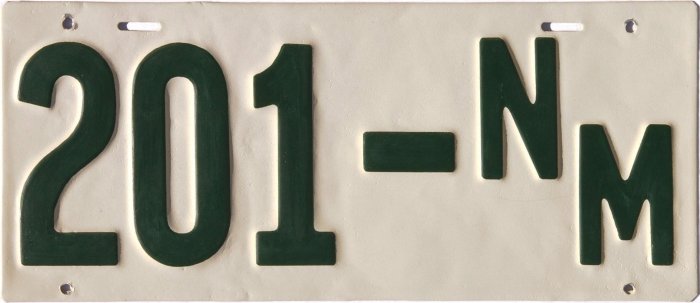
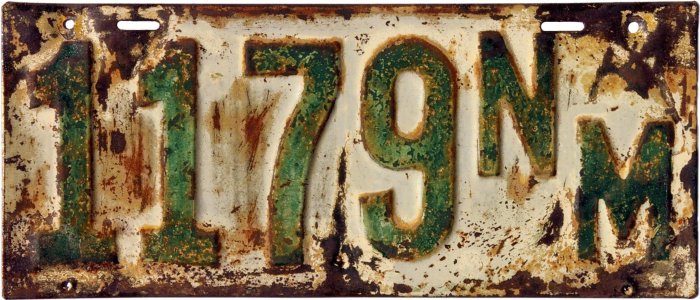 |
| |
| 1912 and 1913 with and without hyphen.
The first-issue plates of 1912 and 1913 with 3-digit serial numbers
(these were issued from September 6, 1912 through March 4, 1913) had a
hyphen separator between the number and the staggered “NM” at the right.
Although no 1-digit or 2-digit 1912 tags are known from either surviving
examples or period photographs, it is considered likely that these
carried the hyphen also. Those plates with four digits (all of which
were issued in 1913) did not have a hyphen. |
| |
| |
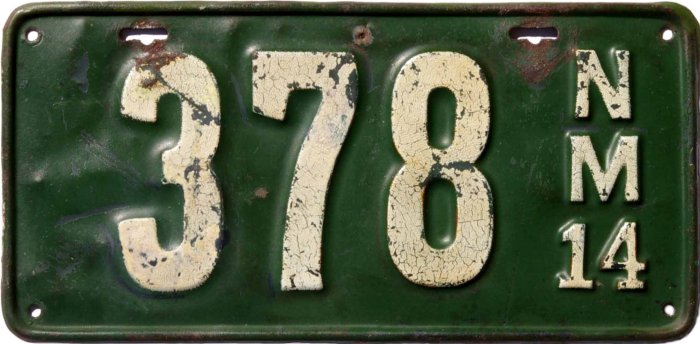
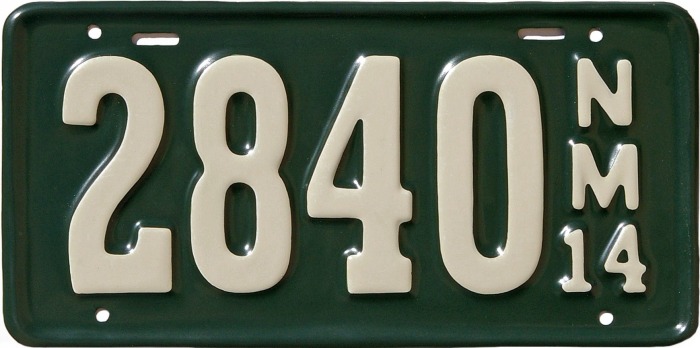 |
| |
| Most known 1914 plates have the four
round bolt holes close to the corners of the plate, as seen in the
example at left. Plate #2840, at right, which was just 250 from the last
plate (#3090) issued in that year, has its corresponding bolt holes
about an inch and a half in from the left and right edges. Until
additional examples are found it will not be known whether this is a
unique example, or if a permanent change was made in the mounting hole
layout late in the production run. |
|
| |
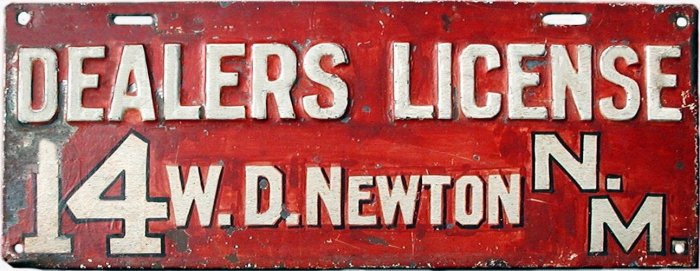
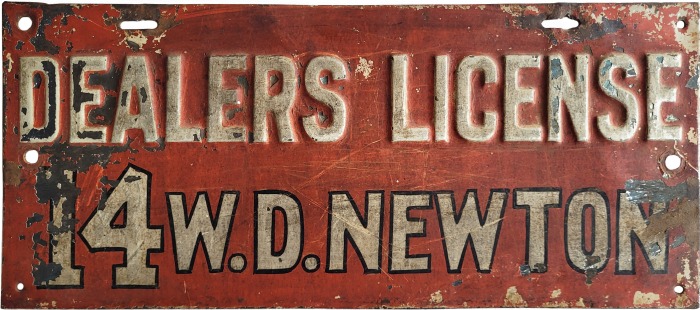
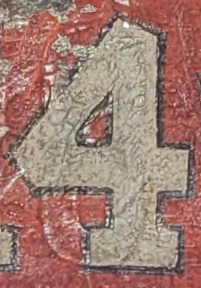 |
| 1915 Willis D.
Newton was the Ford dealer in Las Cruces in the early 20th century,
receiving Dealer License number 3 in 1913, number 28 in 1914, number 14
in 1915, and number 88 in 1916. For 1915 he was issued at least two
plates, both illustrated here. They differ somewhat in size and aspect
ratio, but most strikingly in that one of them has the “N.M.” state name
abbreviation, and the other does not. On these plates the notation
“DEALERS LICENSE” is embossed, and the plates are entirely hand painted.
Curiously, when viewed under just the right light one can see that on
the plate without “N.M.” the “4” has been painted over a different
digit. Plate without “N.M.” courtesy Phil Hill. |
| |
| |
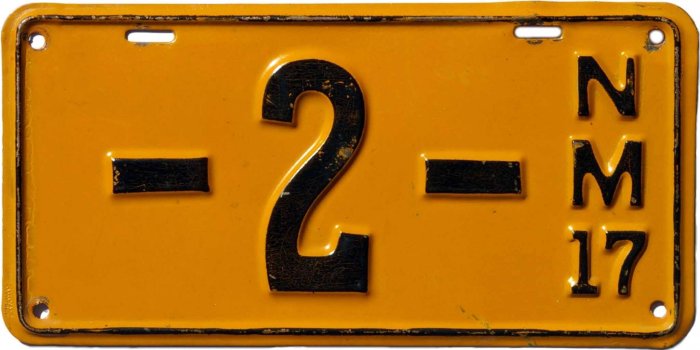
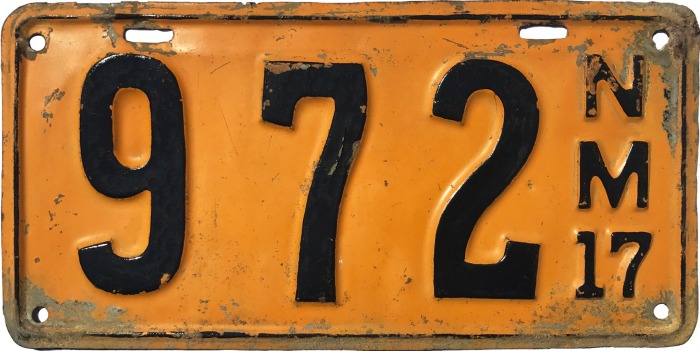 |
| |
| 1916, 1917, 1919 with and without
dashes. Plates from these years with 1-digit serial numbers
have a pair of dashes flanking the numeral, and those from 1919 with two
digits also have a dash on either side of the serial.
The same is probably true for 2-digit tags
from 1916 and 1917, but there are no known surviving examples which
would provide verification.
Three-digit and higher plates have no dashes. |
| |
| |
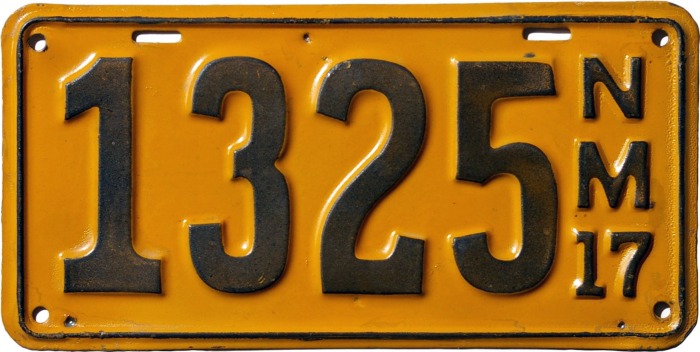
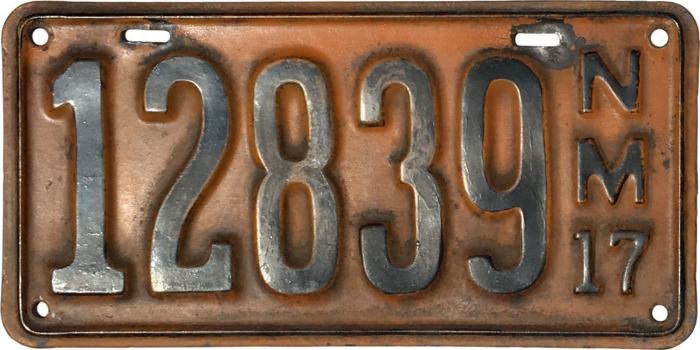
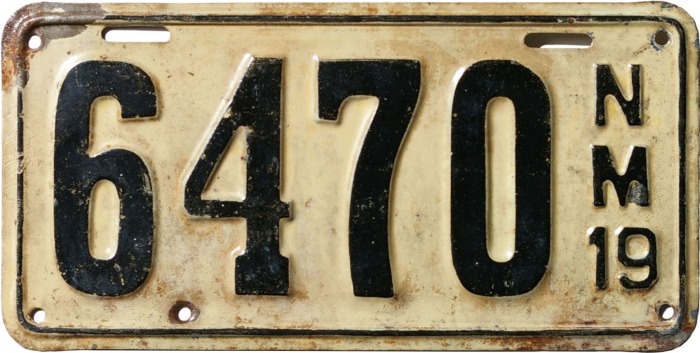
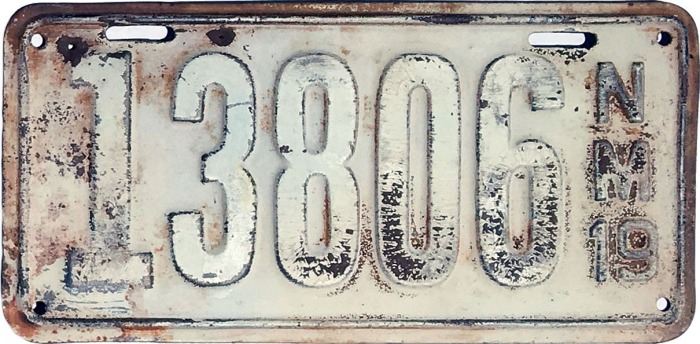 |
| |
|
In both 1917 and 1919, plates with four or
fewer digits (i.e., numbered 9999 and below) were made with wide dies, while those
with five digits, i.e., numbered 10000 and above, were made with narrower dies. |
| |
| |
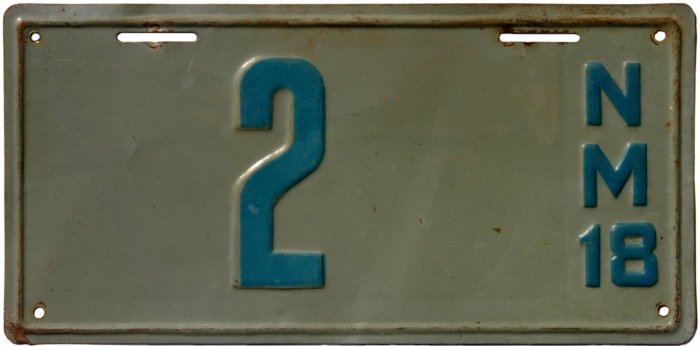
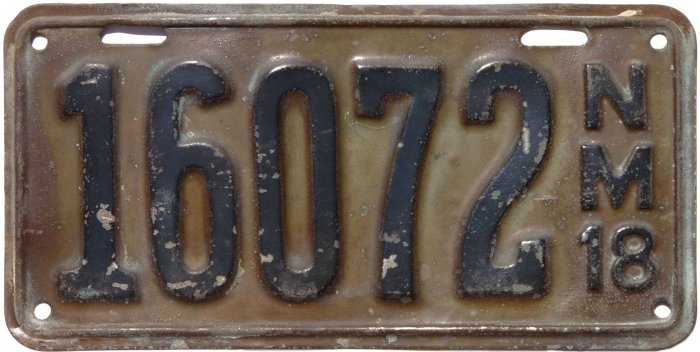 |
| |
|
1918 Passenger Car plates were
issued in both “thin” and “thick” varieties, the first type being
numbered from 1 through about 14000, and the second type from 14001
through about 19000. The colors are noticeably different between the two
varieties, also.
Curiously, there a few plates known in the
13000 series which are of the thick type, at least some of which have
serial numbers which overlap into the known serial number range of thin
plates. No satisfactory explanation has been found for this puzzling
anomaly. |
|
|
|
|
|
|
| |
| Major Porcelain Varieties. New
Mexico issued porcelains in three major varieties: (1) The first of
these are numbered from 1 to approximately 22000, had the blue “1920”
date baked into the porcelain itself, and had three small rivet holes
surrounding the date. These were issued in 1920 and could be renewed in
the subsequent three years with small dated seals (tabs) that covered
the “1920” and were attached with rivets pushed through the three small
holes. (2) Since there was no need for the “1920” after the initial year
of issue, it was omitted on those issued in the later years (i.e., those
numbered above about 22000) but the three rivet holes were retained for
attachment of the dated seals. These constituted the second major
variety. (3) In the latter part of 1923 the decision had been made to
return to traditional embossed steel plates in 1924, which meant that
there would be no 1924 seals issued for the porcelains. That being the
case, when the last batch of porcelain plates was manufactured in 1923
(numbered from approximately 47501 to 49000) even the rivet holes were
omitted, thereby creating the third major variety. |
| |
| |

 |
| |
| Uncommon Porcelain
Varieties. Aside from the three major varieties described
above, one occasionally finds individual porcelain plates that do not
conform to the aforementioned three categories, or in some way are
distinct from most others. Two such examples are shown here, plate
numbers 13499 and 14091. Both of these are well within the first 22000
plates that had the blue “1920” date, and should be so dated themselves,
but are not. This could have resulted from an error during manufacture
of the tags, or more likely, they were one-off replacements manufactured
at a later date for lost or damaged plates. Evidence in favor of the
latter possibility is the fact that there are several anomalies
suggesting that the 14091 plate was not made during the original
production run. These include differences in widths of the first and
last numeral “1” and differences in widths of the left and right legs of
both the “N” and “M.” There are a few other plates from this series,
with widely differing plate numbers, also known to be missing the “1920”
date. |
| |
| |
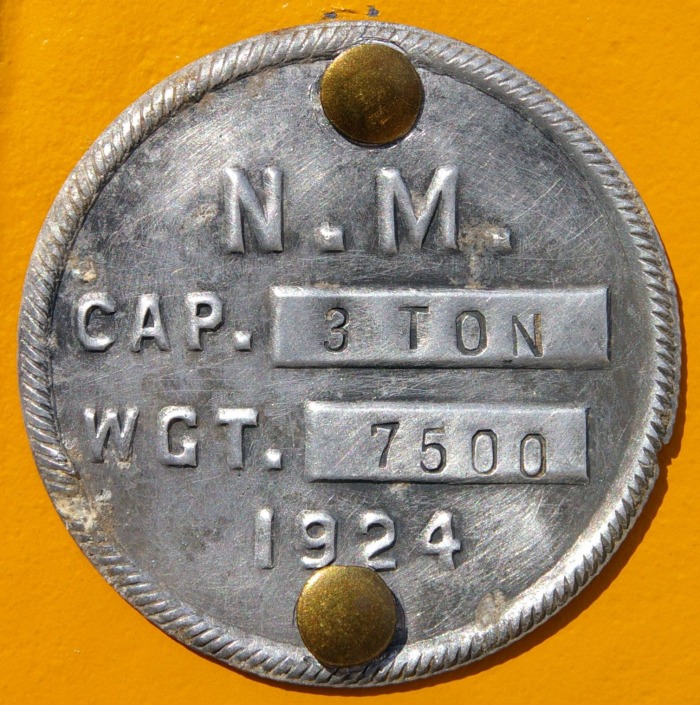
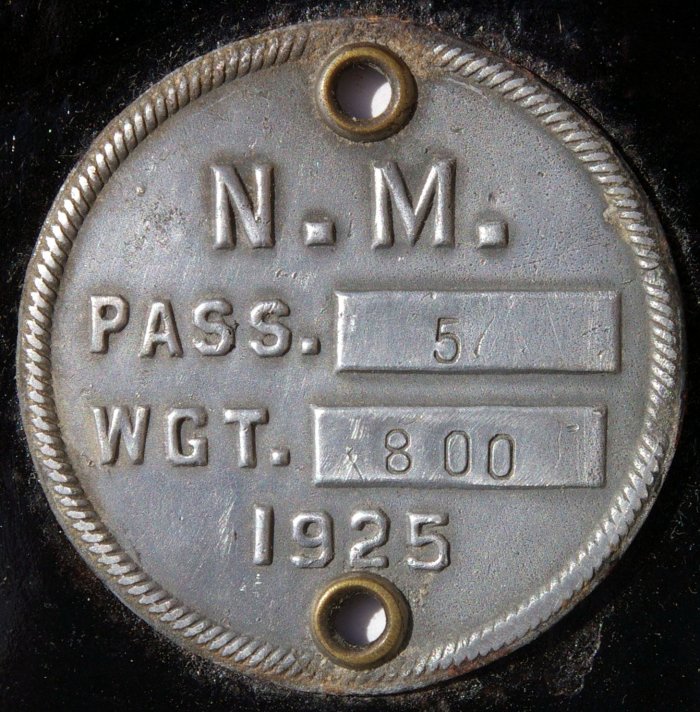
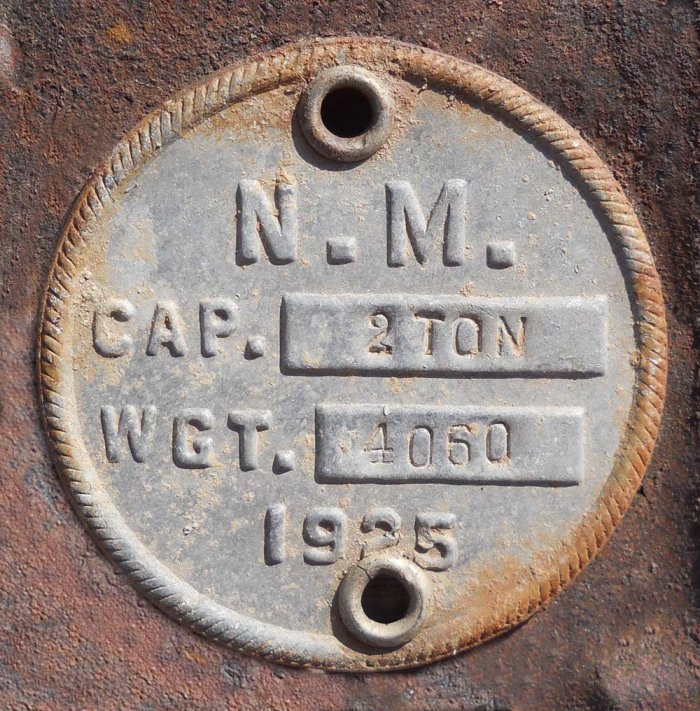
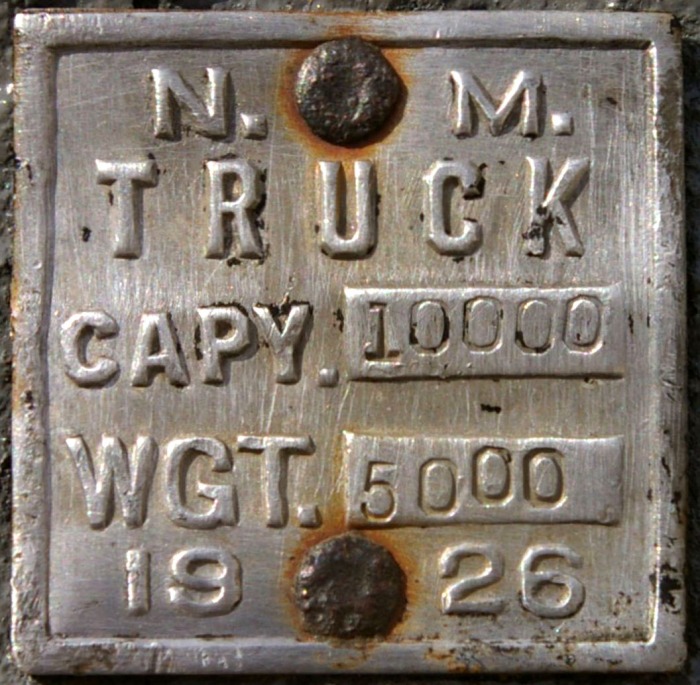
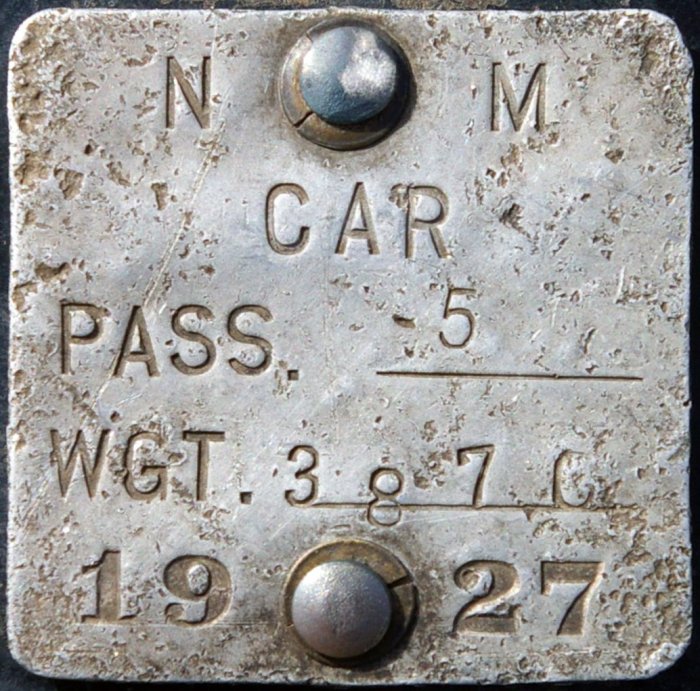 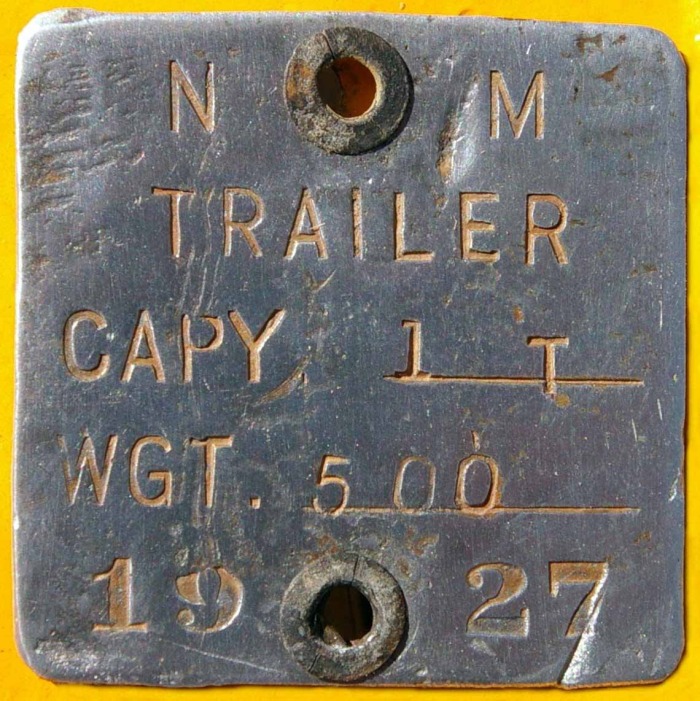
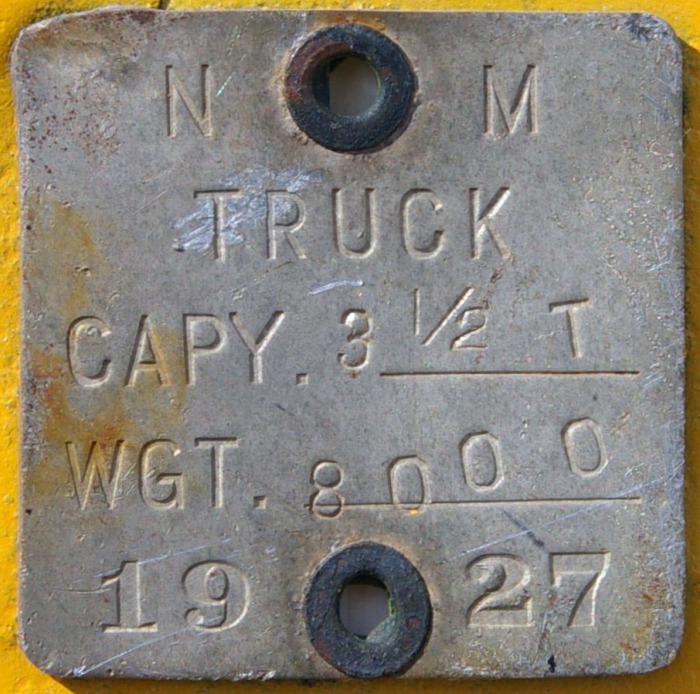
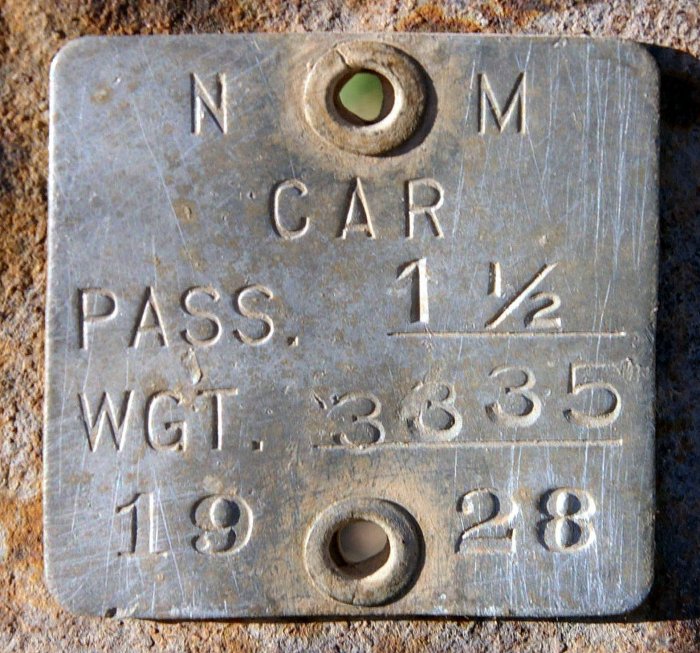
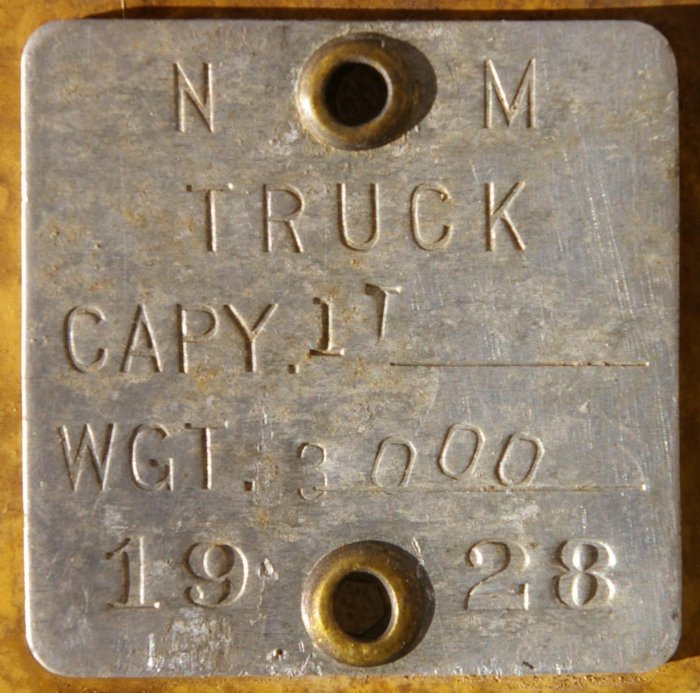
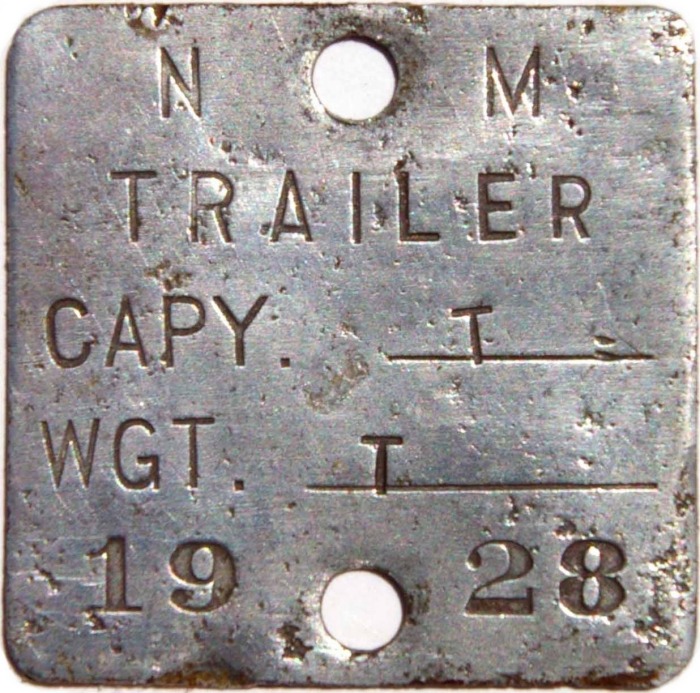 |
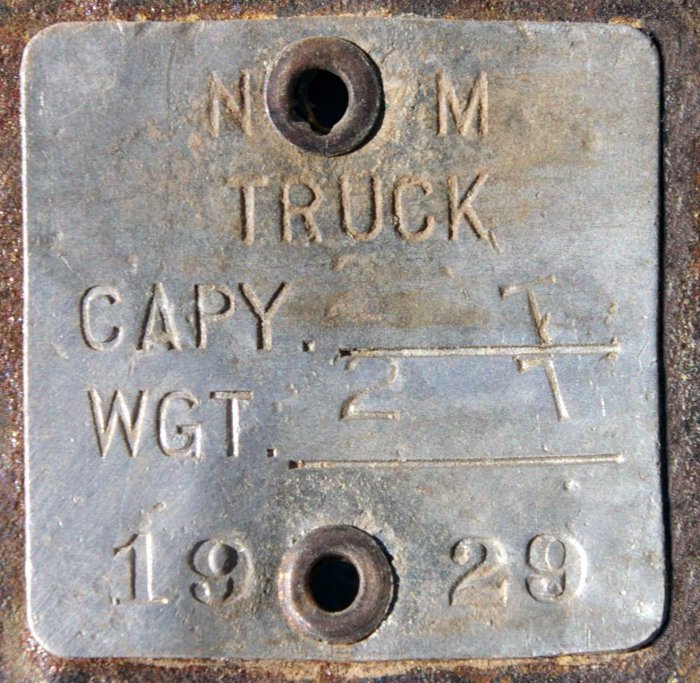
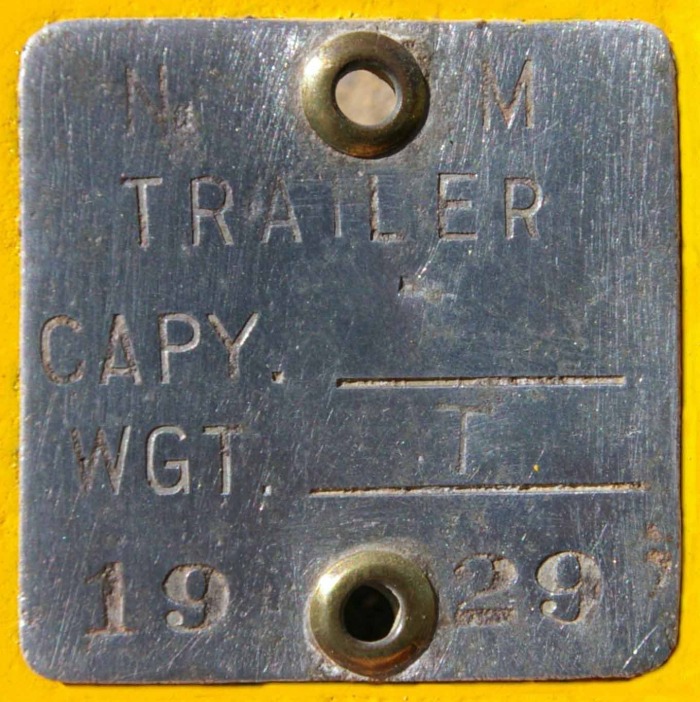
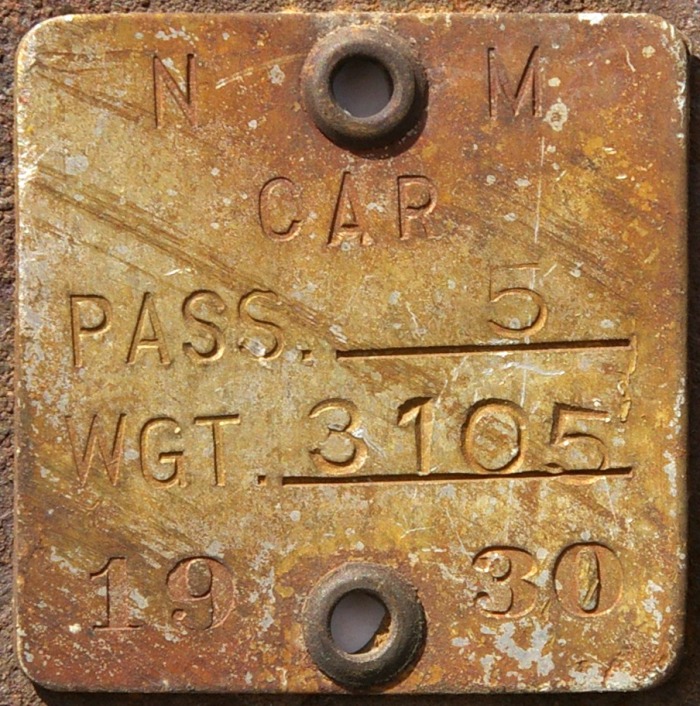
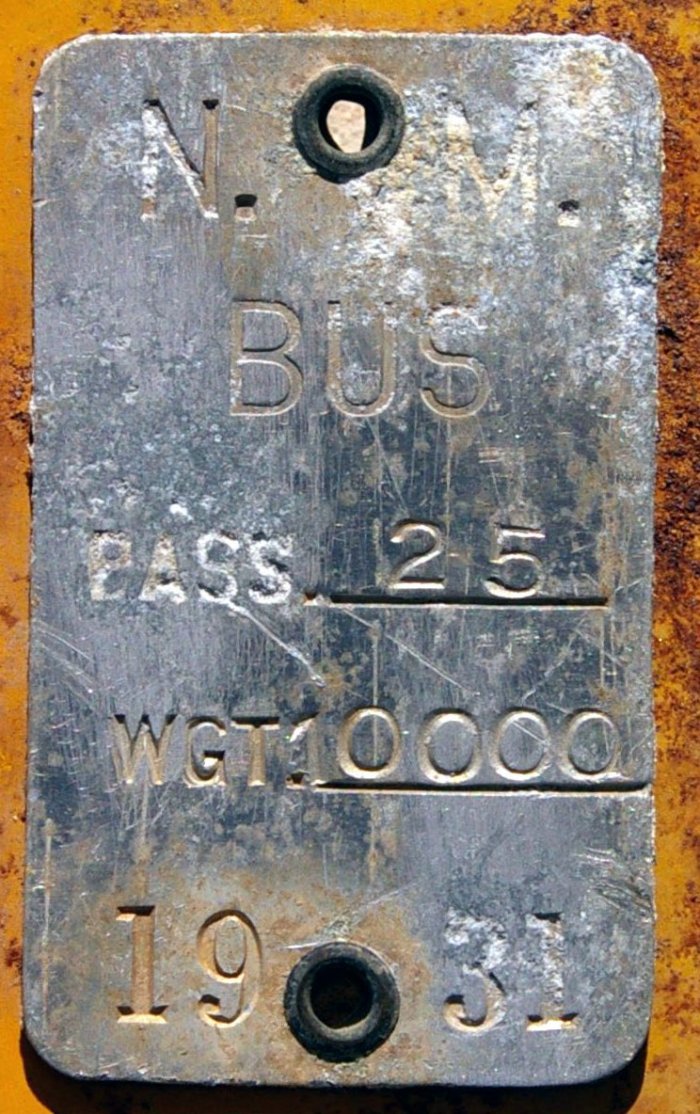
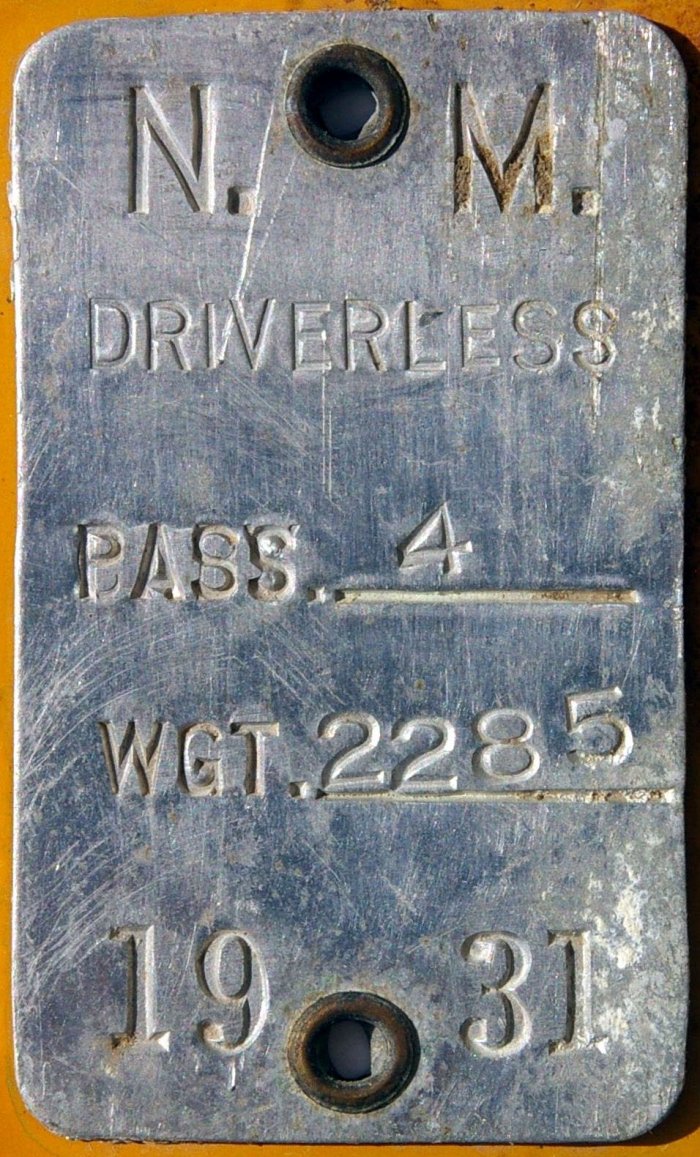 .JPG)
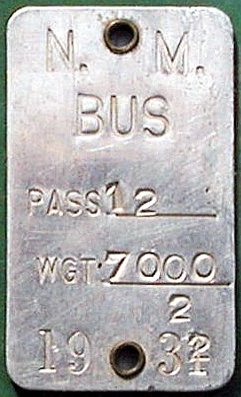
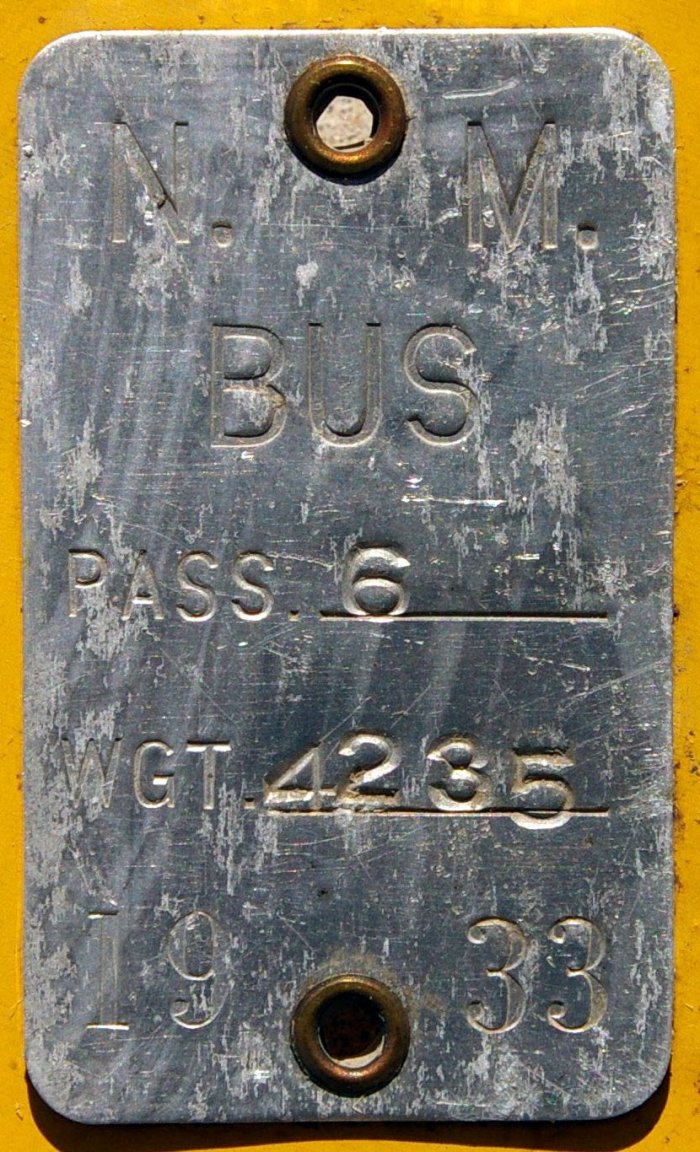
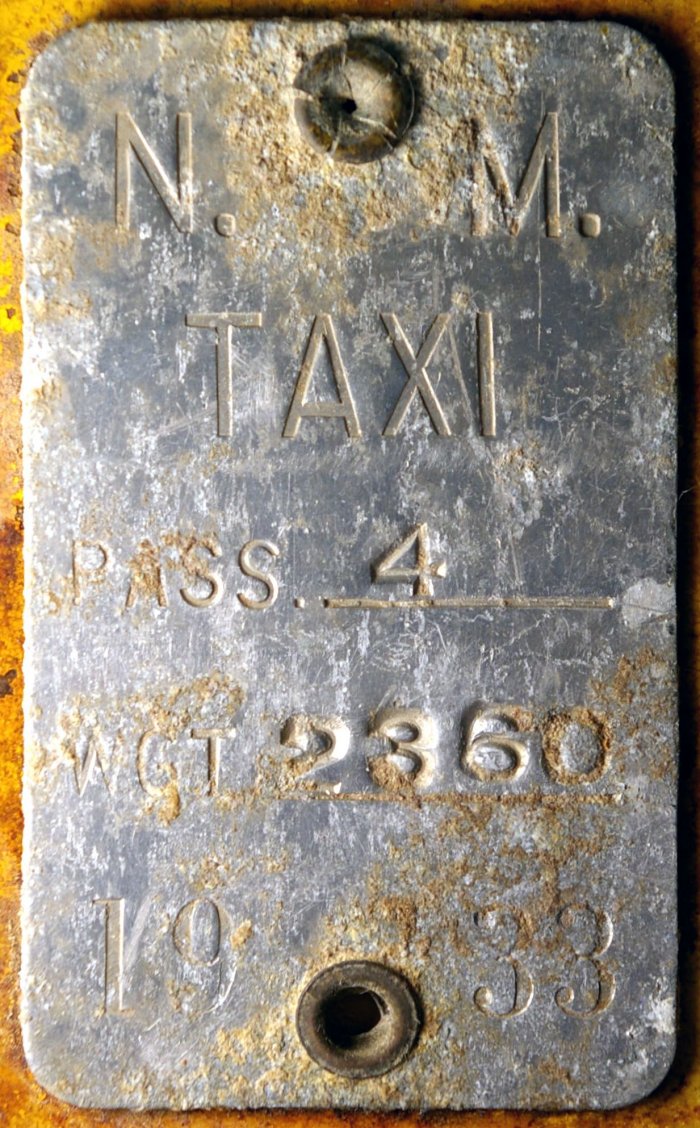
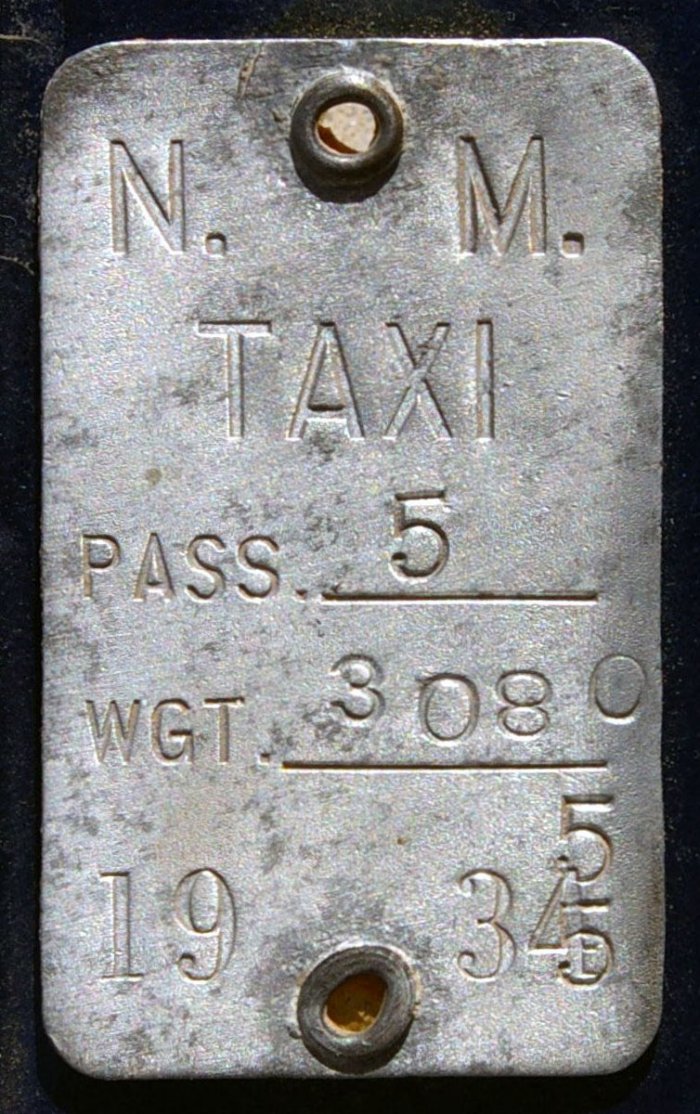 |
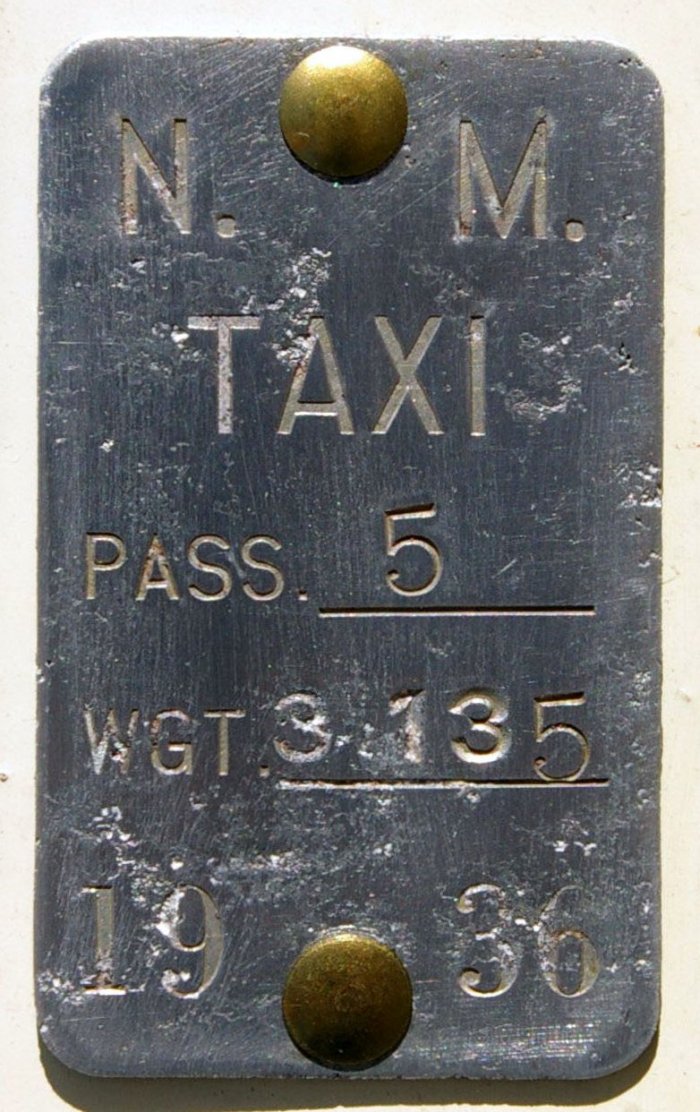
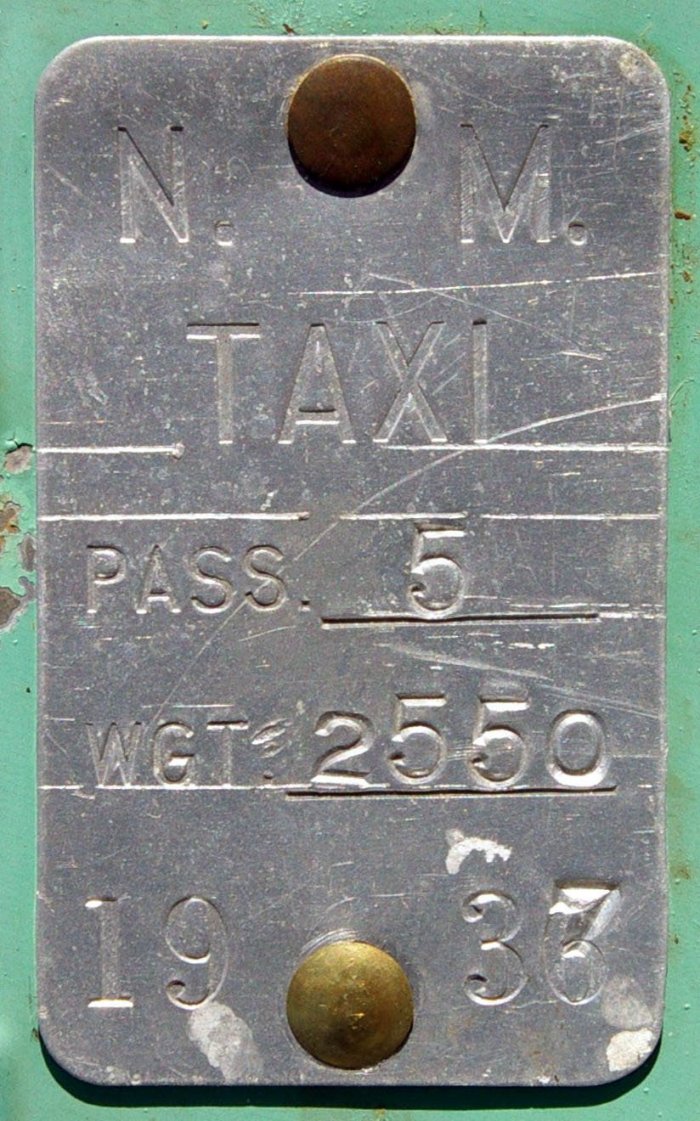
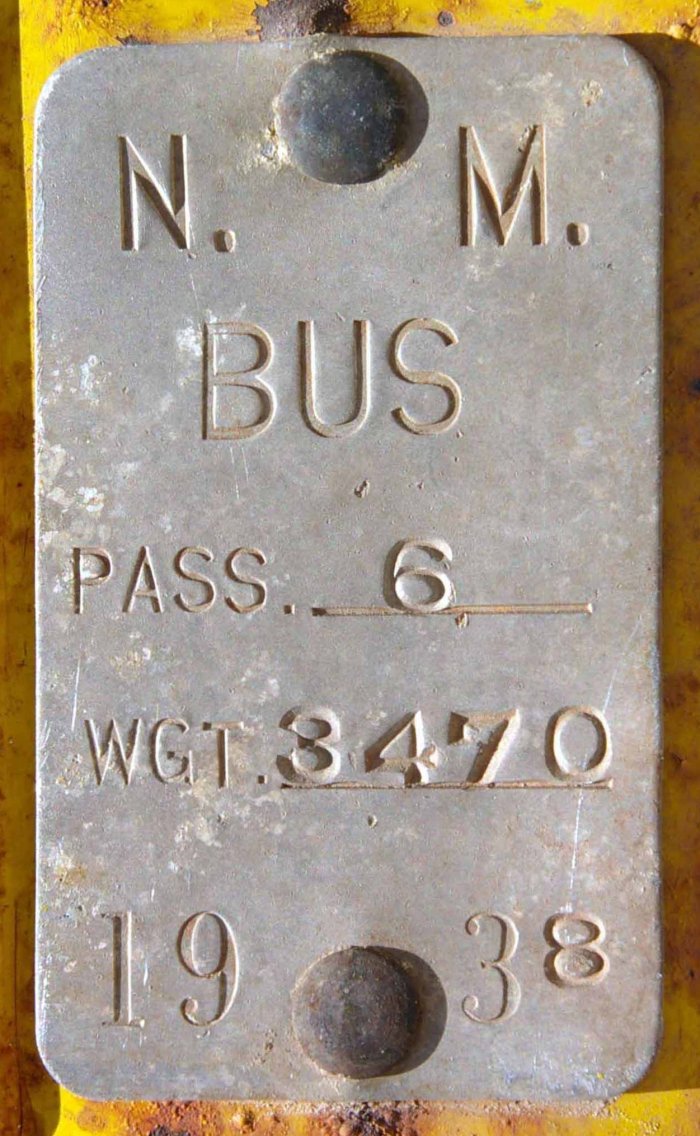
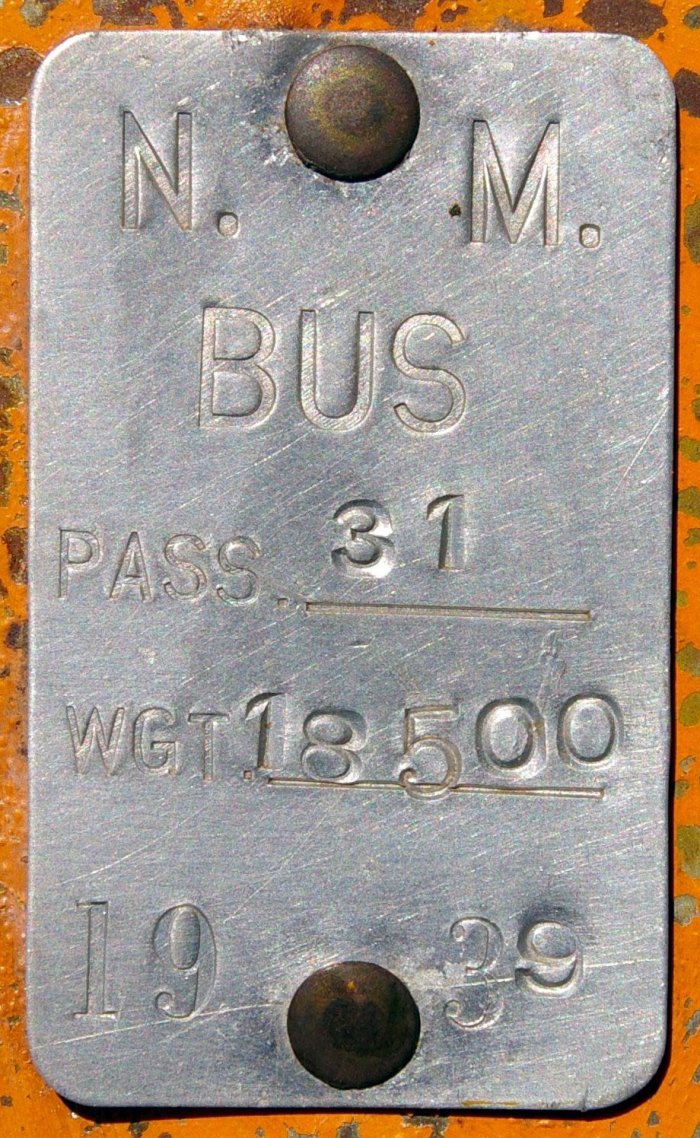
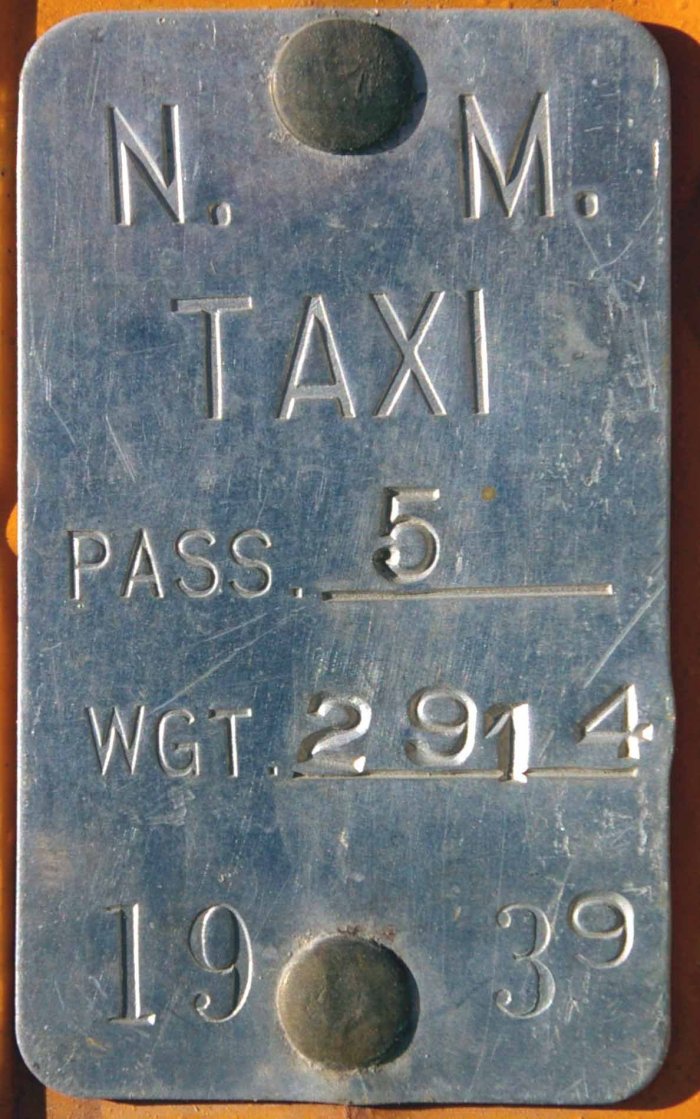
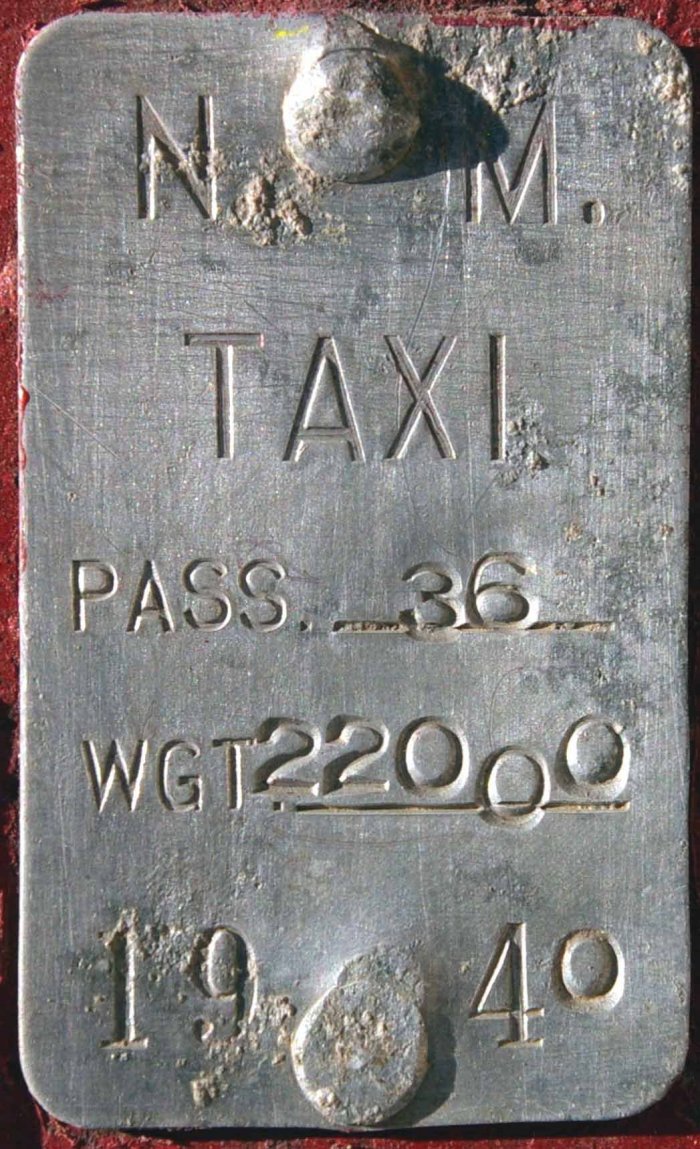
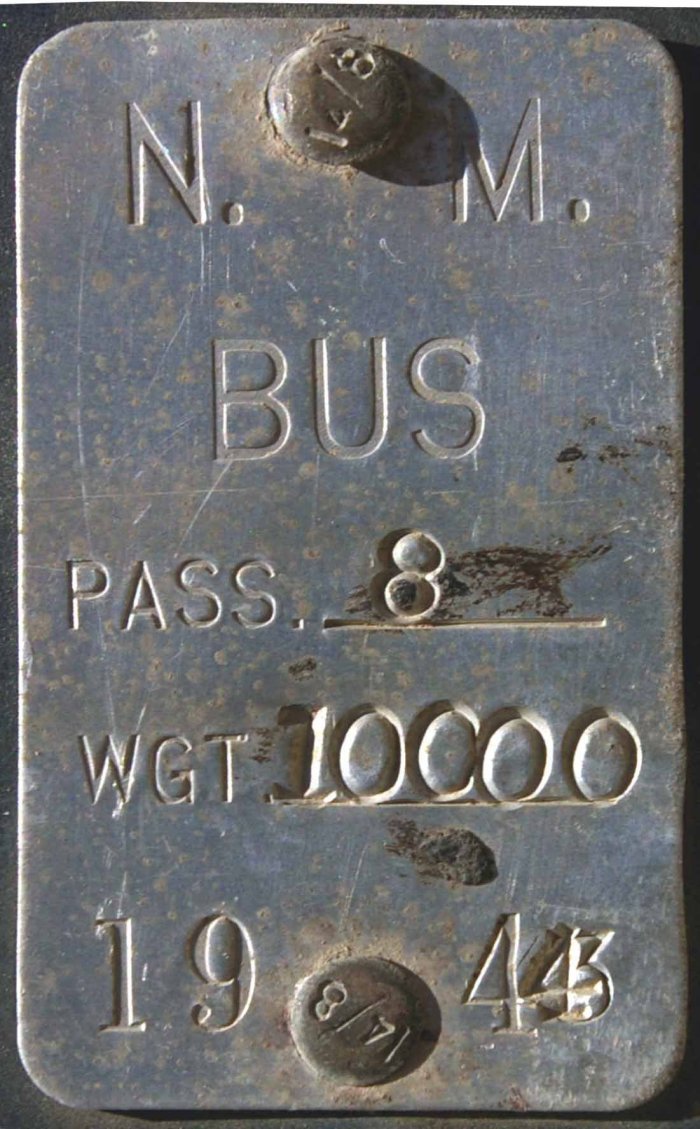
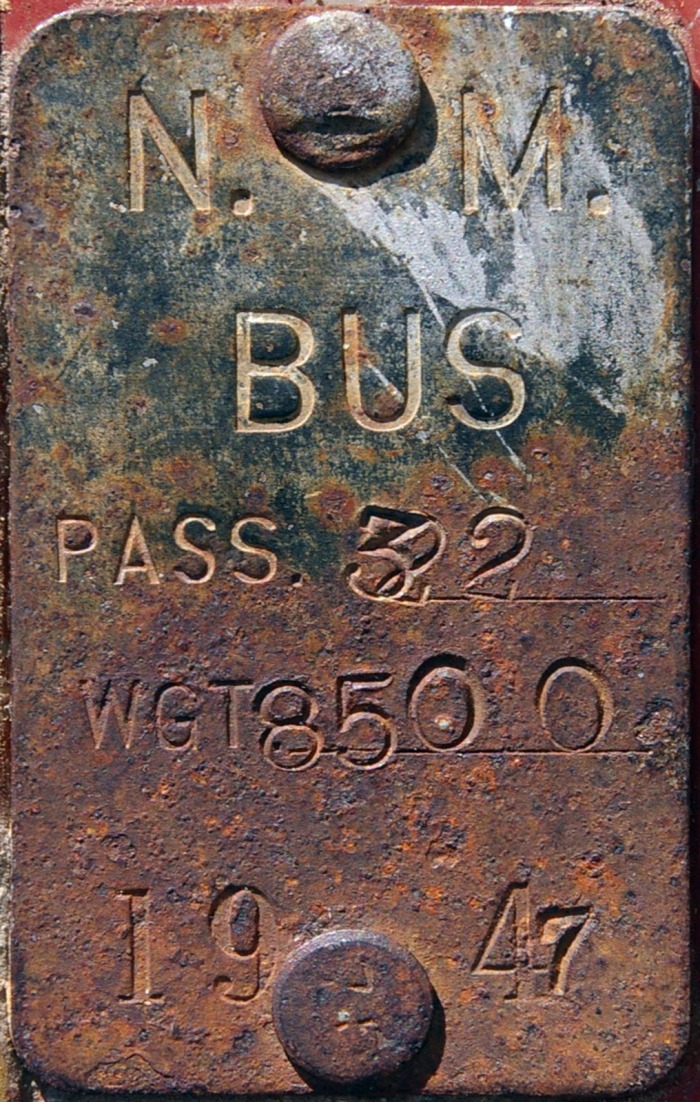
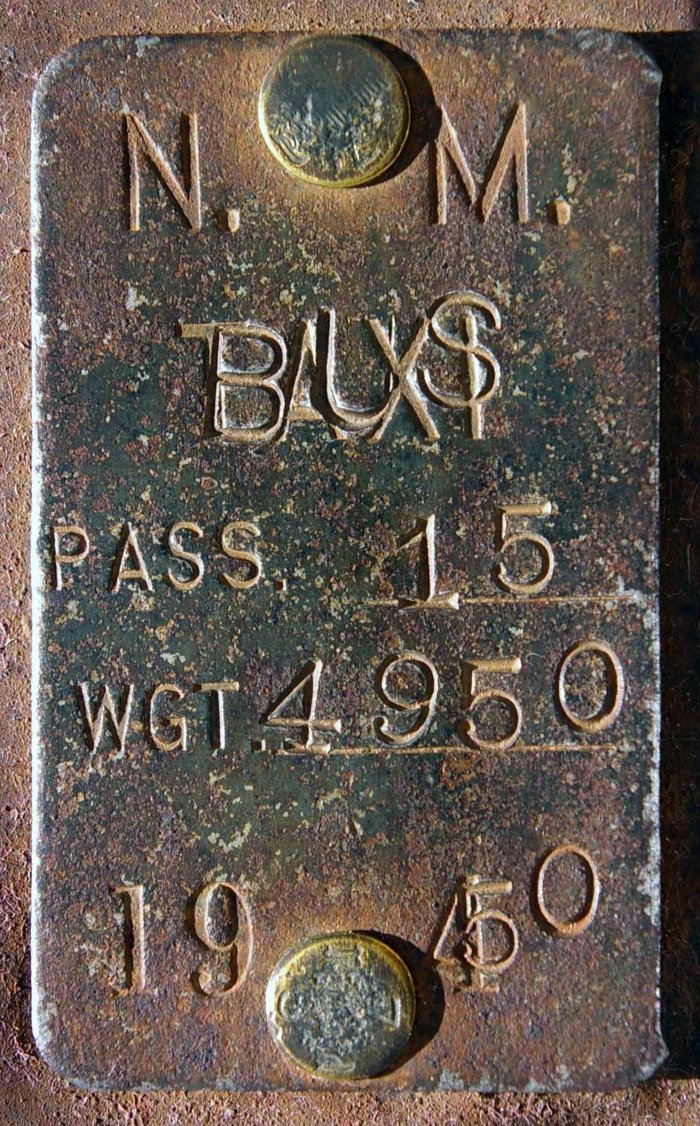
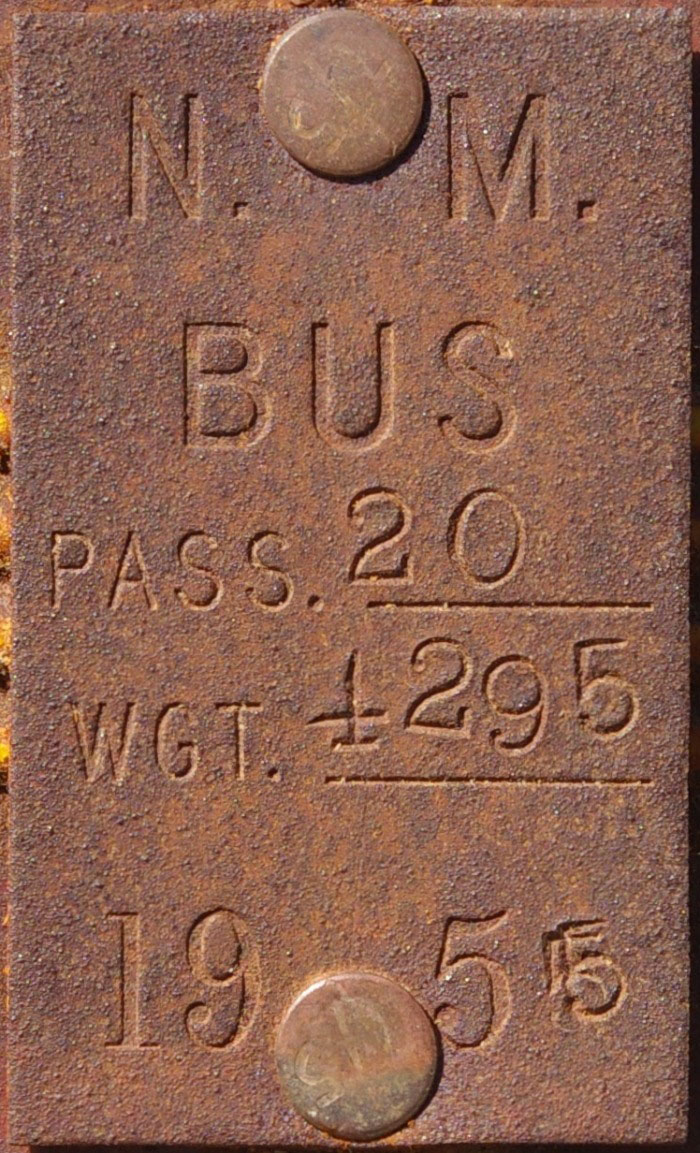 |
| |
1924–1955 Weight/Capacity
Seals. New Mexico’s first license plates bearing designations
which identified them as being for commercial vehicles came about as a
result of the Laws of 1923, Chapter 96. This law introduced
higher registration fees for vehicles in commercial service and required
the use of these special plates beginning July 1, 1923. The same
legislation stipulated that beginning with 1924 registrations, plates
would also show the weight and carrying capacity of the vehicles. The
latter requirement was accomplished through the attachment of small
metal seals—commonly called “tabs” today. Aside from the fact that the
weight and capacity figures were specific to each vehicle (and
hand-stamped in every case), the seals themselves were made in several
different styles over the years. The following is a summary of the major
known varieties, and there may be others which have not yet been
documented:
|
|
|
1924-1925
1926
1927-1930
1931-1944
1947
1950
1955 |
Round aluminum disc with embossed characters
and embossed reeded rim, 2" in diameter.
Aluminum, 1½" x 1½" square with embossed characters and plain embossed
rim. Corners are square.
Flat aluminum square, 1½" x 1½", with rounded corners and stamped
characters.
Flat aluminum rectangle, 2½" x 1½", with rounded corners and stamped
characters.
Flat steel rectangle, 2½" x 1½", with rounded corners and stamped
characters.
Flat steel rectangle, 2½" x 1½", with rounded corners and stamped
characters.
Flat steel rectangle, 2½" x 1½", with square corners and stamped
characters. |
|
| |
| |
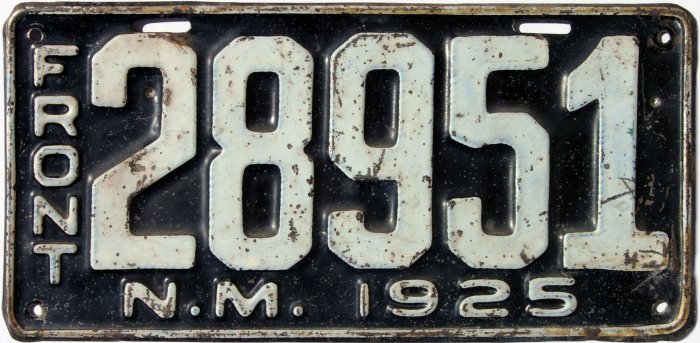
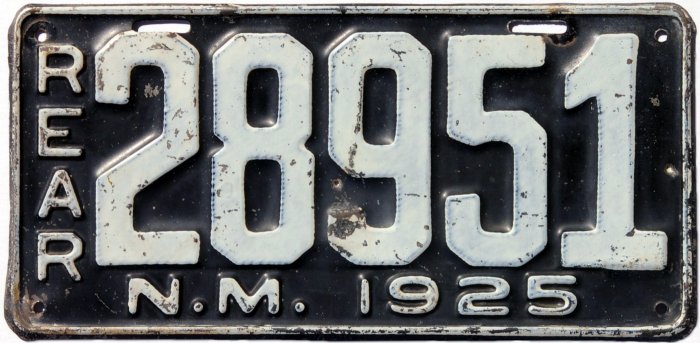 |
| |
|
1925 Passenger Car plates came
out during a period when two plates were issued to each vehicle, for use
on the front and rear. In this one year only, the two plates of the pair
were embossed “FRONT” and “REAR.” This was to keep people who owned two
cars from registering only one car and putting one plate on each car to
evade registration fees. |
| |
|
.JPG)
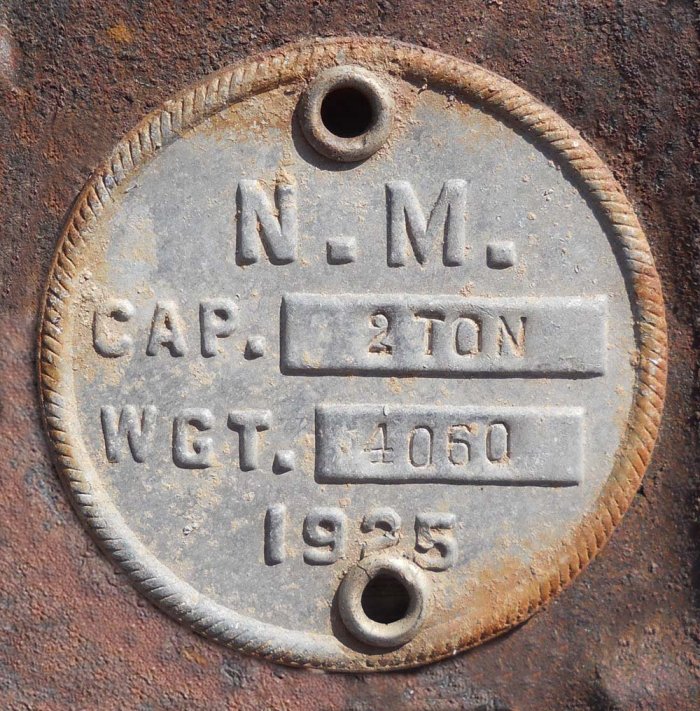 |
| |
| 1925 Commercial Truck Seals
were issued in two distinct varieties: those with the weight and
capacity figures pre-embossed at the factory, and others hand-stamped at
the time of issue. It is surmised that the manufacturer (Grimm Stamp &
Badge Co. of St. Louis) provided a quantity of pre-embossed seals for
common weight/capacity combinations, plus additional seals left blank to
be hand-stamped upon issuance of the plates. |
| |
| |
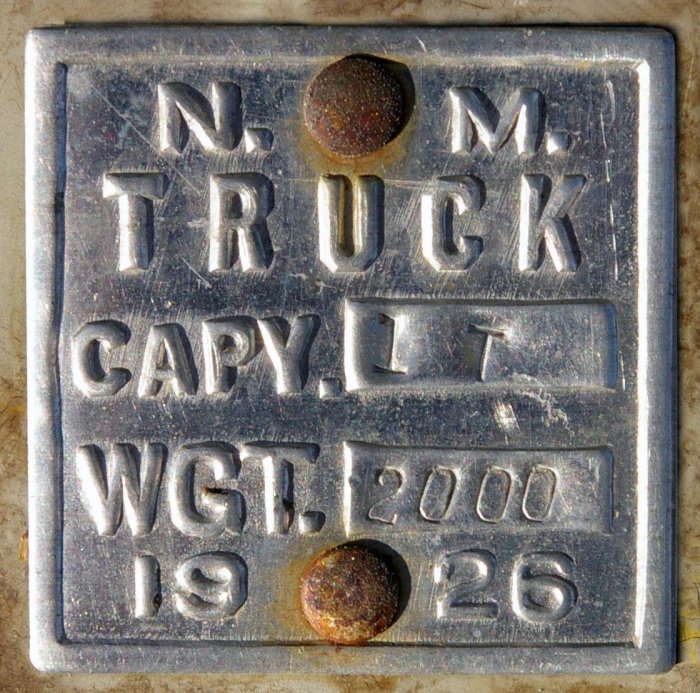
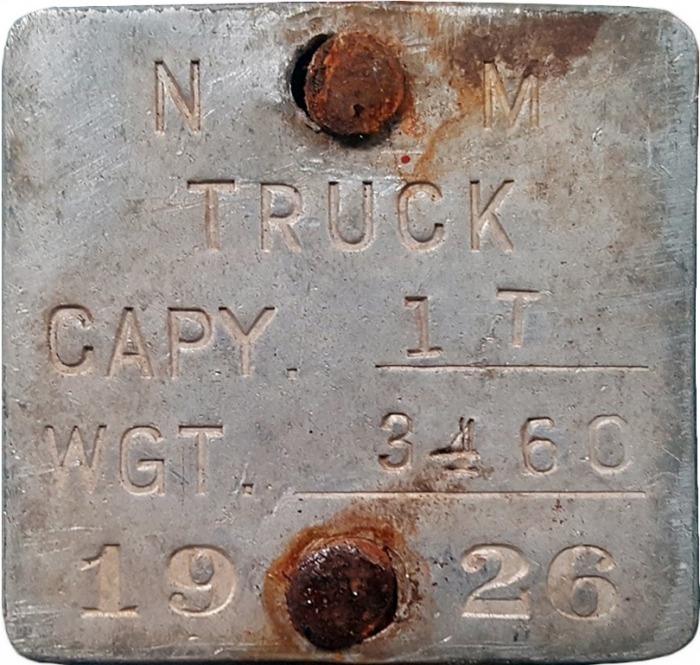 |
| |
| New Mexico’s 1926
plates were manufactured at the Oklahoma State Penitentiary, the only
year the state’s plates came from that source. This not only accounts
for the unusual shape of the 1926 plates (which was similar to those
used by Oklahoma during this time period), but also the one-year-only
square embossed seals found on most Commercial and Motor Truck plates
for 1926. An example of this style of seal is seen at left, above. The
1927-1933 (except 1932) plates were made by the Gopher Stamp and
Manufacturing Company of St. Paul, Minnesota. All of the seals on
commercial plates during those years were also supplied by the Gopher
Co., and were stamped, not embossed. The 1926 seal seen at right is
clearly of the stamped style provided by the Gopher company 1927-1933.
As this seal is on a plate whose serial number shows that it was issued
in the latter part of 1926, and as the Gopher company began
manufacturing the 1927 plates in the latter part of 1926, it appears
virtually certain that the stamped seal shown above was manufactured by
Gopher, either as an original seal for late issued 1926 plates, or as a
replacement for a seal lost during late 1926. |
| |
| |
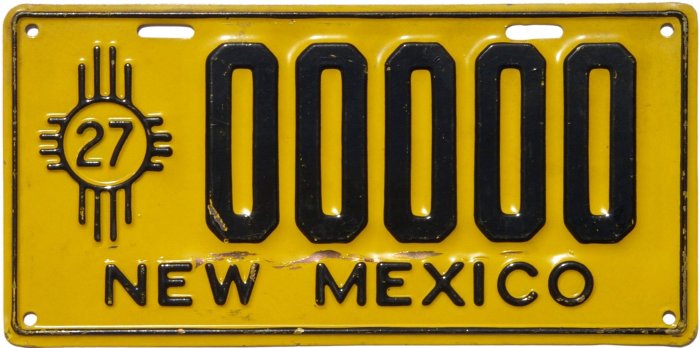
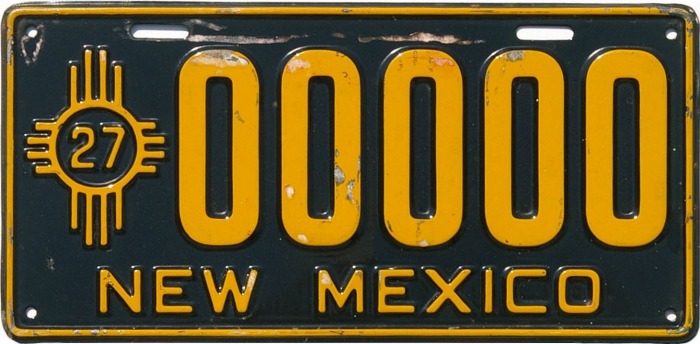 |
| |
| 1927 Sample plates had black
characters on a yellow background but this example has the colors
reversed and makes use of slightly different dies in the serial number.
And unlike other sample and regular issue plates, which were yellow on
both sides, the reverse side of this plate was originally grey/olive
drab. A possible explanation is that it may have been a prototype
plate produced by a company bidding on the contract to supply plates for
1927. |
| |
| |
.JPG)
.JPG) |
| |
| 1929 Commercial plates
with 4-digit serial numbers are known to exist both with and without a
hyphen. |
| |
| |
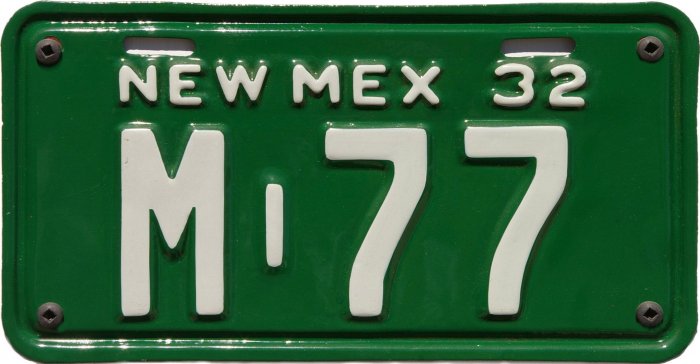
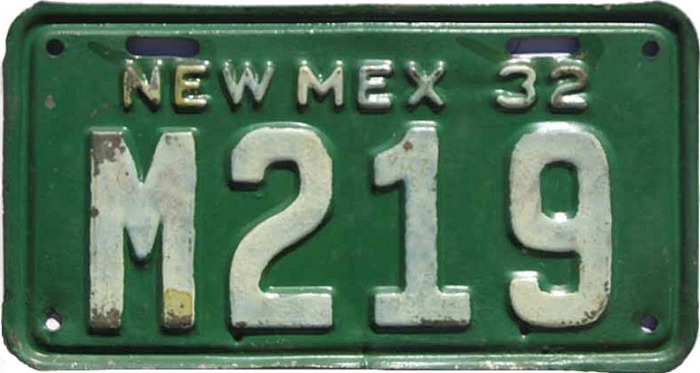 |
| |
| 1932 Motorcycle.
These plates were made both with and without a separator between the “M”
and the serial number. No doubt there was simply no room to have one on
the 3-digit and higher numbers. |
| |
| |
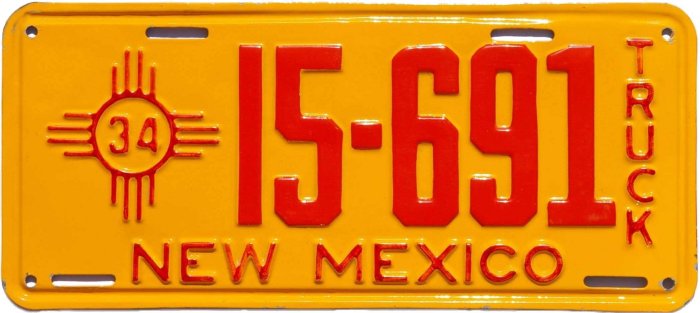 |
| |
| Two different die styles were used
for the numeral "1" on 1934 Truck plates, sometimes
with both styles appearing on the same plate, as in the example
illustrated here. See below for the same variation appearing on 1938,
1947 and 1950 Truck plates. |
| |
| |
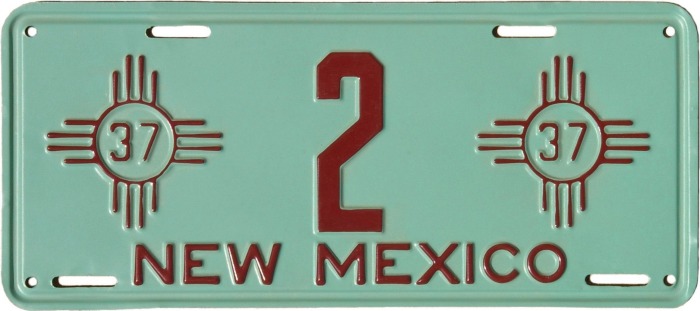
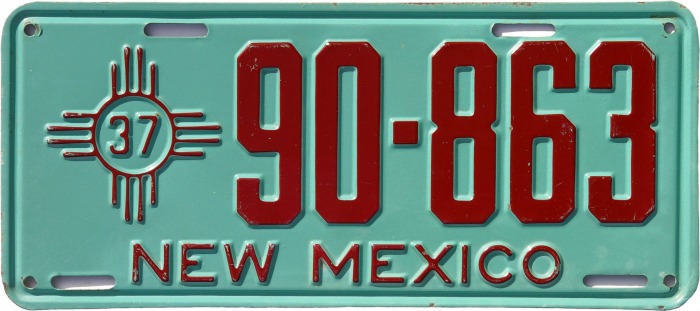 |
| |
|
Double Zia and Single Zia Plates.
During the years 1932 through 1946 Passenger car and Truck plates were
issued with double Zias for tags numbered 999 and lower, and with single
Zias for those numbered 1000 and higher. Certain non-passenger plates
were made in double Zia format as early as 1928. Please see the
Double Zias page for many more examples of
these attractive plates. |
| |
| |
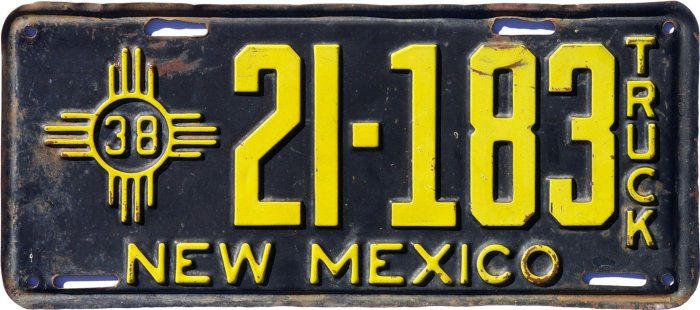 |
| |
|
Two
different die styles were used for the numeral "1" on
1938 Truck plates,
sometimes with both styles appearing on the same plate, as in the
example illustrated here. See below for the same variation
appearing on 1947 and 1950 Truck plates. |
| |
| |
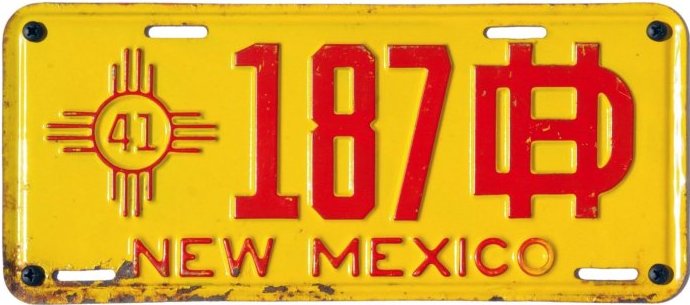
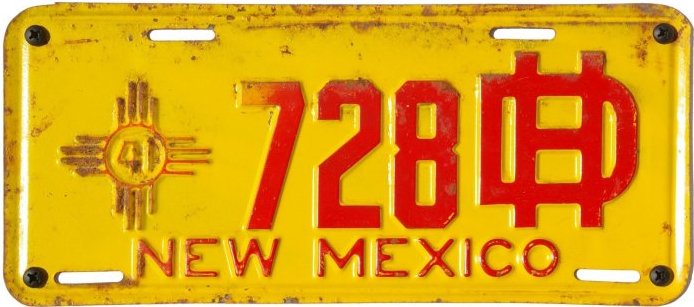 |
| |
| 1941 Highway Department. Two
different styles of dies—tall and short—were used for Highway Department
plates in 1941. It's possible that shorter dies were introduced in
anticipation of adding “The Land of Enchantment” slogan as had been done
on Passenger plates in this year, but no evidence has been found to
either support or refute this hypothesis. In any case it was not until
1951 that the state's slogan first appeared on HD tags. Note that
the plate with the short dies also has a smaller zia symbol, with the
two different sizes of zia on these plates corresponding in size to
those on the two varieties of 1941 Trailer plate described below. |
| |
| |
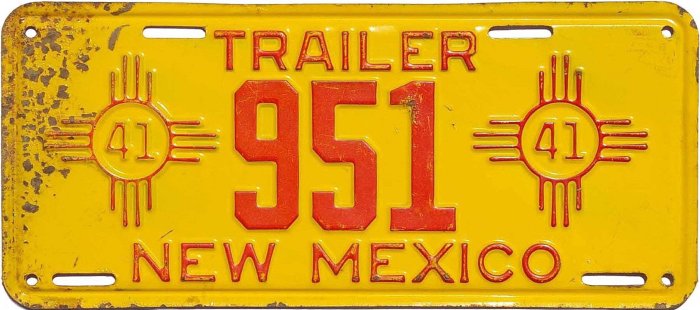
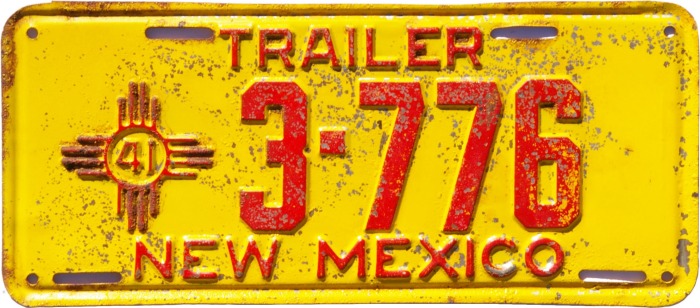 |
| |
|
1941 Trailer.
Two varieties were manufactured for this year of Trailer plate, one with
a large zia and the other with a small zia. The central circle of the
larger one measures roughly 1½" in diameter while the smaller one
measures about 1⅛". Anecdotal evidence suggests that the larger size
was used only on double zia plates, with the smaller size appearing on
single zia tags, though this has not yet been positively verified. |
| |
| |
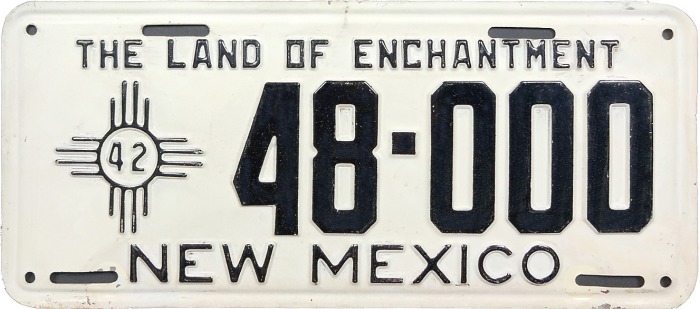
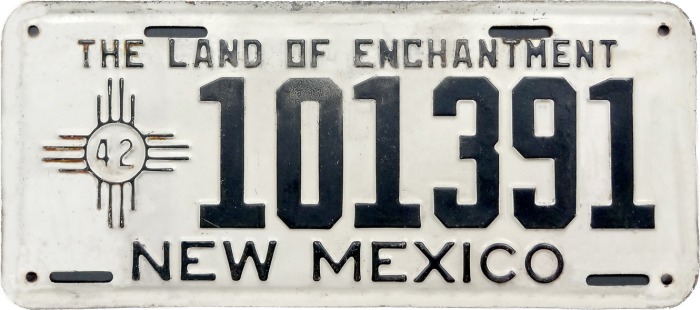 |
| |
| 1942 Passenger Plates with and without
hyphen. From 1927 to 1942 Passenger Car plates numbered 1000 or
higher had a hyphen (or zia, in 1932) separator preceding the last three
digits. In 1942, there were plates made for the first time with serial
numbers 100000 and higher, which left no room for a hyphen.
Consequently, these highest numbered plates in 1942 differed from all
other 1000 and higher 1927-1942 tags by having no hyphen. |
| |
| |
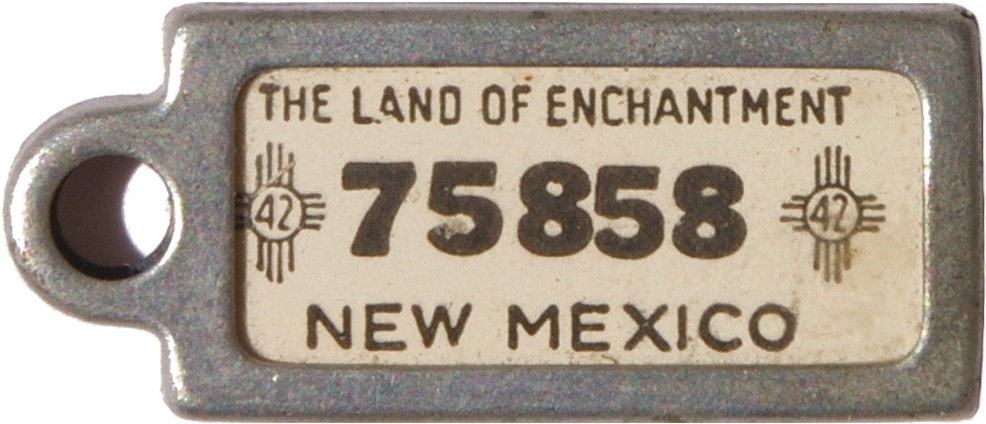
.JPG) |
| |
| 1942 DAV key chain tags
were made in two varieties, with a plastic frame and a metal frame. |
| |
| |
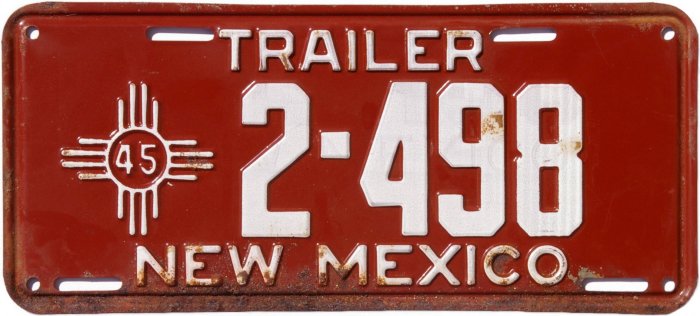
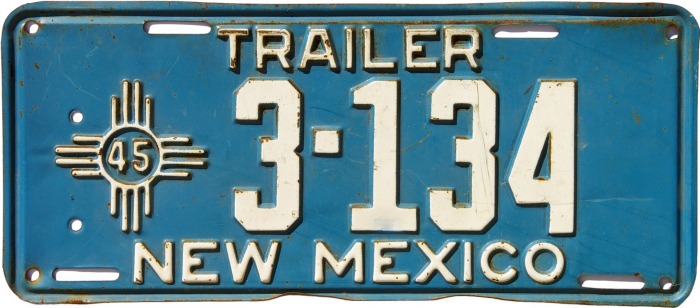 |
| |
|
1945 Trailer plates were mostly
in white-on-reddish-brown colors, but a few were made in white-on-blue
colors of car plates. Some (but not all) of the white-on-blue
plates were made with blanks that had holes pre-punched for attachment
of weight/capacity seals (tabs), as is the case for the one illustrated
here. This may have been the result of using up leftover blanks that had
been prepared for C-prefix Commercial plates,
or it could have just been an error. |
| |
| |
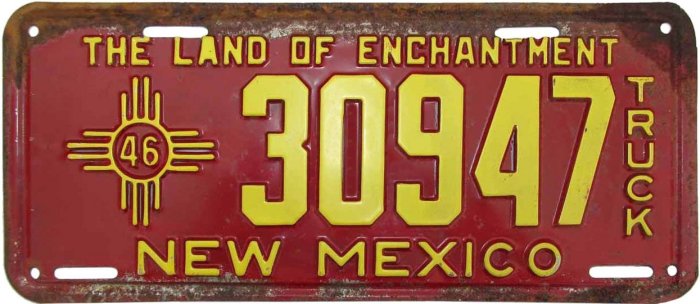
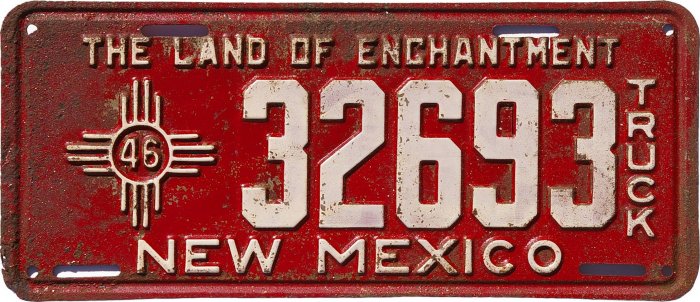 |
| |
|
1946 Truck plates normally had
a red background and yellow characters, but on this unusual
late-production example the
characters are white. |
| |
| |
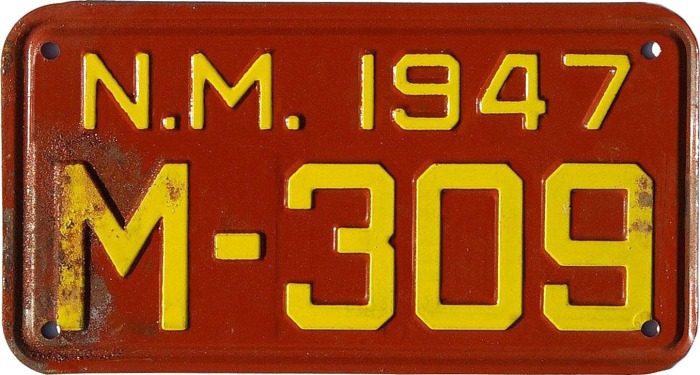
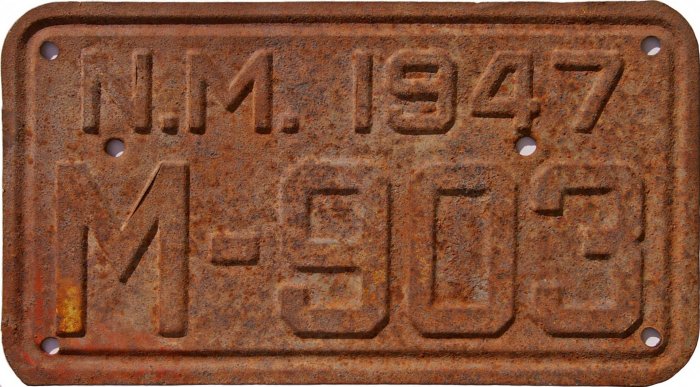
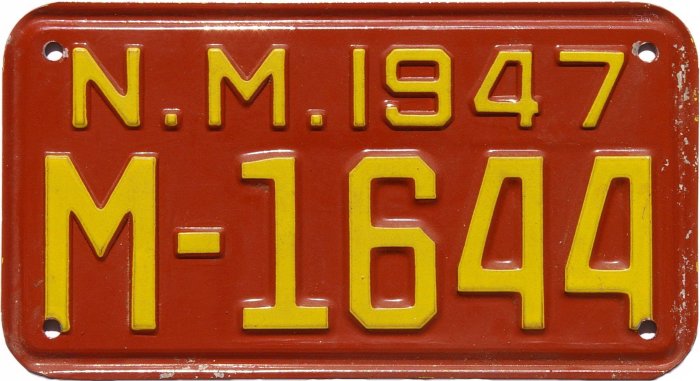 |
| |
|
1947 Motorcycle plates. Motorcycle registrations
reached 1,000 for the first time during 1947, and to make room for the
extra serial number digit the dies were made narrower when this
happened. The “M” was reduced in width from 1½" to 1¼" wide and the
numerals were reduced from 1¼" to 1". And, for reasons not known,
the “N” and the “M” of the state abbreviation were spaced farther apart
at the same time. The narrower dies continued in use through 1958,
but the closer spacing of the “N” and the “M” was reinstated during the
1955 production run. Additionally, all known 1947 motorcycle
plates numbered M-999 and below are made of steel, and all of those
numbered M-1000 and above are made of aluminum. The result is that
there are two very distinct varieties of Motorcycle plates for this
year: Steel plates with wide dies, and aluminum plates with narrow dies. |
| |
| |
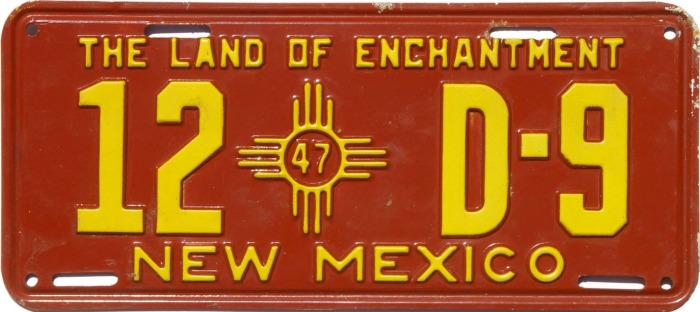
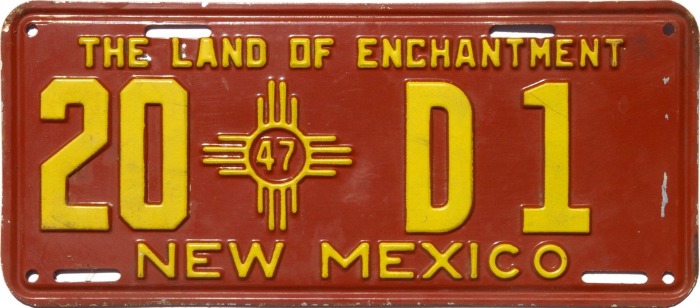
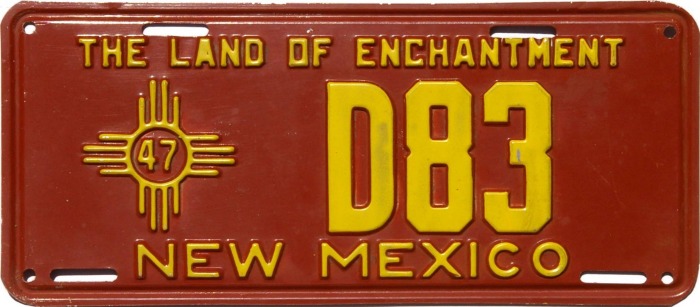 |
| |
|
1947 Dealer. At least three
varieties of 1947 Dealer plates are known, two of which have a county
prefix, and one of which does not. |
|
| |
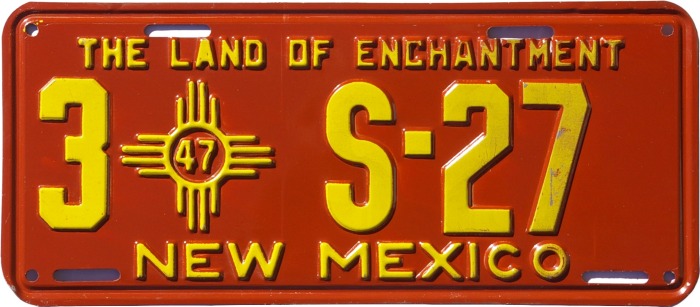
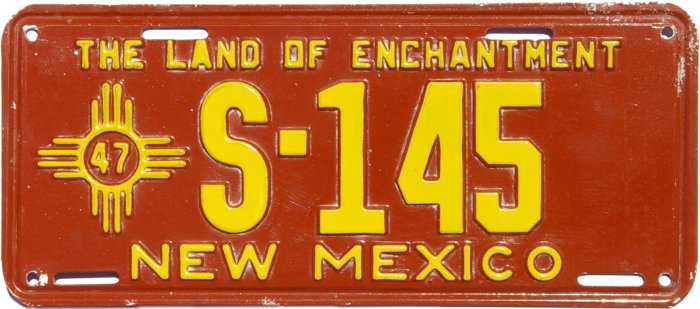 |
| |
1947 School Bus
plates exist both with and without a county number. It would not be
surprising to learn that a variety also exists without the hyphen, as is
found with the 1947 Dealer plates shown immediately above.
|
| |
| |
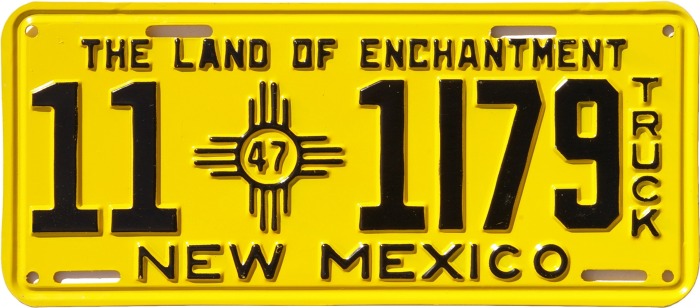 |
|
| 1947 Truck plates
are found with two different die styles for the numeral “1,” sometimes
with both varieties appearing on the same plate as in the example here.
See above for the same variation appearing on 1938 Truck plates, and
below for the same variation appearing on 1950 Truck plates. |
| |
| |
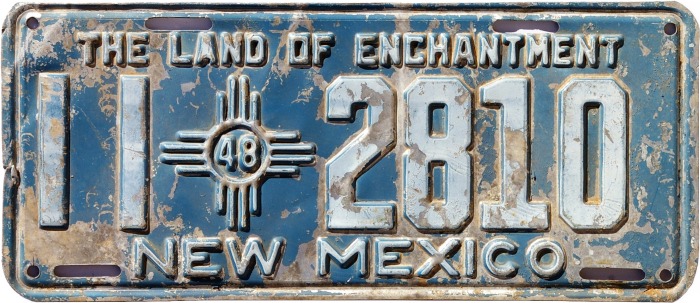 |
| |
| 1948 Passenger
plates are found with two different die styles for the numeral “1,”
sometimes with both on the same plate as in the example illustrated
here. Note also that the second “1” is offset slightly downward as
compared to all the other numerals on the plate. Similar die variants of
the numeral “1” are found on Truck plates, where they appear more
frequently than they do on Passenger plates. See for example 1938 and
1947, above, and 1950 below. |
| |
| |
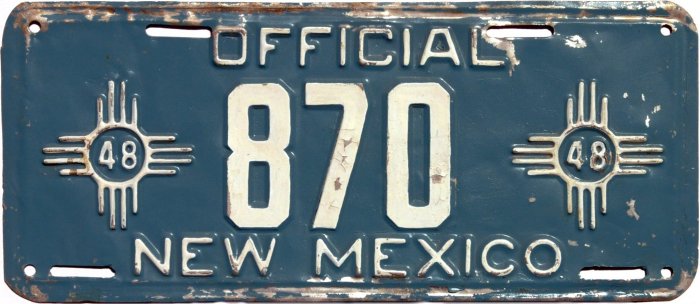
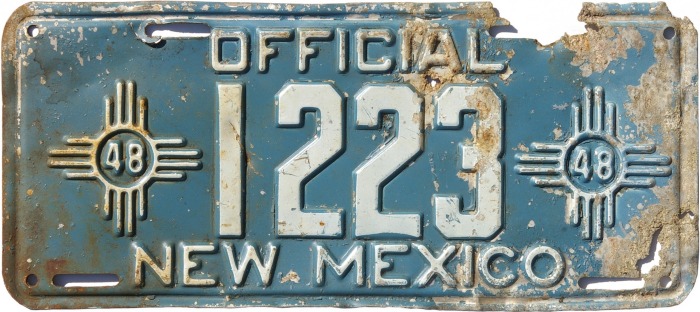 |
| |
| 1948 Official
plates are known to exist as Double Zias with 1- to 3-, and 4-digit
serial numbers, though the latter is extremely rare, with the
illustrated example being the only such plate known to exist. |
| |
| |
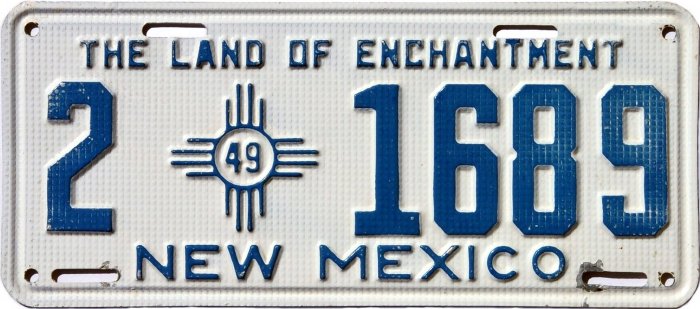
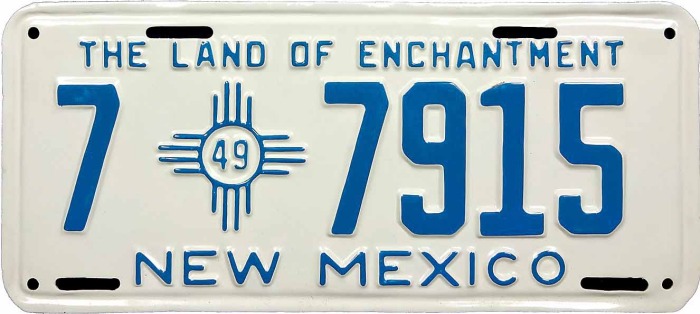 |
| |
|
1949 Passenger. While the vast
majority of 1949 Passenger plates are of the waffle aluminum type, there
are a few examples known which were made on smooth aluminum blanks. |
| |
| |
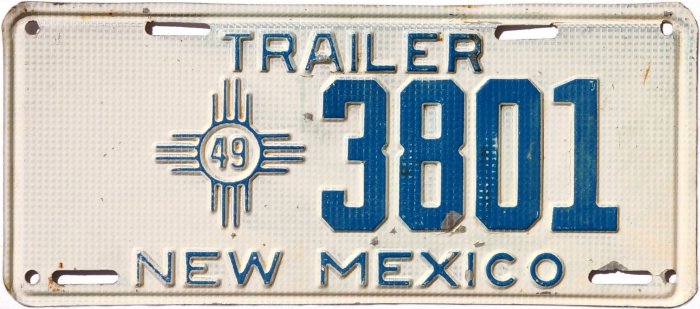
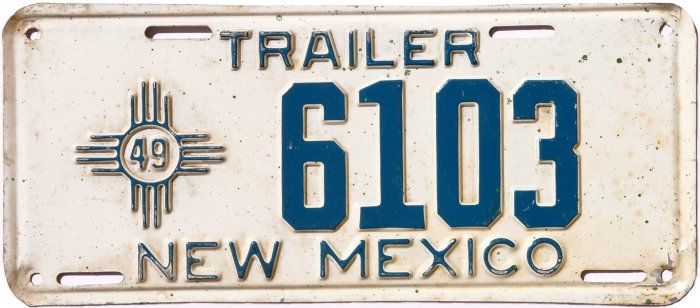 |
| |
|
1949 Trailer plates can also be found in both the
standard 1949 waffle texture, and a smooth surface. The waffle trailer
is the more common of the two. |
| |
| |
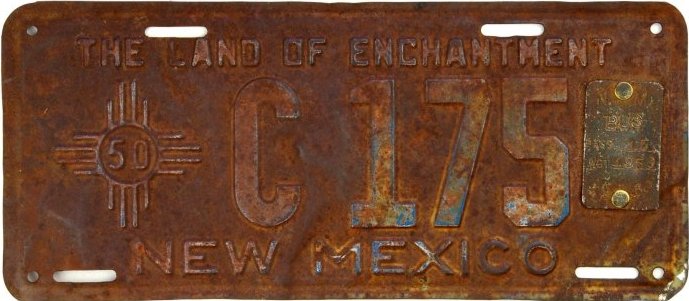
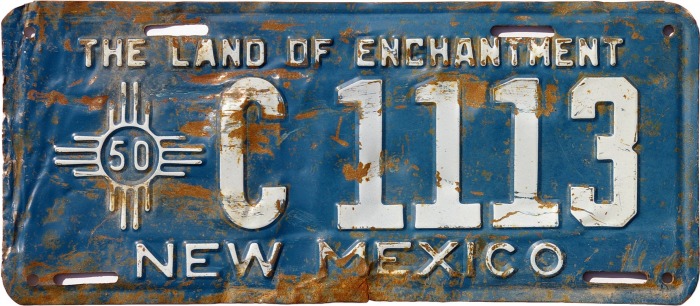 |
| |
| 1950 Commercial plates
with 4-digit serial numbers are found with the weight/capacity seals
(tabs) omitted due to lack of space for them. Instances of this omission
have also been observed for other years as well. There are also cases
known where the seal has been mounted such that it covers up the zia
symbol when there was otherwise no space for it. |
|
|
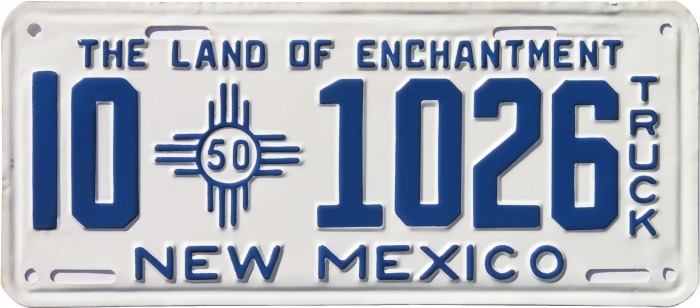 |
| |
| Two different die styles were used
for the numeral “1” on 1950 Truck plates, sometimes
with both styles appearing on the same plate, as in the example
illustrated here. See above for the same variation appearing on 1938 and
1947 Truck plates. Additionally, note that the first numeral “1” is
about ⅛" taller than all the other numerals, a characteristic which is
not seen in the above 1938 or 1947 examples. |
| |
| |
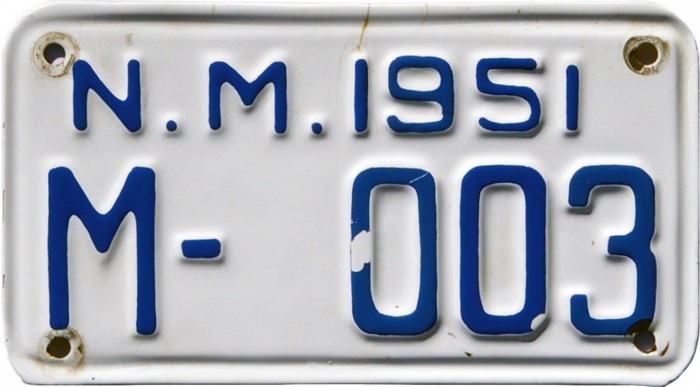
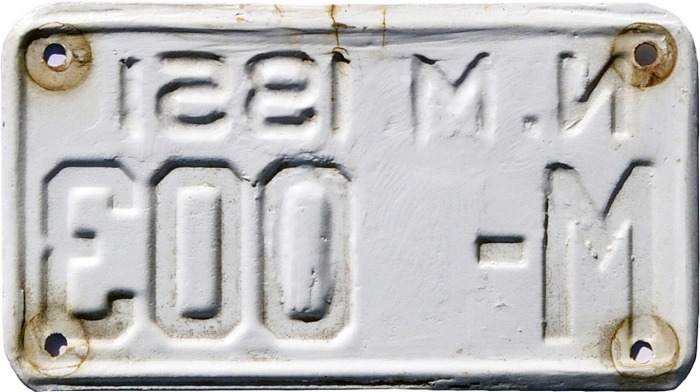 |
| |
| This 1951 Motorcycle
one-digit plate was made with leading zeroes, a practice not known to
have been used before or after this year, until about 1973, after which time the
practice became standard. One- and/or two-digit Motorcycle plates have
been documented for 1915, 1924, 1932, 1938, 1939, 1955, and 1963, among
other years. None of these have leading zeroes. |
| |
| |
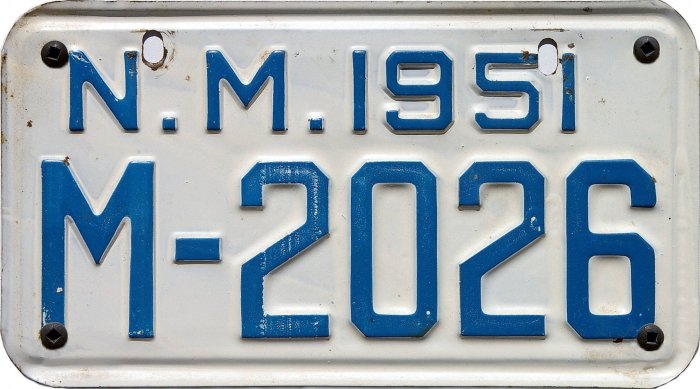
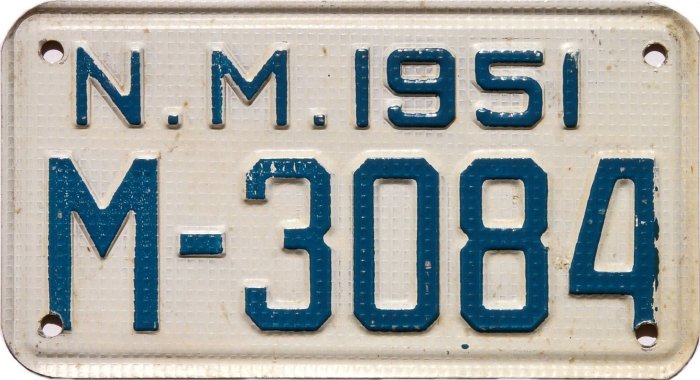 |
| |
|
1951 Motorcycle plates were
made in both steel and waffle aluminum, with the former being by far the
most common. |
| |
| |
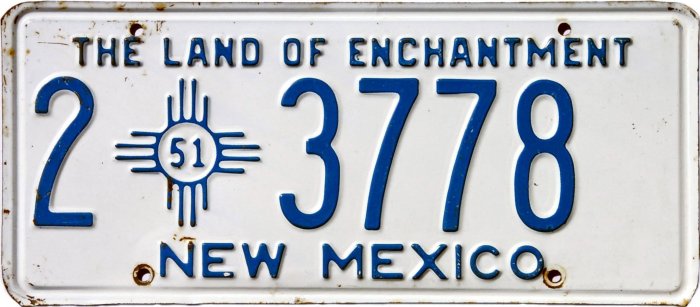
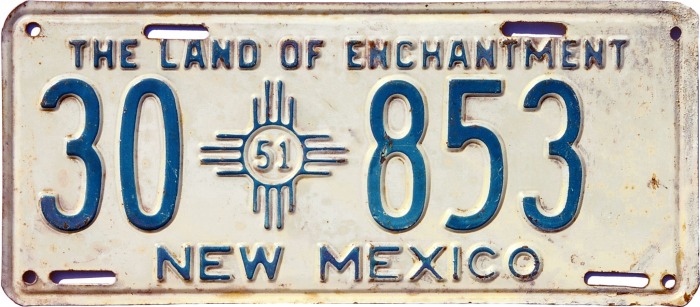 |
| |
|
1951
Passenger plates were manufactured
with two different arrangements of mounting holes. One style has four
round bolt holes, while the other has four oblong bolt slots plus four
additional round holes in the corners. |
| |
| |
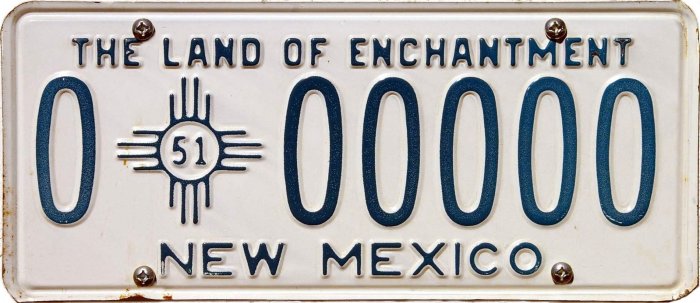
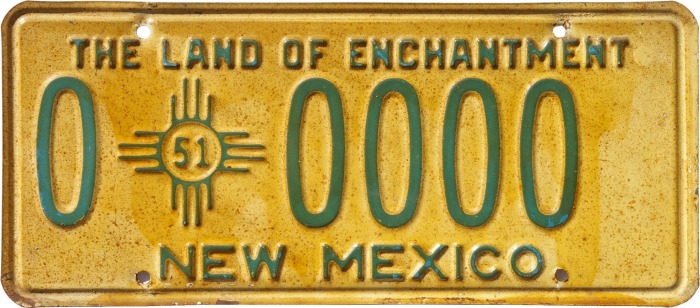 |
| |
| 1951 Samples were
made in the more common arrangement with five zeroes after the zia, and
the less common variety with four zeroes after the zia, the latter
example in this case having unfortunately been varnished. |
| |
| |
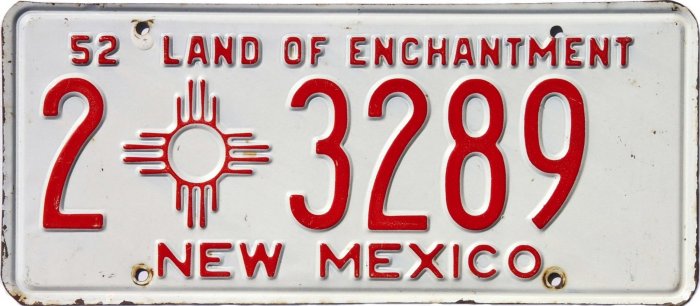
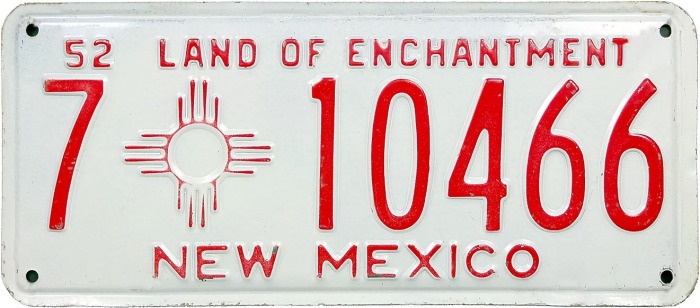
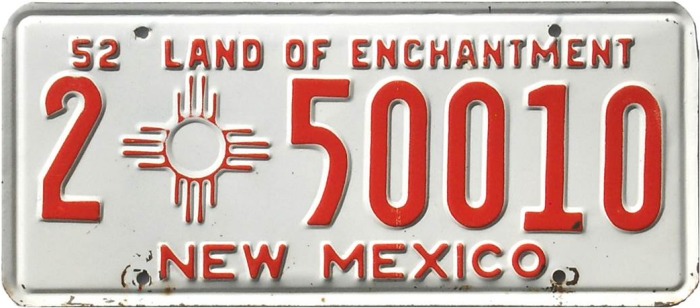 |
| |
1952 Passenger Car Varieties.
Passenger plates for 1952 exist with two different bolt hole layouts.
The more common one has the holes roughly 2¾ inches inboard from the
left and right edges of the plate, while the other has the holes very
close to the corners. The latter arrangement is uncommon and is seldom
seen. Also, at the far right, is an example of a 1952 Passenger
plate made late in the year with the new dies that would be used
throughout 1953. This variety is very uncommon as well.
|
| |
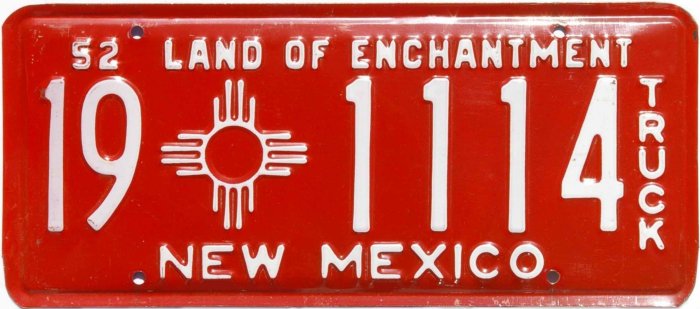
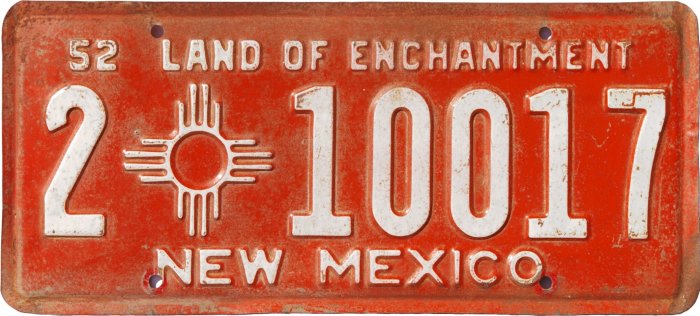
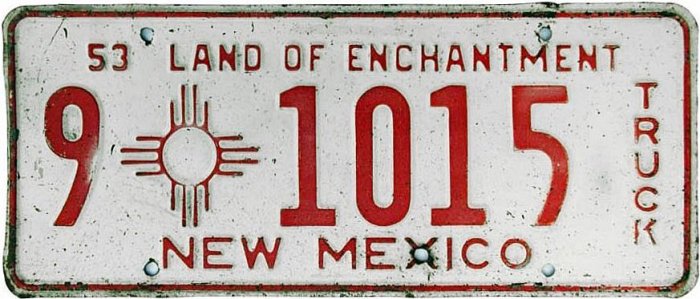
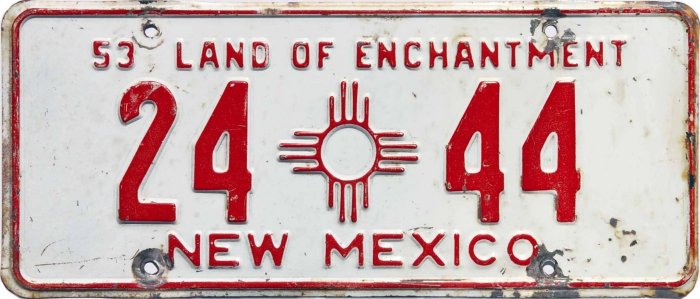 |
| |
|
1952 and 1953 Truck plates.
Both years of Truck plates were made with and without the word “TRUCK.”
The ones without “TRUCK” are told from car plates by their colors only.
Note that the 1952 Truck plate without the word “TRUCK” also differs in
that it was made with 1953 dies. |
| |
| |
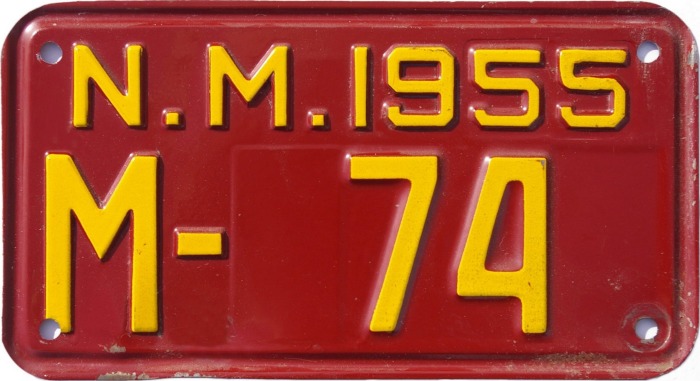
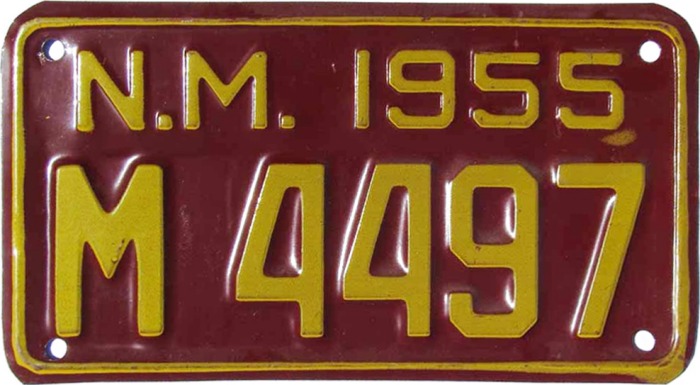 |
| |
| 1955 Motorcycle
plates - sometime during the 1947 license plate production year the
spacing between the “N.” and the “M.” was slightly increased at the top
left of Motorcycle plates. This wider spacing was used until in the
latter part of the 1955 production year when the spacing was closed up
to the way it had been earlier. At about the same time the plate's
border was changed from an unpainted debossed rim to a painted embossed
rim, and with the colors in a somewhat darker hue. (Anecdotal
evidence suggests these changes occurred between plate numbers 4035 and
4497.) The result is that there are two distinct
varieties of both 1947 and 1955 Motorcycle plates. |
| |
| |
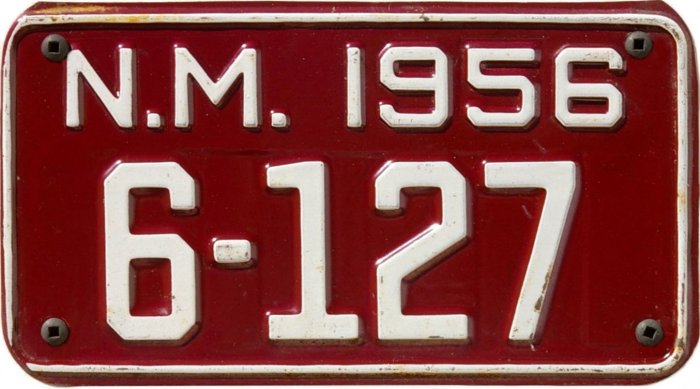
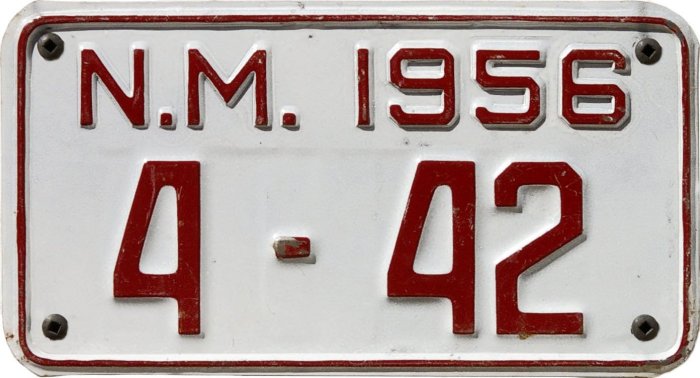 |
| |
|
1956 Boat plates. For reasons not
known, boat plates in 1956 were made in both Passenger Car colors and
Truck colors. |
| |
| |
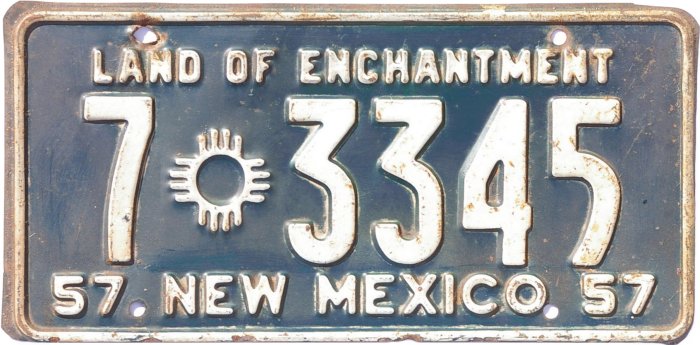
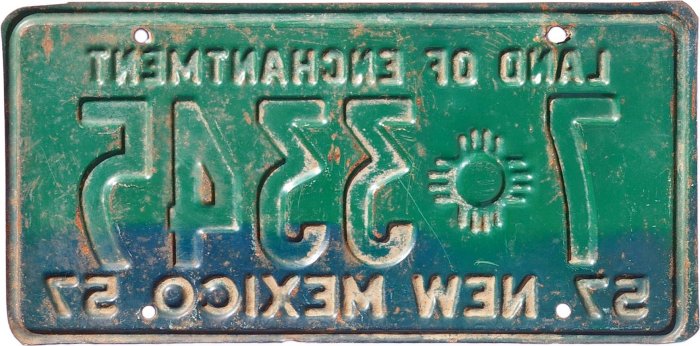 |
 |
| Correct color 1957 truck plate |
| |
| Another example of a plate being the wrong color
is this 1957 truck plate #7-3345. It's anyone's guess as to why,
but it appears that the plate was first coated with the correct green
paint, then oversprayed with a dark blue color. There's no doubt
it was manufactured this way but why is a mystery. Note the back
of the plate is only partially oversprayed. |
| |
| |
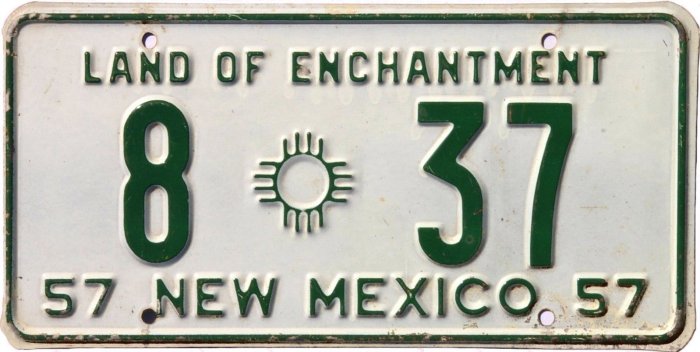
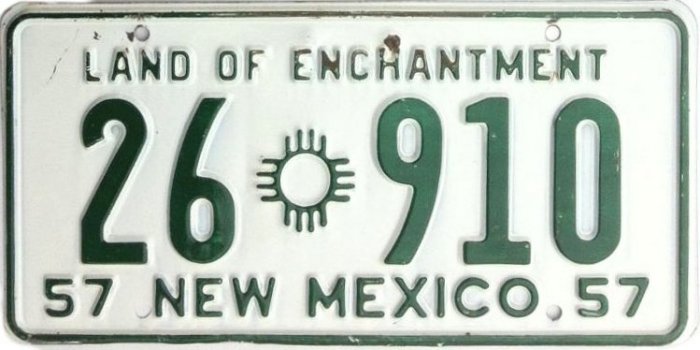
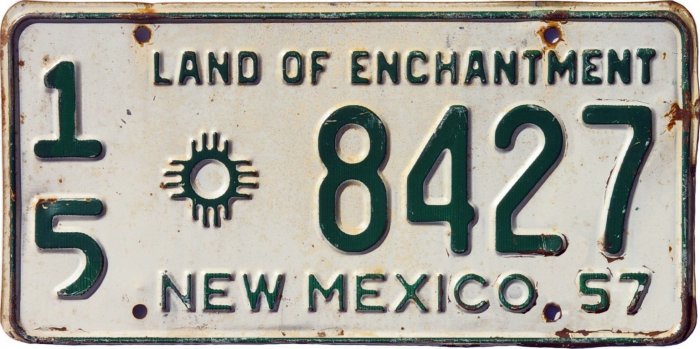
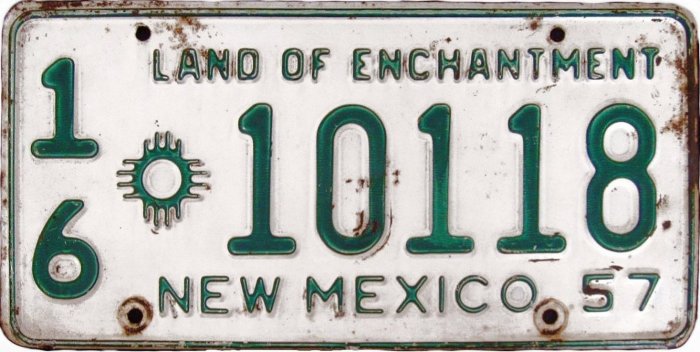
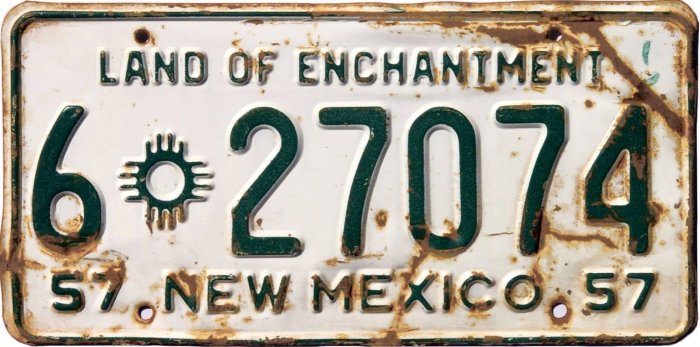 |
| |
|
1957 Passenger varieties. If one
wishes to consider one-digit and two-digit county codes as separate
varieties, we can count a total of five variations for 1957:
Single-digit county code; 2-digit side-by-side county code; 2-digit
stacked county code for plate serials in some high 4-digit numbers as
well as all serials 10000 and higher; and a late-year die change with
serial number digits ¼ inch shorter than those on the earlier plates
(this type includes all stacked county code plates). On plates with the
stacked county codes it was necessary to eliminate the superfluous “57”
in the lower left corner and shift the slogan at the top slightly to the
right. #26-910 courtesy Jim
Gummoe. |
| |
| |
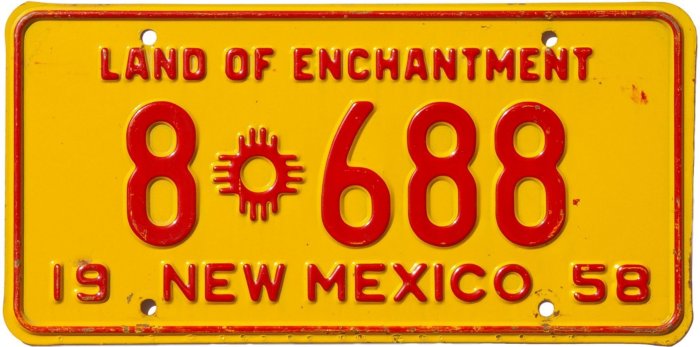
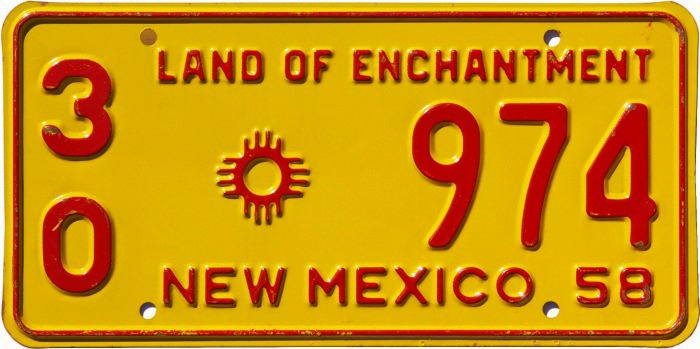
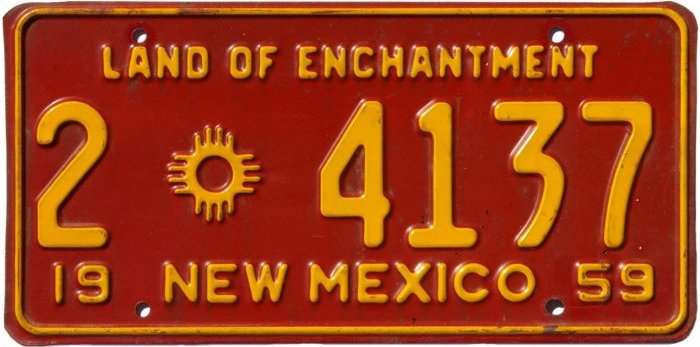
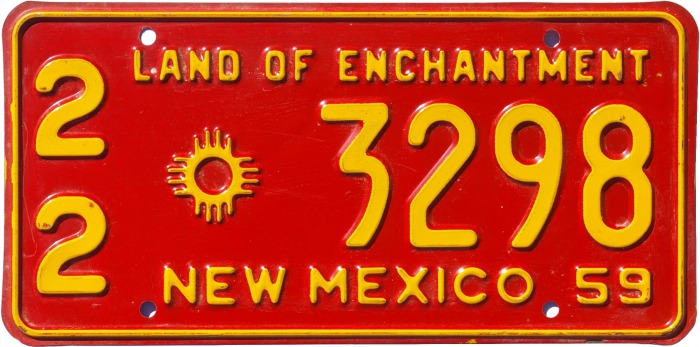 |
| |
| 1958 and 1959 Passenger
plates were made in two varieties both of these years. Those with
1-digit county numbers had an embossed “19” in the lower left corner and
an embossed “58” (or “59”) in the lower right corner. Additionally, the
“LAND OF ENCHANTMENT” slogan at top was centered. Plates with stacked
2-digit county numbers omitted the “19” and had the LOE slogan offset
about an inch to the right. |
| |
| |
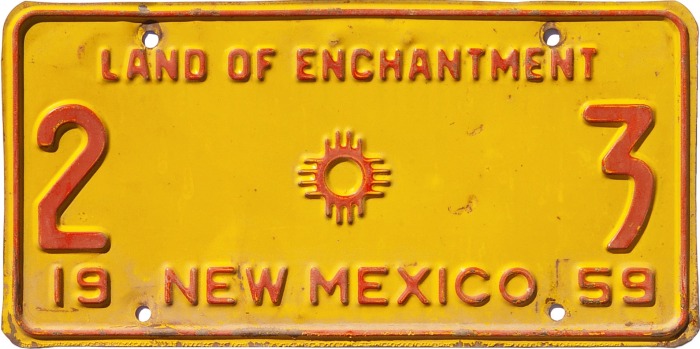
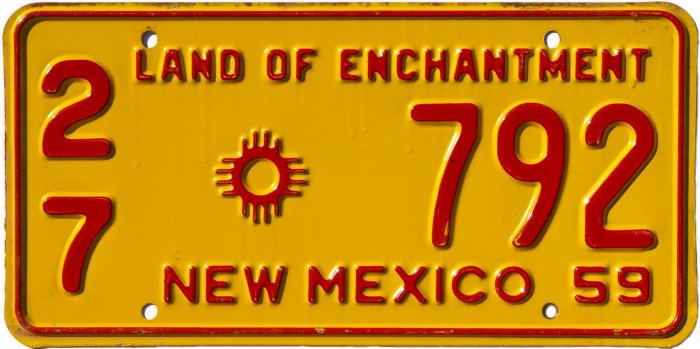 |
| |
| 1958 and 1959 Truck
plates were made in two varieties both of these years. Those with
1-digit county numbers had an embossed “19” in the lower left corner and
an embossed “58” (or “59”) in the lower right corner. Additionally, the
“LAND OF ENCHANTMENT” slogan at top was centered. Plates with stacked
2-digit county numbers omitted the “19” and had the LOE slogan offset
about an inch to the right. |
| |
| |
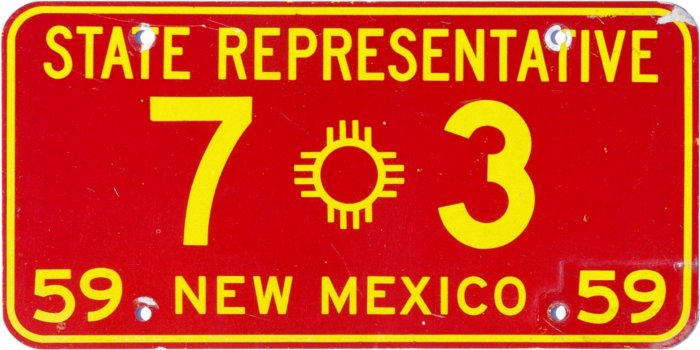
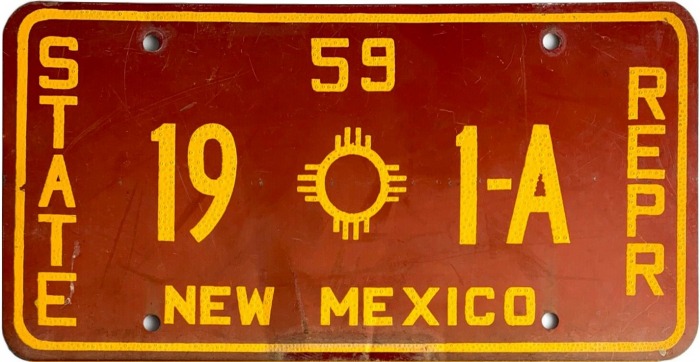 |
| |
| 1959 State Representative
plates are known to exist in at least two distinct configurations,
especially with respect to the layout of the date and the “State
Representative” designation. The significance of the “A” suffix is
uncertain, but it may have indicated a license for a second vehicle used
by the same Representative. |
| |
| |
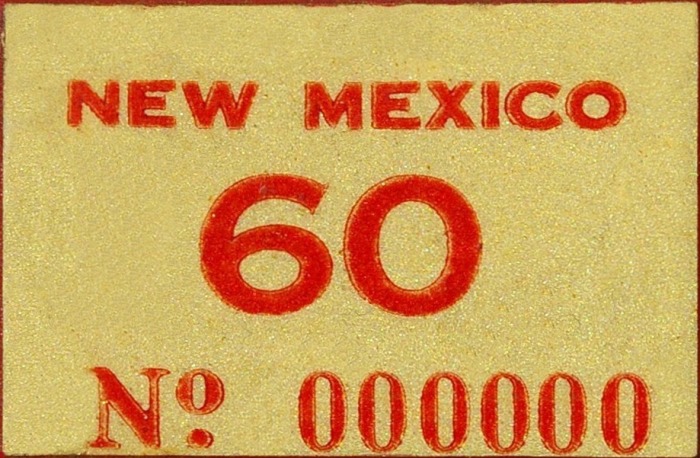
.JPG)
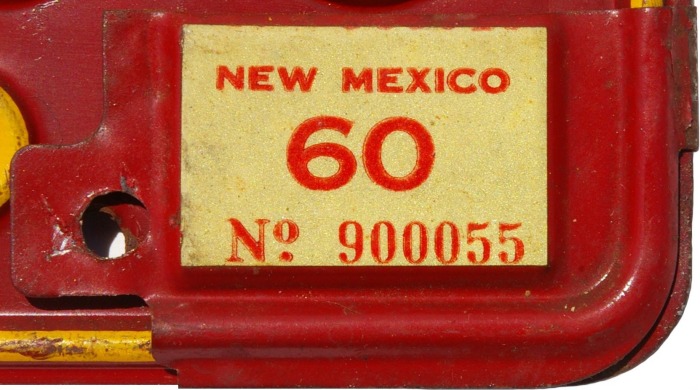 |
| |
| 1960 Sample tab/stickers
were made with both a 000000 serial number and a SAMPLE serial number.
The 900055 sticker, found on a 1959 Sample plate, is believed, but not
yet verified, to be another variety of 1960 Sample sticker as its serial
number is far too high for a regular 1960 passenger car sticker. |
| |
| |
.jpg)
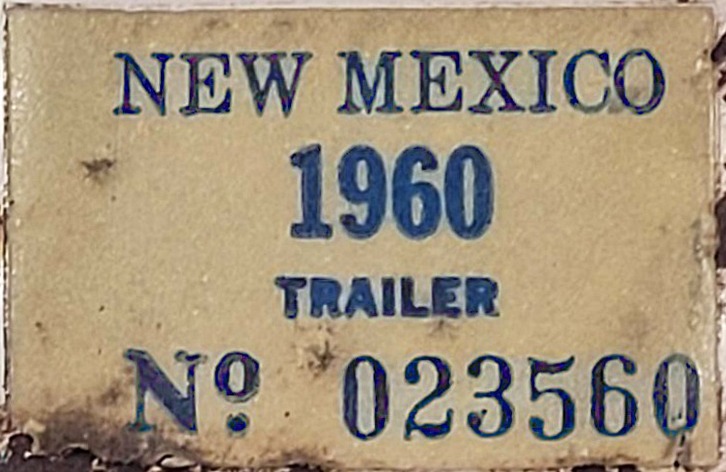 |
| |
| 1960 Prorate backing plate
Trailer stickers are known to exist with both black lettering
and blue lettering. Sticker 023560 courtesy Phil Hill. |
| |
| |
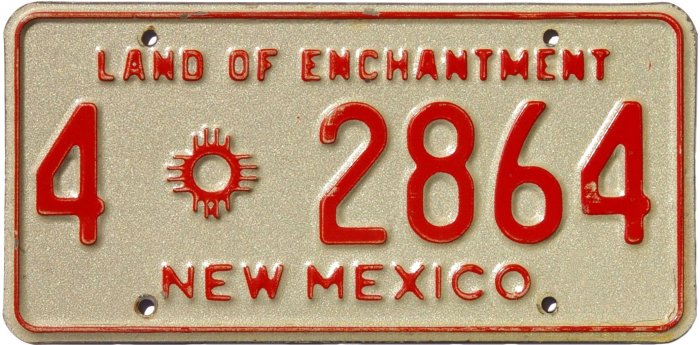 |
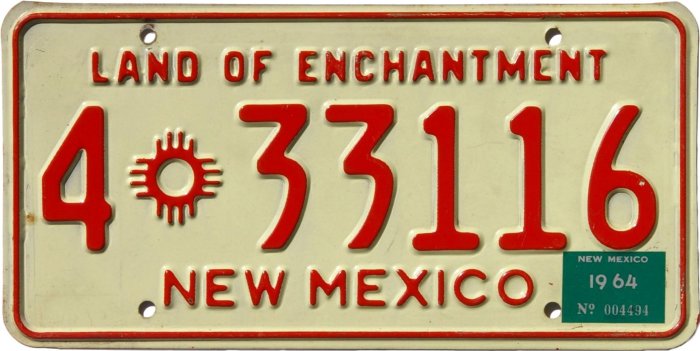 |
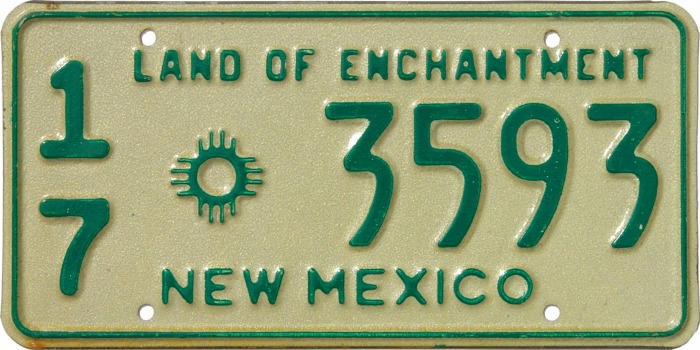 |
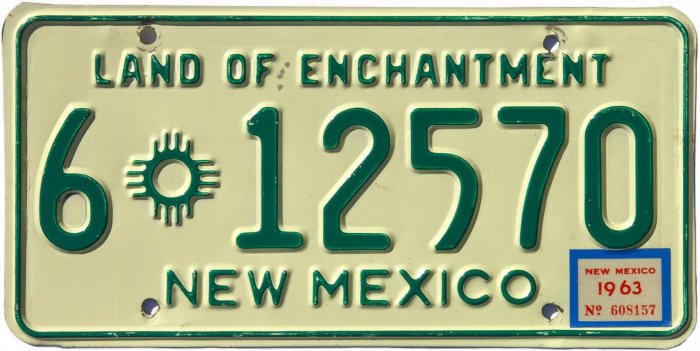 |
| Reflective Passenger |
Painted Passenger |
Reflective Truck |
Painted Truck |
|
| |
| 1961-1964 Passenger and
1961-1963 Truck. New Mexico introduced undated plates
for use in 1961. These same plates were to be reused for several more
years, through the application of dated revalidation stickers in 1962
and later. The undated base plates themselves were produced in two
styles—some with a Scotchlite® reflective background, and others with a
plain painted background. A common misconception is that the two types
were issued concurrently through all the years they were in use
(1961-1964 for Passenger cars, and 1961-1963 for Trucks), but in fact,
the reflective plates were issued only in 1961 and 1962, while the
painted plates were issued only in 1963 and 1964. (A very small number
of painted plates are known to have been issued very late in 1962.) The
reason for the switch was cost, as the proprietary sheeting for the
reflective tags cost 46 cents per plate, whereas it cost only 16 cents
per plate to paint them. Both the reflective and painted Passenger car
plates were red on white, while both of the Truck plate varieties were
green on greenish white. Several other types of plates, including those
used for Trailers, followed the same pattern as the Passenger car plates
during this time period. |
| |
| |
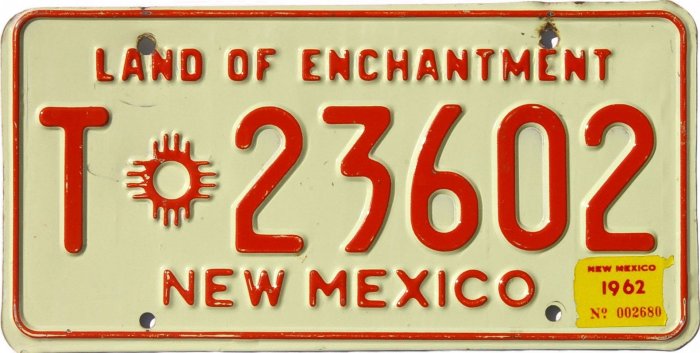
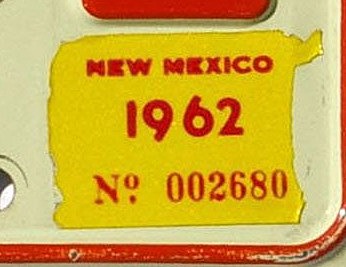
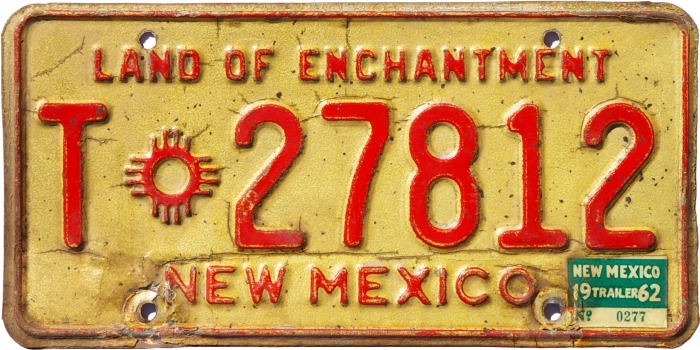
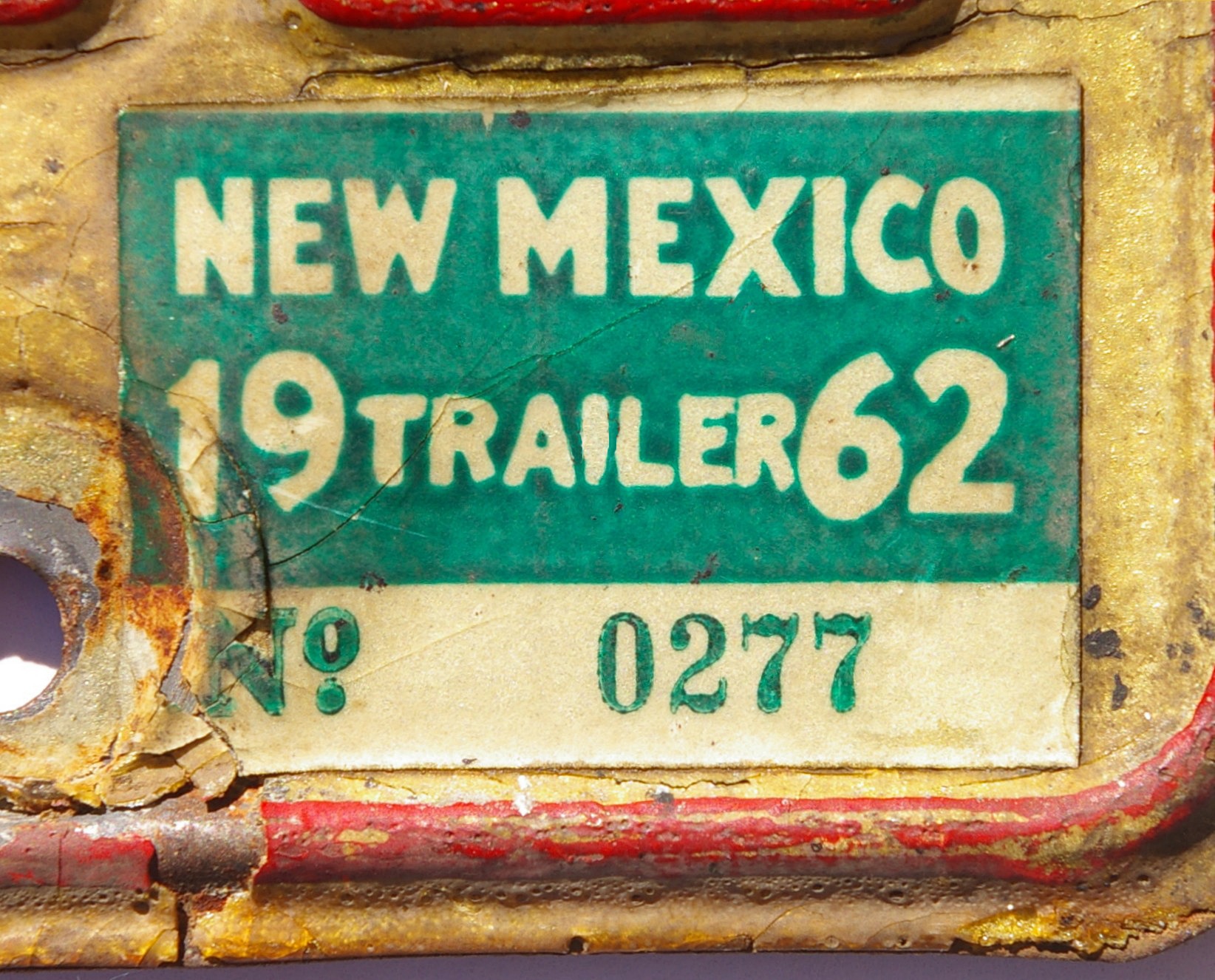 |
| |
| Like Car and Truck plates,
1962 Trailer plates were provided as undated 1961 base plates
with a generic red-on-yellow 1962 validation sticker. The example shown
at right, however, received a purpose-made 1962 Trailer sticker, and is
the only one of this style known to exist. |
| |
| |
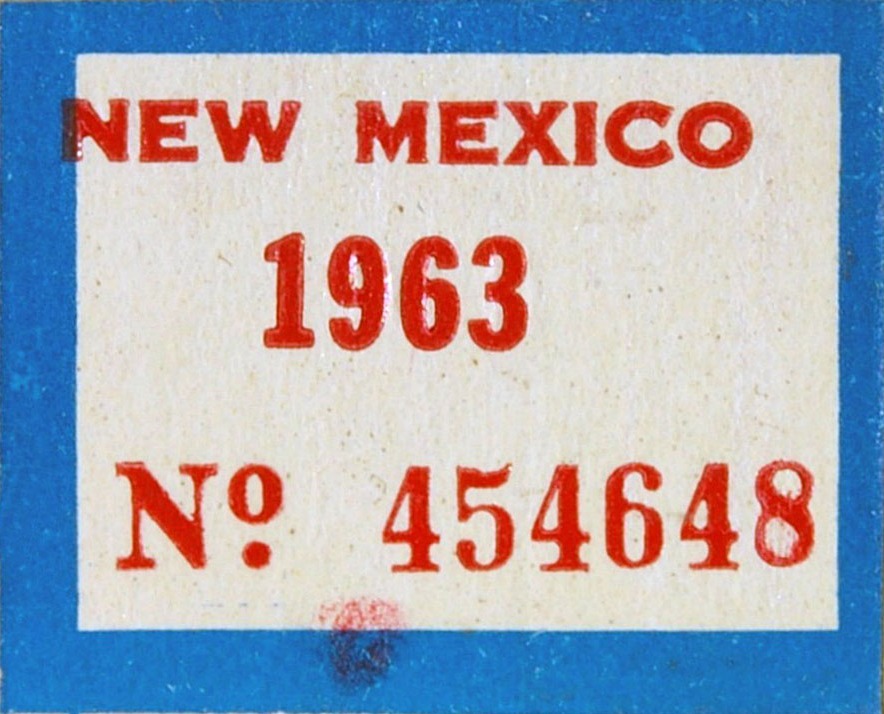
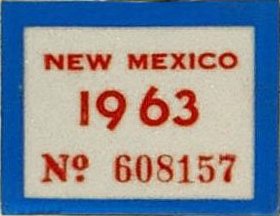 |
| |
| 1963
Validation Stickers. New Mexico issued
two varieties of stickers for 1963, with most of them being made of
paper, and a smaller number made of vinyl (plastic). The paper stickers
deteriorated rapidly, exposed as they were to the elements, whereas the
vinyl stickers proved to be much more durable. Please see the
Stickers page for other variations of
stickers within given years. |
| |
| |
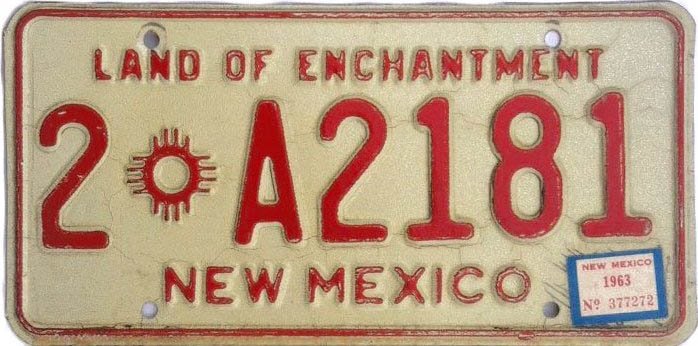
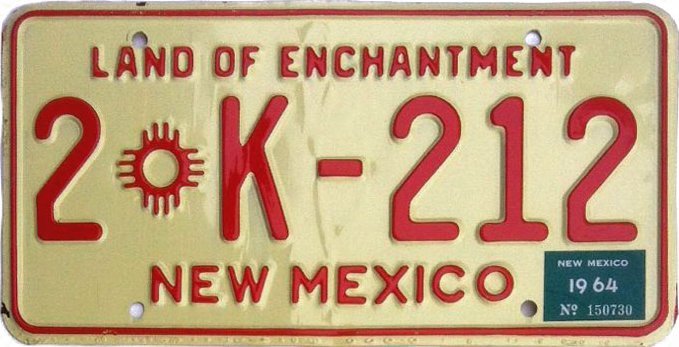
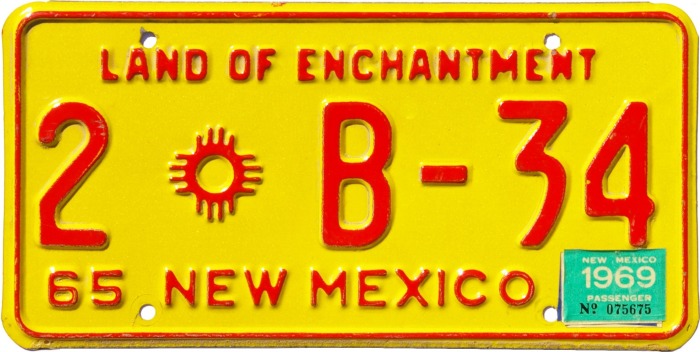
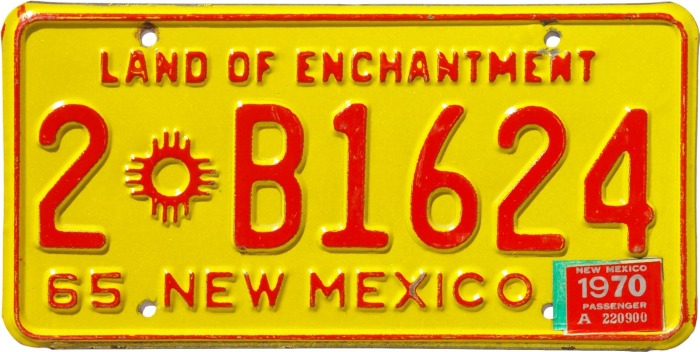 |
|
| Hyphens in serial numbers on
1961 and 1965 base plates. In order to accommodate the large
number of cars registered in Bernalillo County (county #2), it became
necessary to introduce an alphabetic character in the serial number in
the late 1950s for this county only. This brought about an interesting
variation in the serial number format for county #2 on both the 1961 and
1965 series base plates, wherein a hyphen was used, but only on some of
the tags. On those plates using the letters A through L, and with one,
two, or three numeric digits, a hyphen was inserted between the letter
and the numeric part of the serial number, whereas those with four
digits had no hyphen. Plates with the letter M or higher had no hyphen,
regardless of the number of digits. |
|
| |
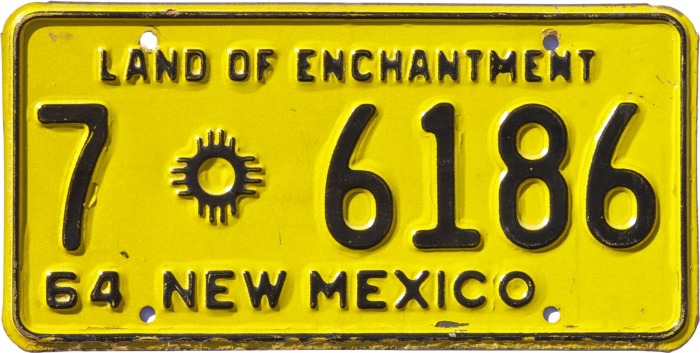
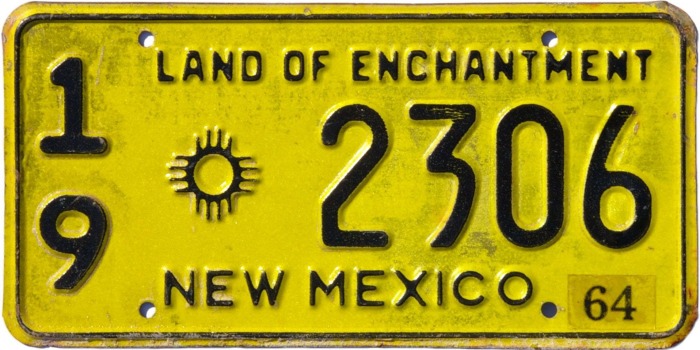 |
| |
| 1964 Truck plates
with single-digit county numbers have an embossed “64” in the lower left
corner, while those with 2-digit county numbers have a pre-applied “64”
sticker in the lower right corner. On those with 1-digit county
numbers the Land of Enchantment slogan is centered, while on those with
2-digit county numbers the slogan is offset to the right. |
| |
| |
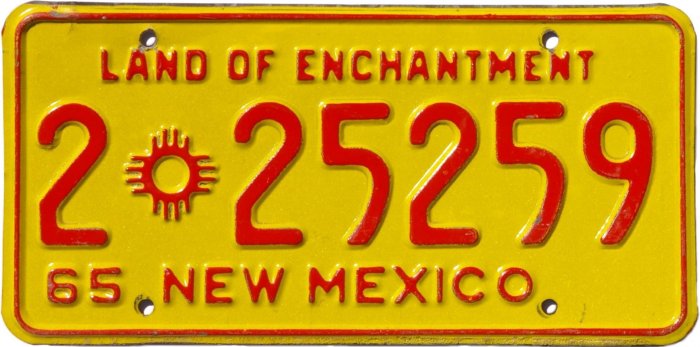
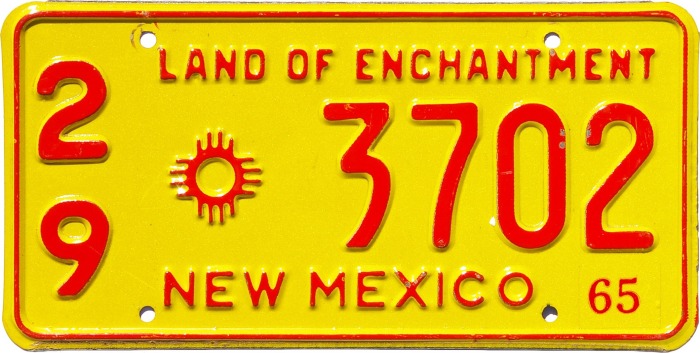 |
| |
| 1965 Passenger
plates were produced in two distinct varieties. Those with one-digit
county codes have an embossed “65” in the lower left corner, while those
with two-digit county codes have a pre-applied Scotchlite “65” sticker
in the lower right corner. Both styles were renewed with later-year
stickers placed in the lower right corner. On those with 1-digit
county numbers the Land of Enchantment slogan is centered, while on
those with 2-digit county numbers the slogan is offset to the right. |
| |
| |
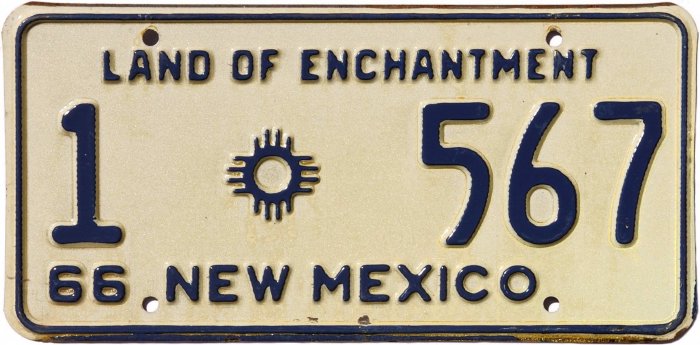
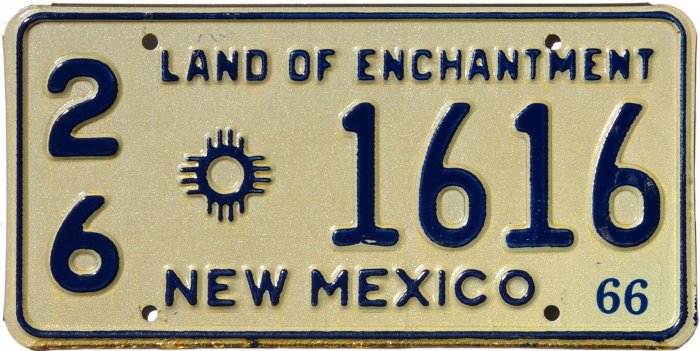 |
| |
| 1966 Truck plates
were produced in two distinct varieties. Those with one-digit county
codes have an embossed “66” in the lower left corner, while those with
two-digit county codes have a pre-applied Scotchlite “66” sticker in the
lower right corner. Both styles were renewed with later-year stickers
placed in the lower right corner. On those with 1-digit county
numbers the Land of Enchantment slogan is centered, while on those with
2-digit county numbers the slogan is offset to the right. |
| |
| |
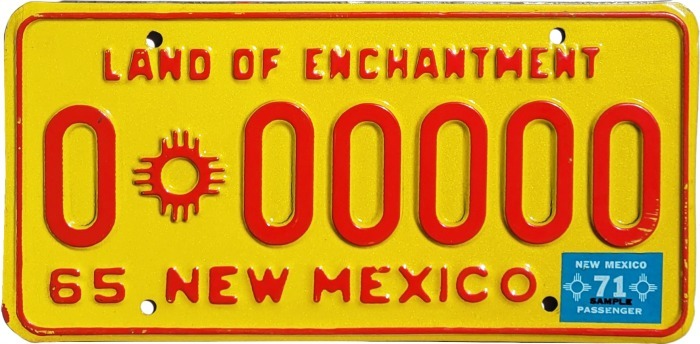
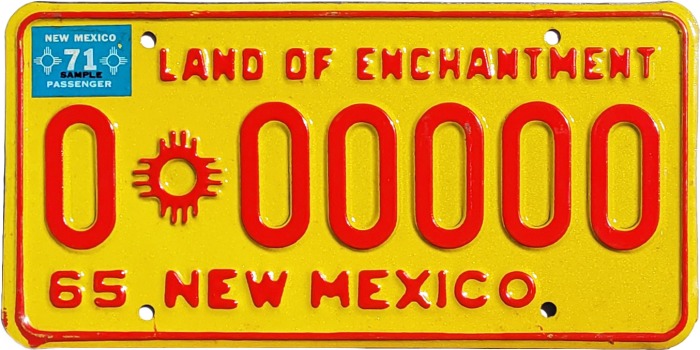 |
| |
| 1965 base Sample Passenger
plates with 1971 validation stickers. These exist with both
centered and offset Land of Enchantment slogans, the former apparently
having been made with the dies for 1-digit county numbers and the latter
with the dies for 2-digit county numbers, even though the Samples have
only a 1-digit “county number” of 0. (The sticker on the 2-digit example
shown here is erroneously placed in the upper left corner and is itself
not considered a factor in the variety.) Both photos Courtesy Phil
Hill. |
| |
|
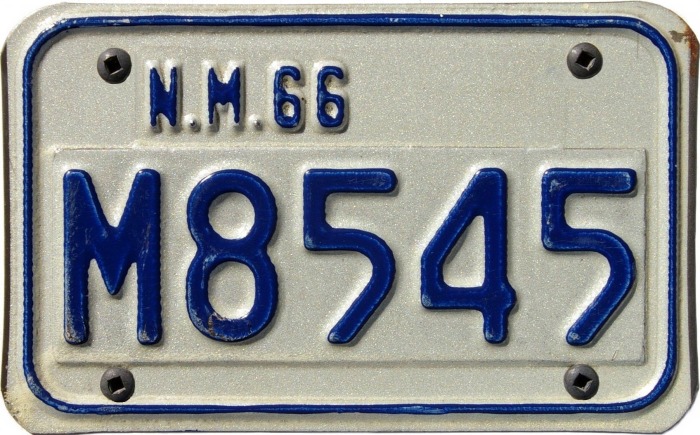
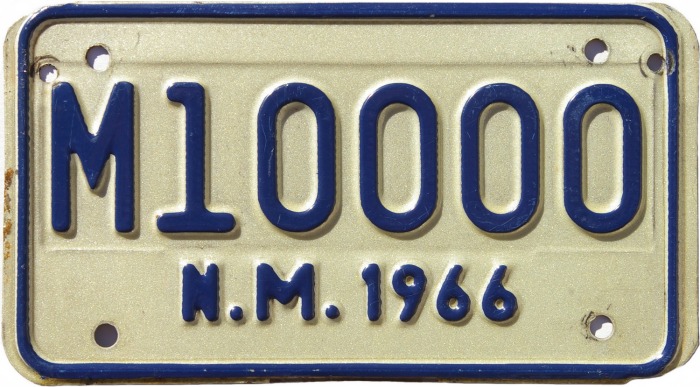
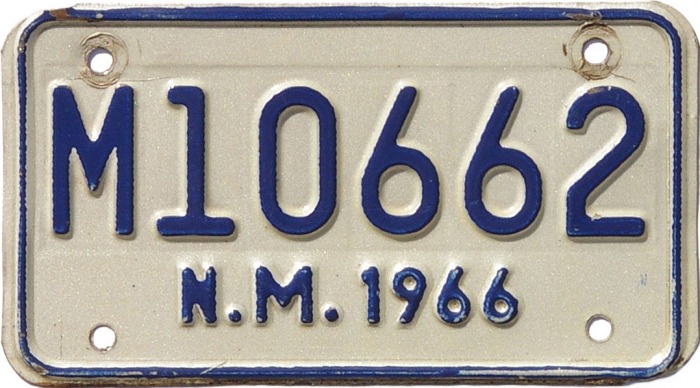 |
| |
|
1966 Motorcycle plate sizes. From
1959 to 1966 motorcycle plates had been a relatively small size of 3¾" x
6". During 1966 motorcycle registrations reached the 10,000 mark for
the first time and there was insufficient space on the small plates for
the additional digit. To accommodate the larger numbers the state
increased the size of the plates to 4" x 7" beginning with plate number
M10000, and this larger size has remained unchanged to the present
day. Because this change occurred during the 1966 licensing year, 1966
motorcycle plates exist in both sizes. After the conclusion of the
1966 registration year New Mexico reported to the Federal Highway
Administration that the total number of motorcycles registered for the
year was 10,508. But since license plates were issued from separate
batches supplied to each of the MVD field offices, the highest plate
number issued for the year was actually slightly higher. Seen above are
M10000, the very first of these new, larger size plates, and M10662, one
of the very last of these plates issued in 1966. |
| |
| |
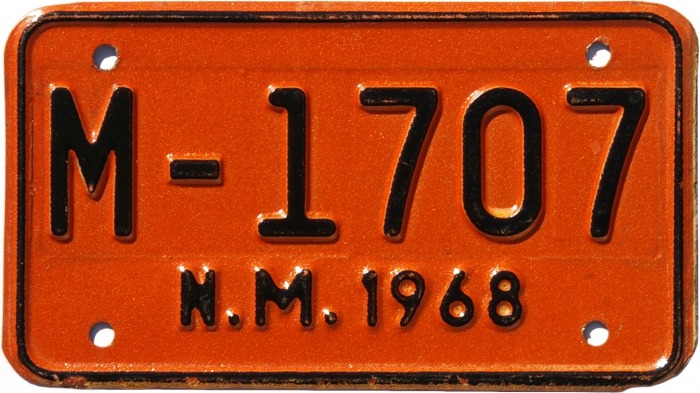
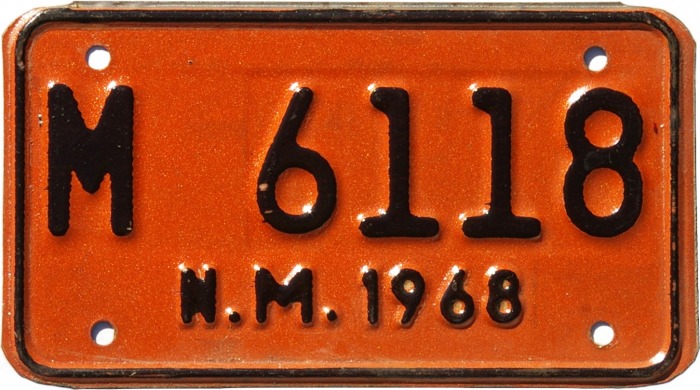 |
| |
1968 Motorcycle
plates were manufactured both with and without a hyphen between the “M”
and the serial number. Anecdotal evidence suggest that the hyphen was
dropped somewhere around serial number M 6000 (e.g., M-5592 is known to
have a hyphen, while M 6118 does not).
|
| |
| |
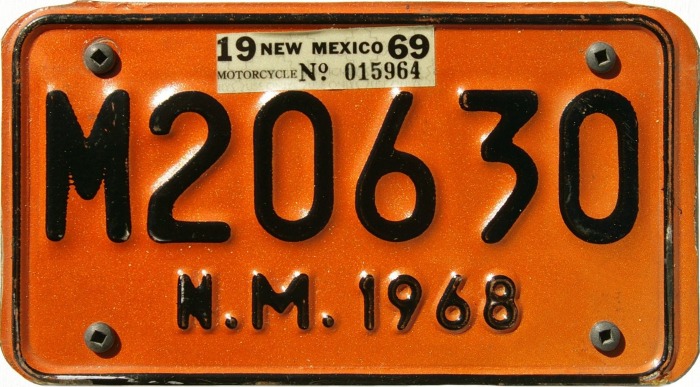
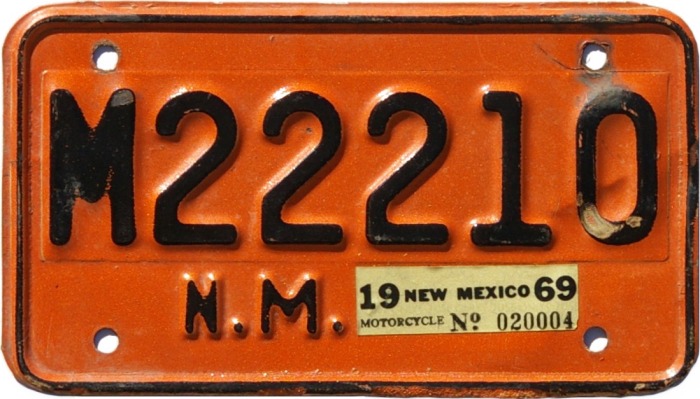
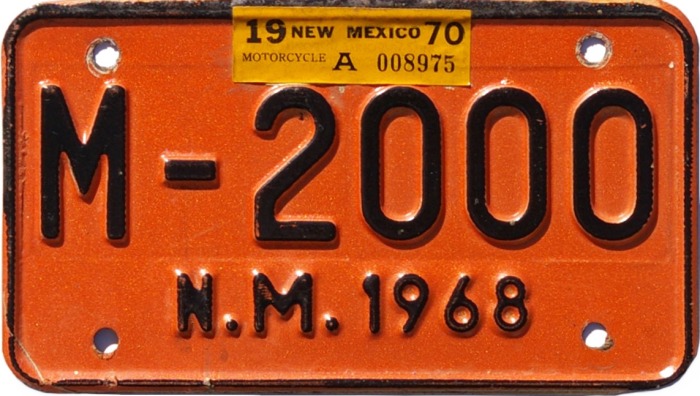
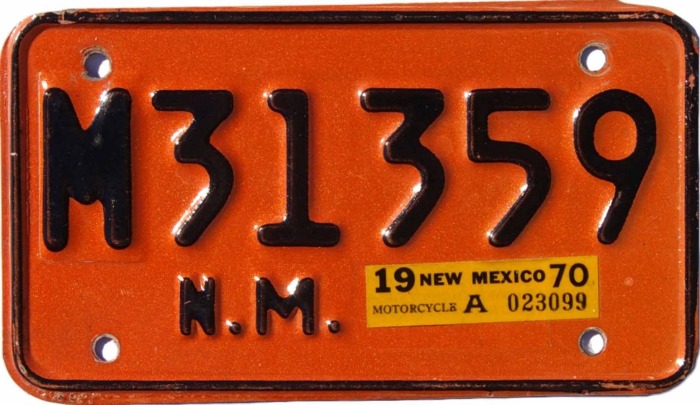
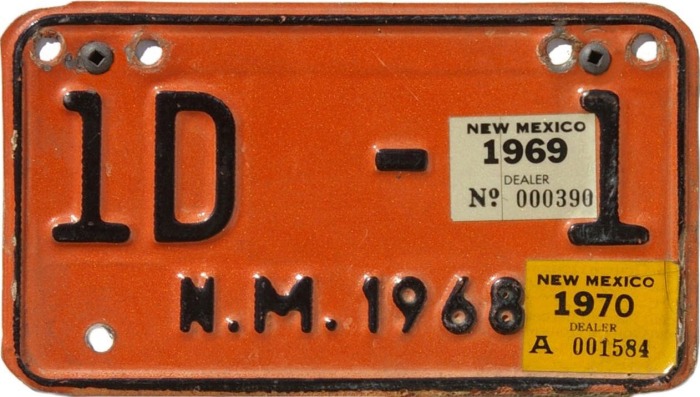
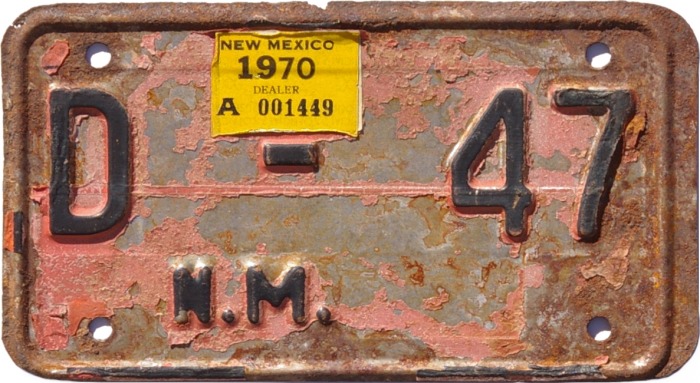 |
| |
| 1969 and 1970 Motorcycle and
Motorcycle Dealer plates are stickered plates found on both the
dated 1968 base and the undated 1969 base. |
|
| |
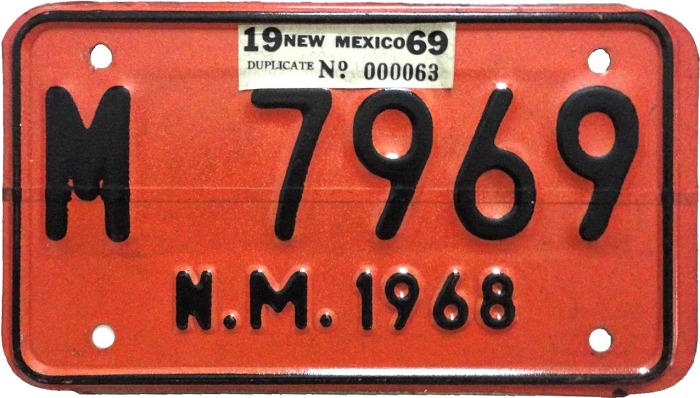

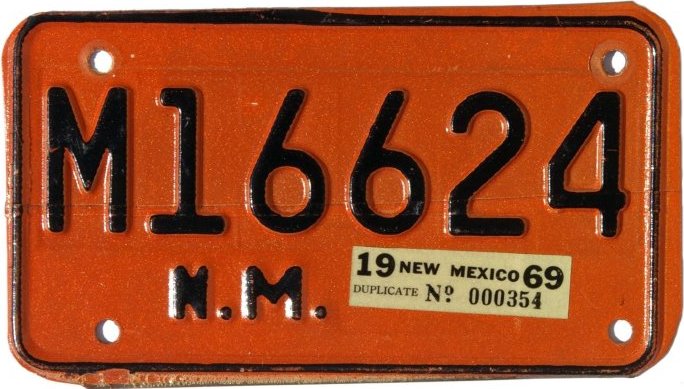
 |
| |
| 1969 Motorcycle Duplicate
plates are stickered plates found on both the dated 1968 base
and the undated 1969 base. 1968 base plate and its Duplicate sticker
courtesy Michael Breeding. |
|
| |
| |
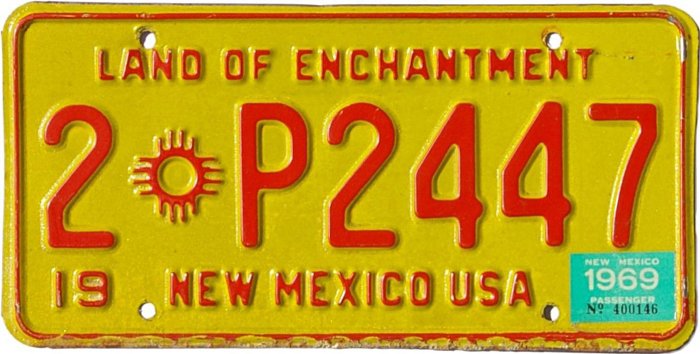
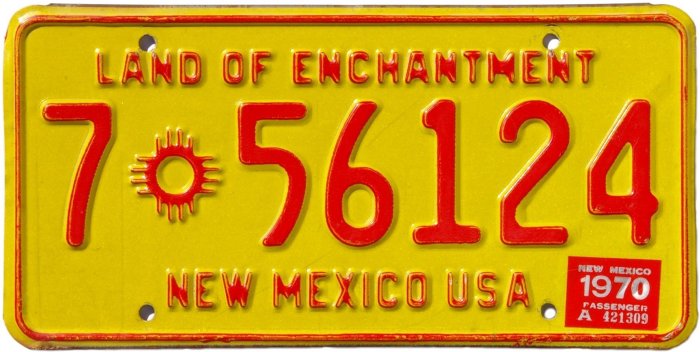 |
| |
| 1969-1971 Passenger Car
Varieties are a continuation of the 1965 base, but with "USA"
added after the state name. These 1969-1971 plates with single-digit
county numbers are found with an additional variation, wherein some of
these have an embossed "19" in the lower left corner while others are
blank in that corner. |
| |
| |
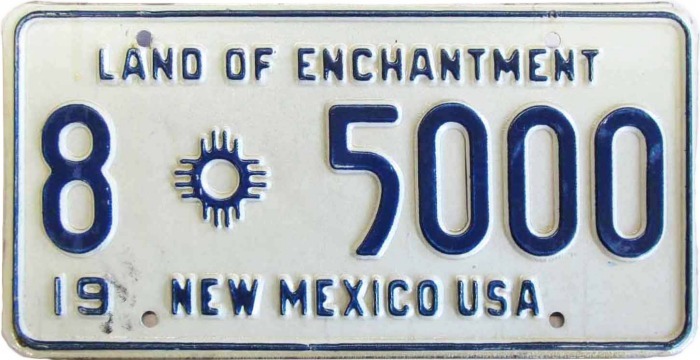
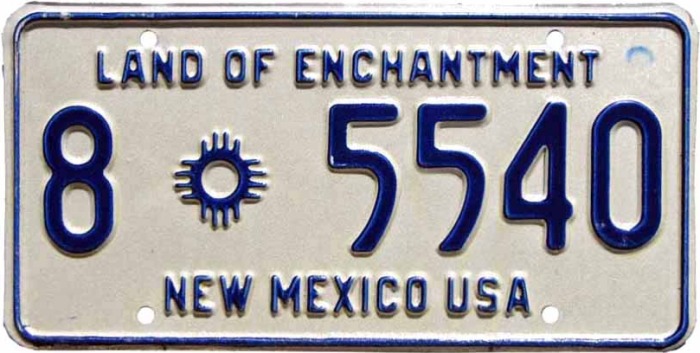 |
| |
| 1969 Truck varieties.
The 1966 base Truck plates were renewable through 1970, but in 1969 the
“USA” abbreviation was added to New Mexico plates resulting in a
variation known as the 1969 base Truck plate, issued and renewable
through 1970. Within the 1969-1970 base there are two distinct varieties
known for single-digit county plates, one with an embossed “19” in the
lower left corner, and the other without. The embossed “19” variety is
relatively uncommon. Both courtesy Michael Breeding. |
| |
| |
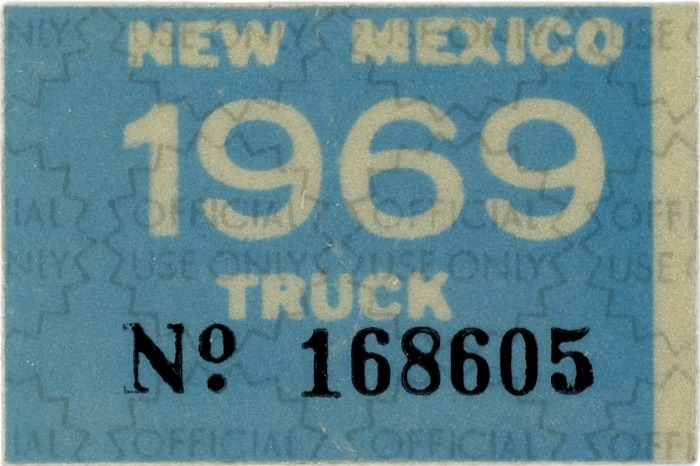
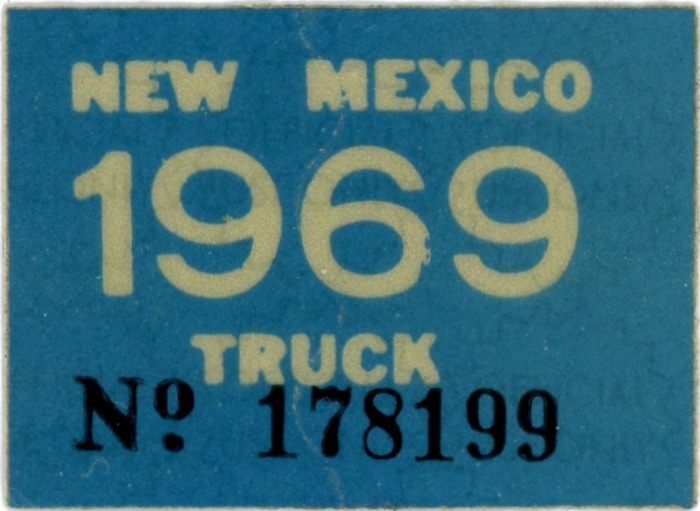 |
| |
| 1969 Truck
validation/renewal stickers are found in two different shades
of blue. The lighter blue variety has a very distinct OFFICIAL USE ONLY
watermark, and most examples of these have a white band on one end. On
the darker blue variety the watermark is present, but is difficult to
see, and the white band is not present. |
| |
| |
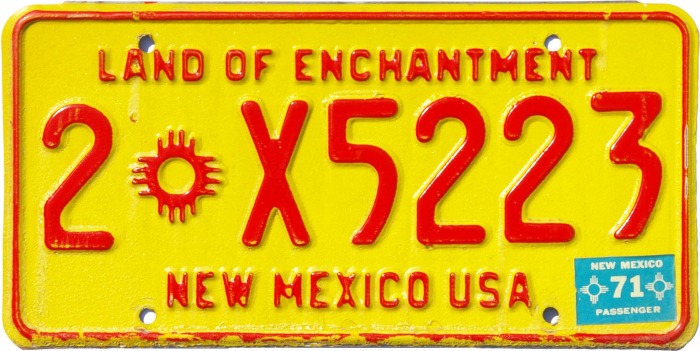
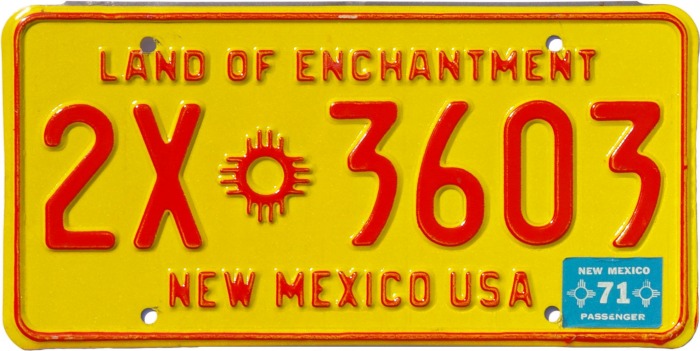
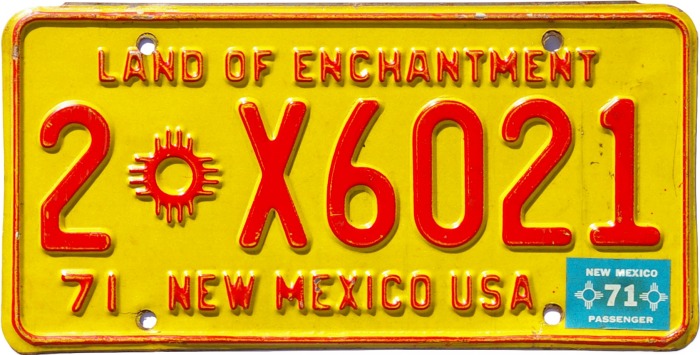 |
| |
| By 1960 Bernalillo County registrations had
become so numerous that there was insufficient space for an all-numeric
serial number, thereby necessitating the introduction of an alphabetic
character for serial numbers higher than 99999. The general format was
2*A12345, i.e., with the alpha character after the zia symbol. In 1971,
however, plates using the letter "X" were produced in two varieties,
some with the X following the zia, and others with X preceding the zia.
The latter examples were probably made this way in error, and it would
not be surprising to find plates with other letters (and from other
years) with a similar non-standard layout.
1971 Passenger plates in the “X” serial number
series are also known to exist with an embossed “71” in the lower left
corner, supplemented by a “71” sticker in the lower right corner. These
may be error plates struck using the new 1971 base Truck plate dies for
1-digit counties (see below). |
|
| |
.JPG)
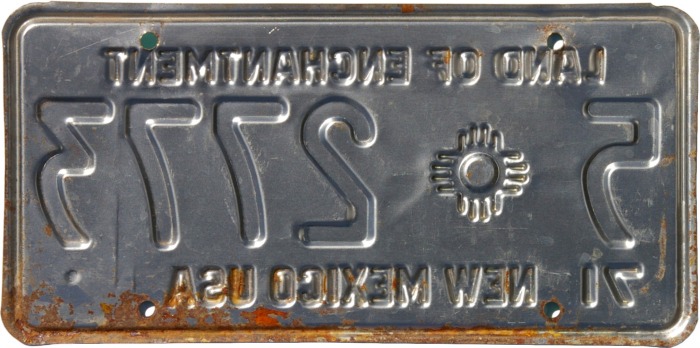
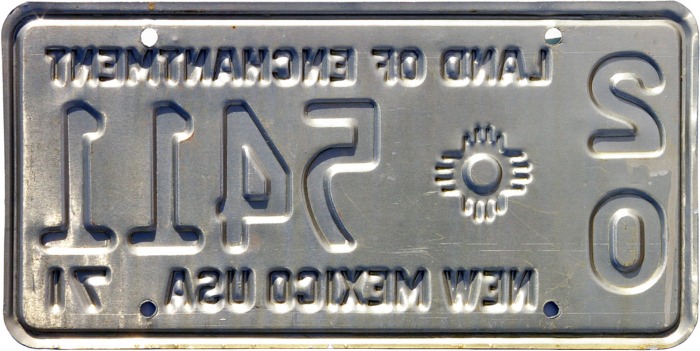
.JPG) |
| |
|
1971 base Truck plates,
which were used 1971-1974, were made of both steel and aluminum, with
the steel variety being by far the most common. |
| |
| |
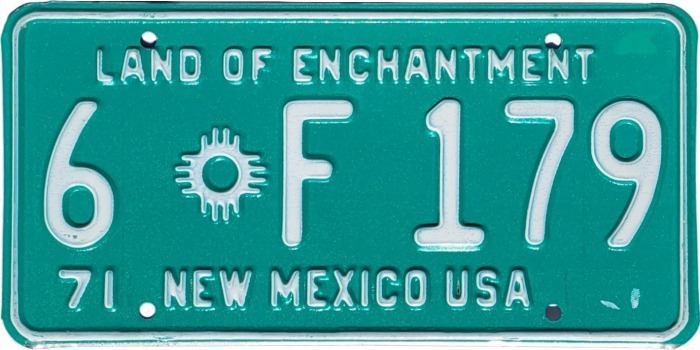
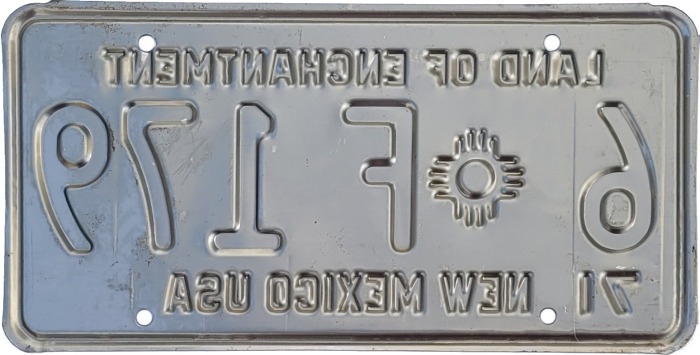
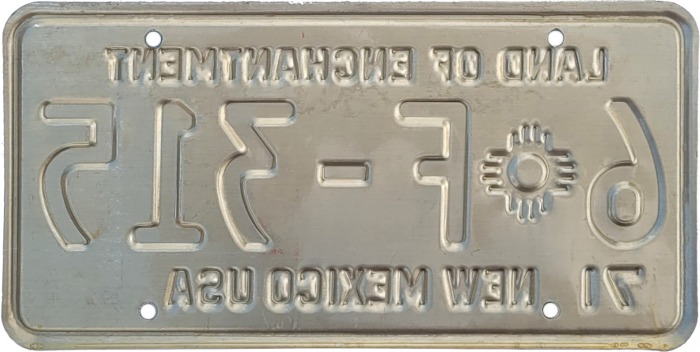
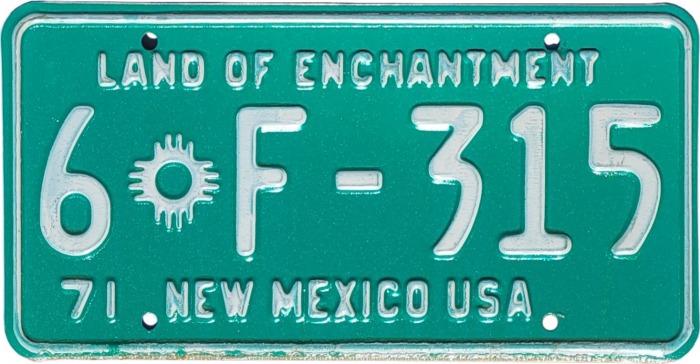
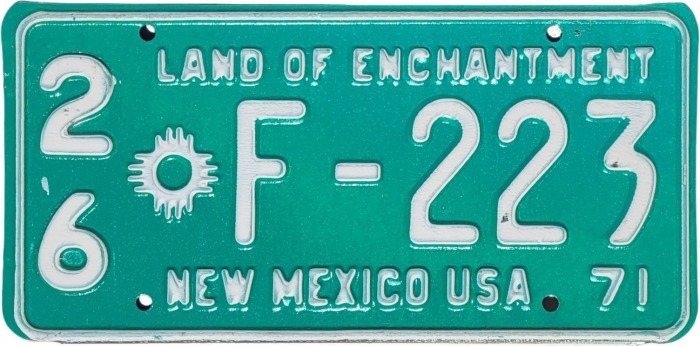 |
| |
| Some 1971 Farm Truck
plates have a blank space after the “F” while others have a hyphen.
Moreover, those with the blank space are made of steel and those with
the hyphen are made of aluminum. Whether this combination of
characteristics holds true for all Farm Truck plates is unknown, and is
it also unknown whether the addition of the hyphen was initiated at the
same time as the change in material. Note also that single digit county
number plates have the embossed “71” in the lower left corner, while
2-digit county number plates have the date in the lower right corner.
Having an embossed “71” in the lower right corner precludes that
location from being used for subsequent-year renewal stickers, but the
MVD planned for this by issuing long, narrow stickers in each of the
following three years, along with explicit instructions that they were
to be affixed in the unencumbered space immediately below the Zia
symbol. Many New Mexico motorists, however, either failed to read the
instructions, or simply ignored them, instead adhering the stickers
directly on the raised “71” numerals. All five photos above courtesy
Phil Hill. |
| |
| |
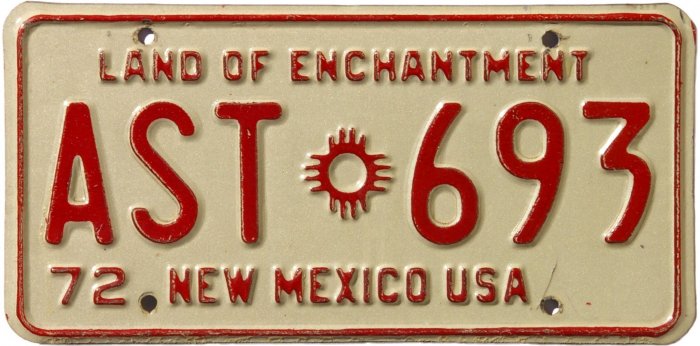
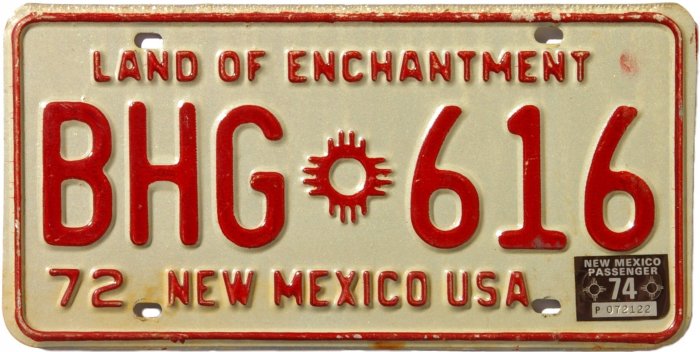 |
| |
|
1972 Passenger base plates were
produced with two different bolt hole shapes: round holes in the
earliest issues, oblong in the later issues. |
| |
| |
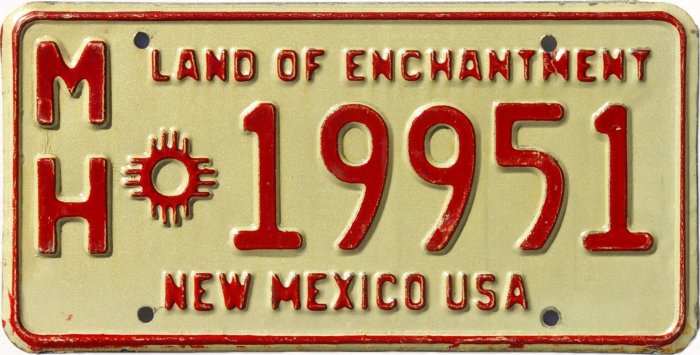
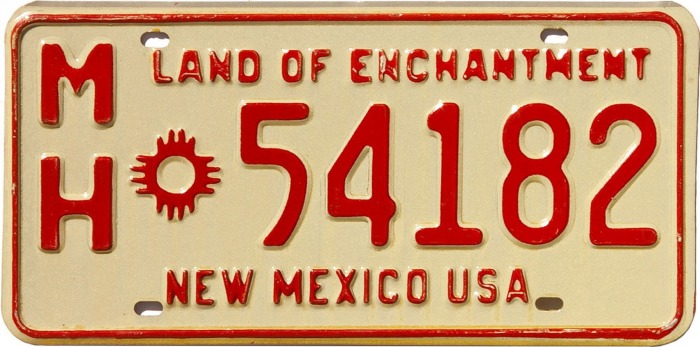 |
| |
| 1973 Mobile Home base plates
were produced with two different bolt hole shapes in the same manner as
were the 1972 base Passenger plates seen immediately above. Round holes
were used on the earliest issues, but within a year or so were
superseded by oval holes. |
| |
| |
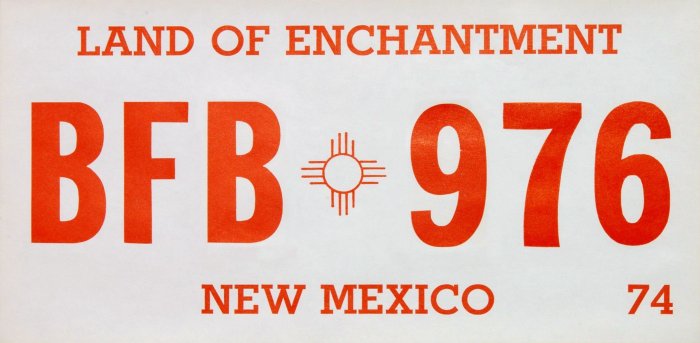
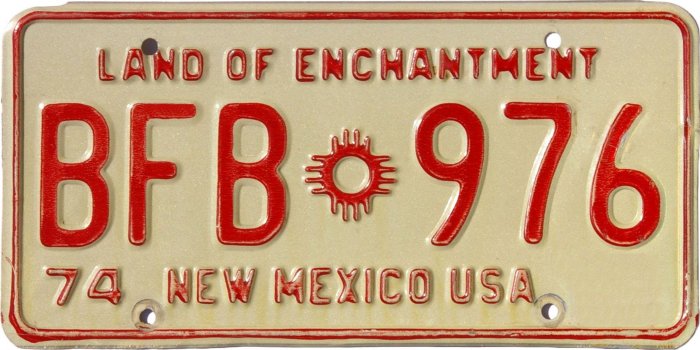 |
| |
|
During part of 1974 New Mexico suffered the embarrassment of having to
issue paper license plates, then replace them later with metal plates
bearing the same serial number. For more on this fiasco, see the page
on
Paper Plates. |
| |
|
| |
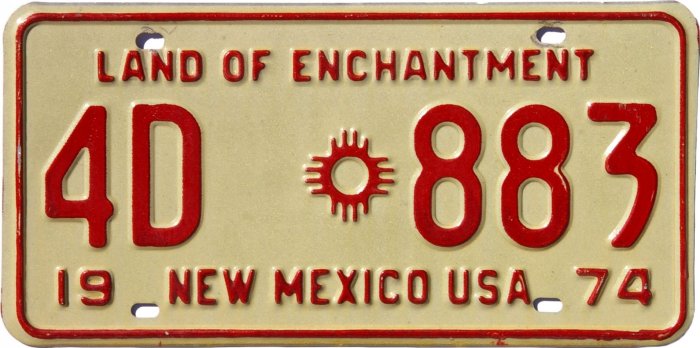
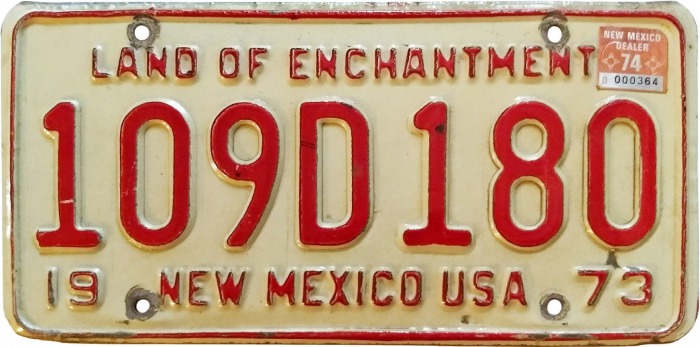 |
| |
| 1974 Dealer plates
– From roughly 1939 through 1974 the first plate a dealer received for a
given license year had a serial number consisting of the letter “D”
followed by a zia and the dealer’s current annual license number. If
more than one tag was bought by the same dealer, these were given a
sequential numeric prefix. The plate above at left is a typical such
example. Seen at right is a dealer plate whose dealer license number and
sequential plate prefix both had three digits, for a total of seven
characters counting the “D.” These seven characters having used up all
the available space, it was necessary to eliminate the zia from the
plate. This is the only circumstance reported where any dealer plate
from 1927 to 1998 did not have a zia. |
| |
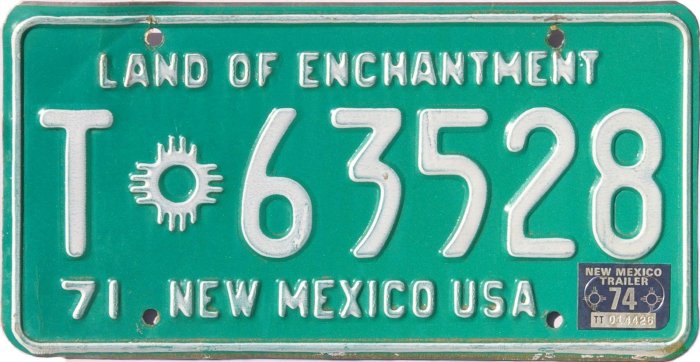
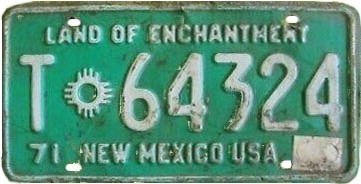
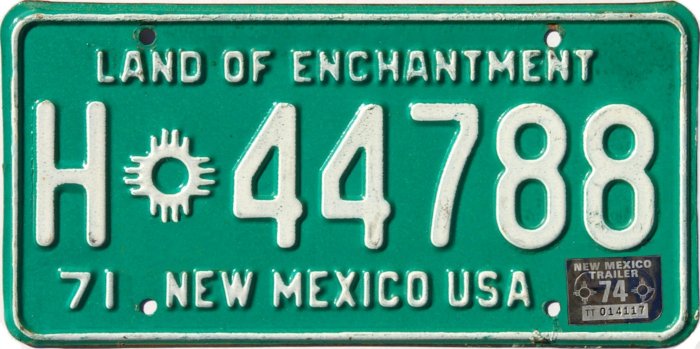
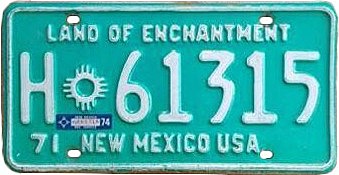 |
| |
| Late issue 1974 Trailer and
House Trailer plates, both on the 1971 base, were issued with
oval bolt holes instead of the earlier round bolt holes. It is possible
that this variation may exist on other late issue 1971 base
non-passenger plates as well, but as yet we have not seen any others. |
| |
| |
| |
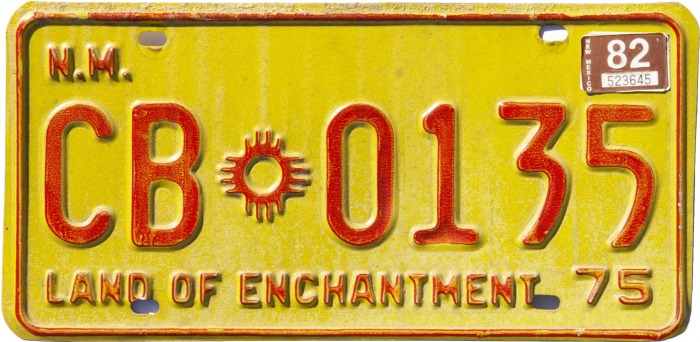 |
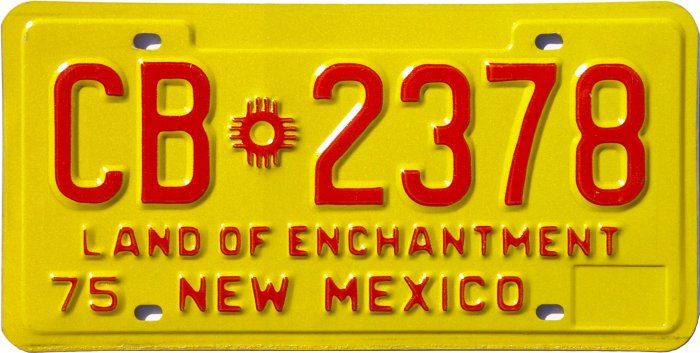 |
|
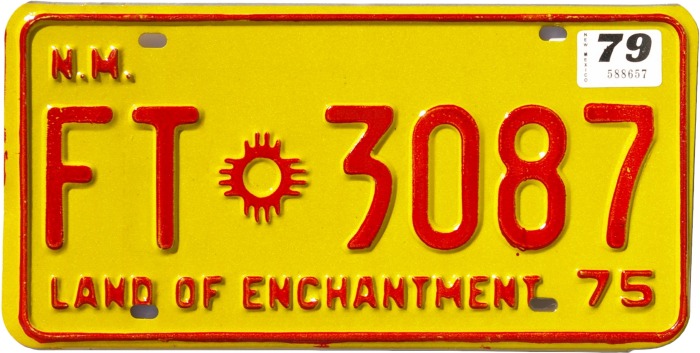 |
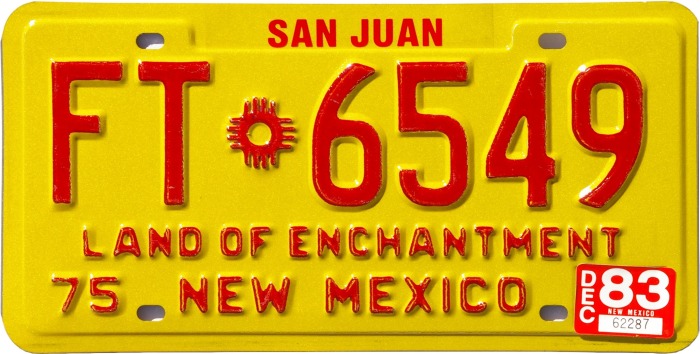 |
|
.JPG) |
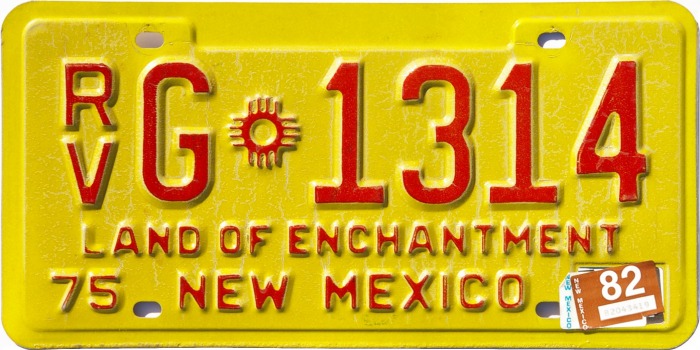 |
|
| |
Commercial Bus
CB-0001 - CB-1900
1,900 |
Commercial Bus
CB-1901 - CB-2400
500 |
|
Farm Truck
FT-0001 - FT-6000
6,000 |
Farm Truck
FT-6001 - FT-6900
900 |
|
Recreational Vehicle
RVA-0001 - RVF-9999
59,994 |
Recreational Vehicle
RVG-0001 - RVG-5000
5,000 |
|
| |
|
|
|
|
|
|
|
|
|
| |
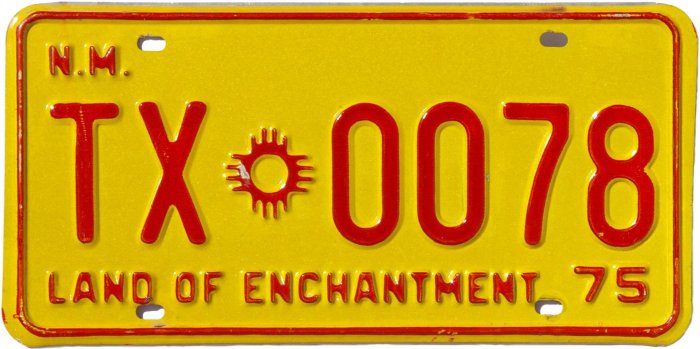 |
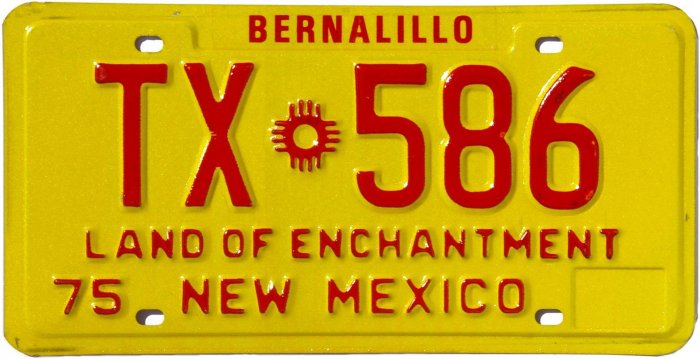 |
|
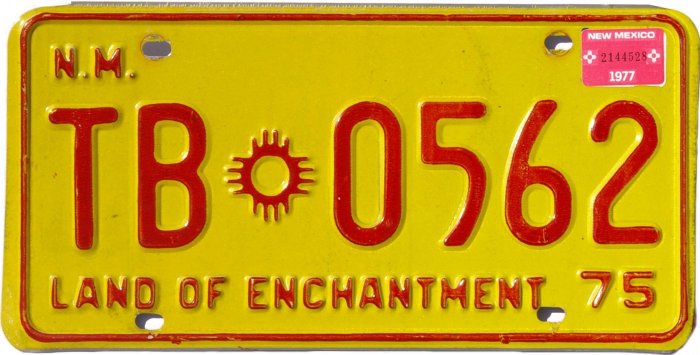 |
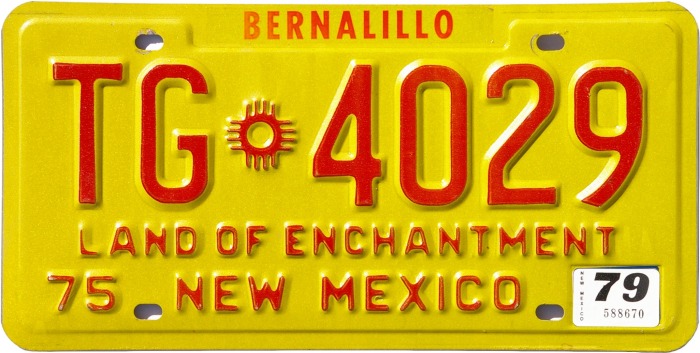 |
|
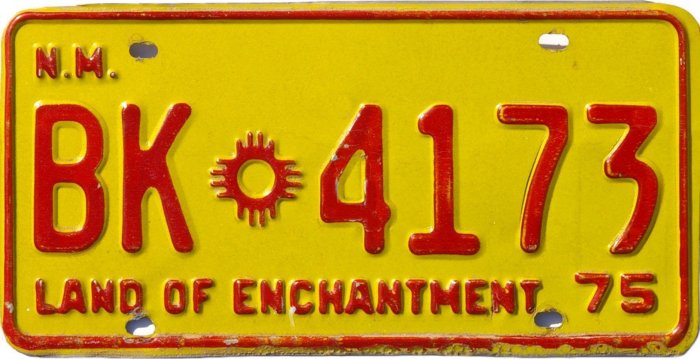 |
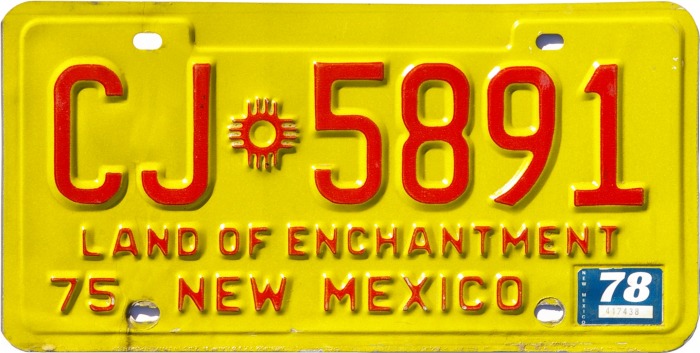 |
|
| |
Taxi
TX-0001 - TX-0500
500 |
Taxi
TX-501 - TX-650
150 |
|
Trailer
TA-0001 - TF-9999
59,994 |
Trailer
TG-0001 - TG-9999
9,999 |
|
Truck
AA-0001 - CA-5000
314,969 |
Truck
CA-5001 - CJ-9999
74,992 |
|
|
| |
| 1975 Non-Passenger Base
Plate Varieties. The
MVD publication New Mexico License Plates 1984 Edition shows
that there were two varieties of 1975 base plates made for at least six
different types of plates. One (the earlier) has an embossed “75” in the
lower right corner, and the other (the later) has the embossed “75” in
the lower left corner. The number under each serial number range
indicates the total number of plates issued of the corresponding
variety, taking into account that New Mexico is not known to have ever
used the letters I, O, Q, U or V on any plates other than Vanities, and
the fact that certain 2-letter prefixes on Truck plates are known and/or
believed to have been skipped within the serial number ranges shown. |
|
| |
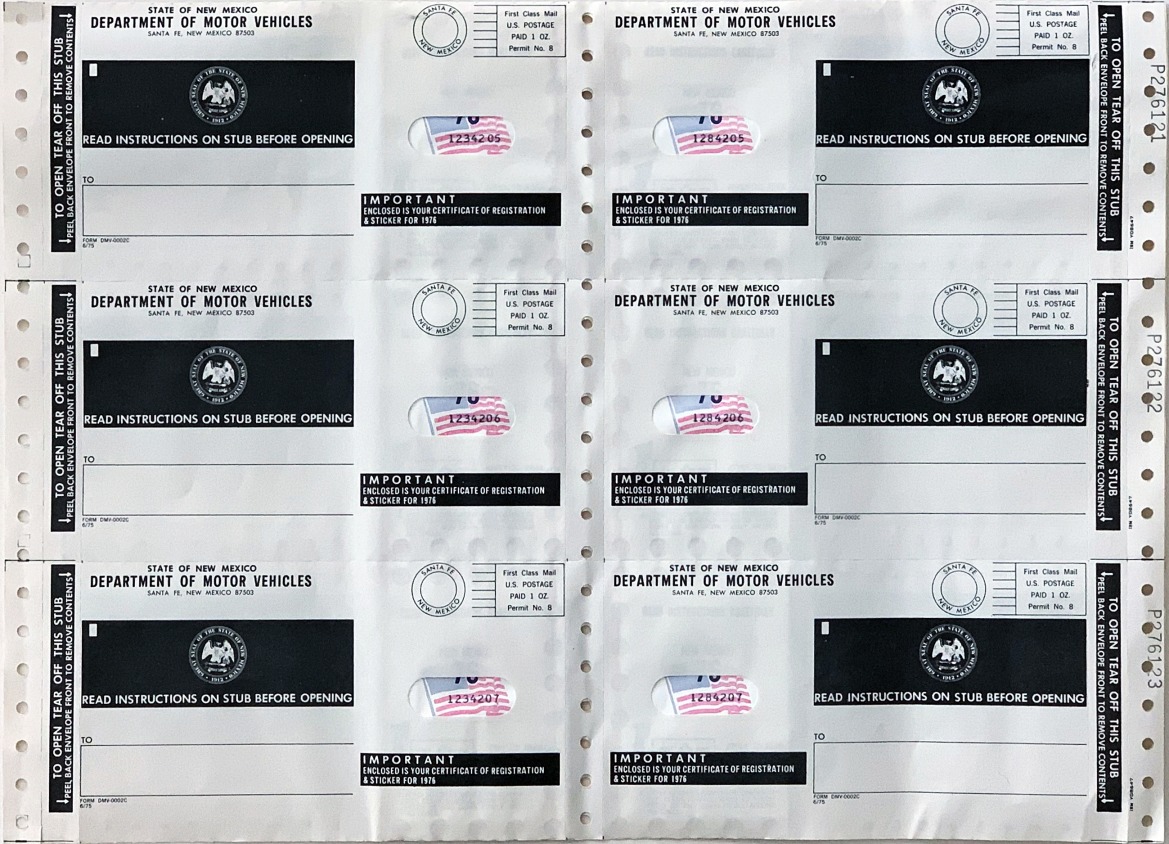 |
| |
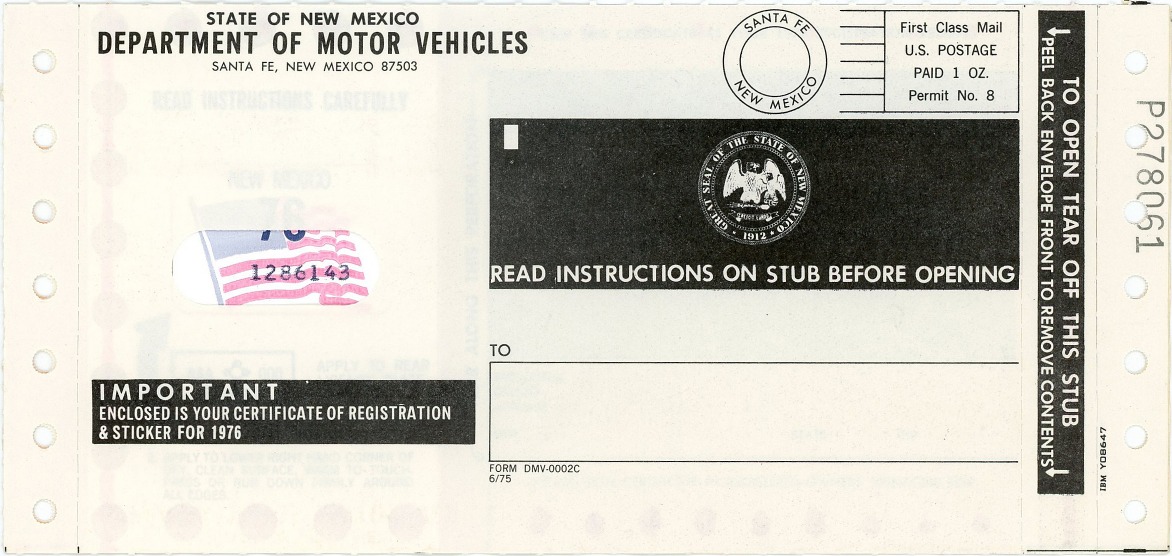
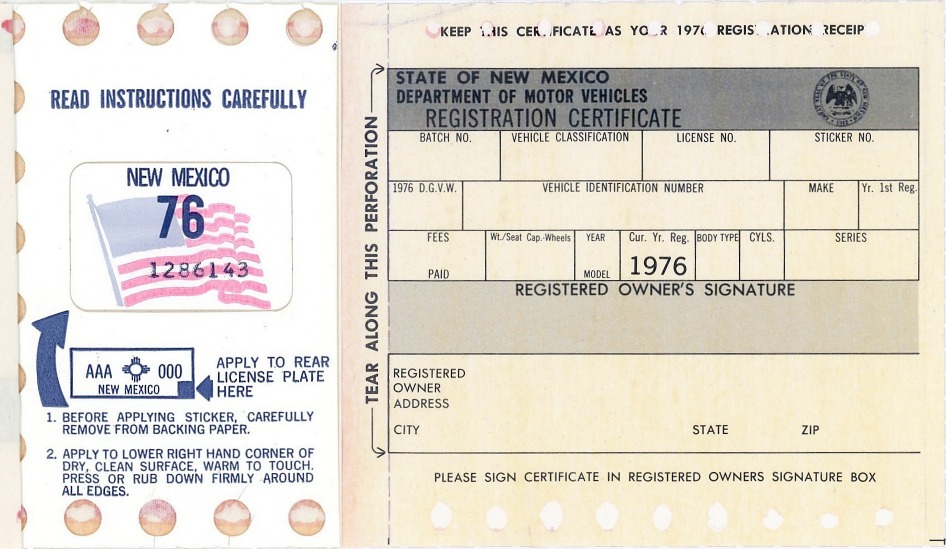 |
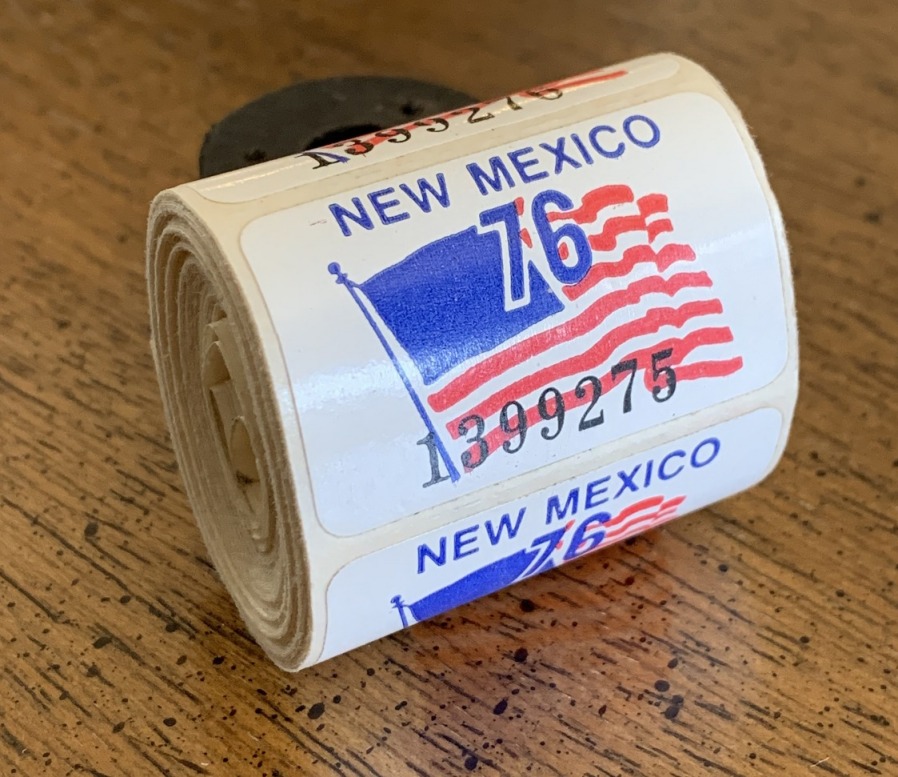 |
| |
| 1976 Car/Truck renewal/validation
stickers were issued in two distinct varieties, though with
similar U.S. flag designs. In the first of these, the red and blue
colors of the flag are somewhat muted. In the second variety the colors
are much bolder and brighter. Stickers of the first type with the
lighter colors were issued to persons using the renewal-by-mail option,
and were sent out from Santa Fe in computer-printed mailers containing
both the sticker and the registration certificate. The stickers with the
bolder colors were printed on perforated rolls, separate from the
registration certificate, and were issued only at DMV field offices
around the state. The computer-printed mailers were manufactured in
continuous 11" x 15⅛" fan-fold sheets of six individually perforated
mailers. (Being ¼" wider than the typical 11 x 14⅞" green-bar fan-fold
sheets used by most mainframe line printers in those days.) The sticker
serial numbers were added in a first pass through a line printer
(possibly at the manufacturing facility), with the name, address and
vehicle information printed by another line printer in the final step
before mailing from Santa Fe. Note that the serial numbers on the roll
stickers were printed differently, using an offset printing press. |
| |
| |
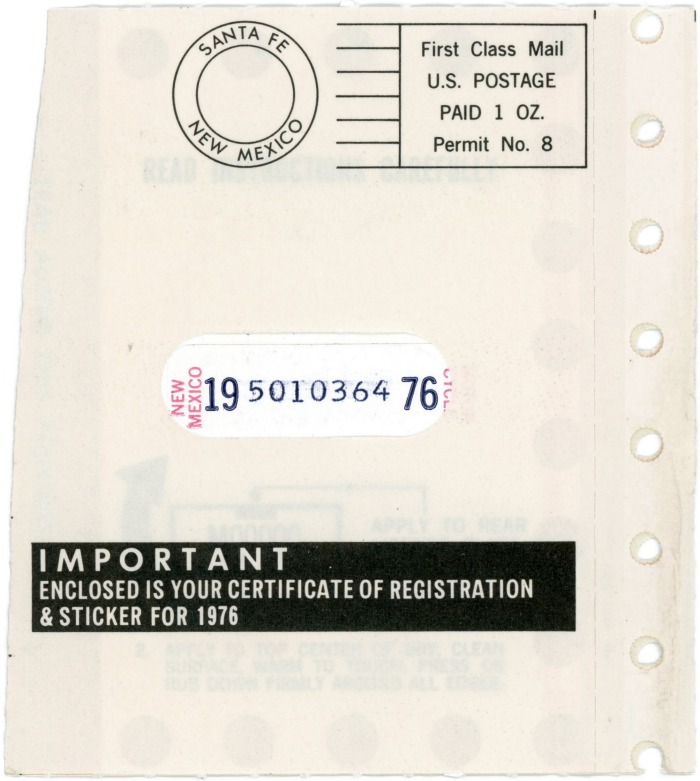
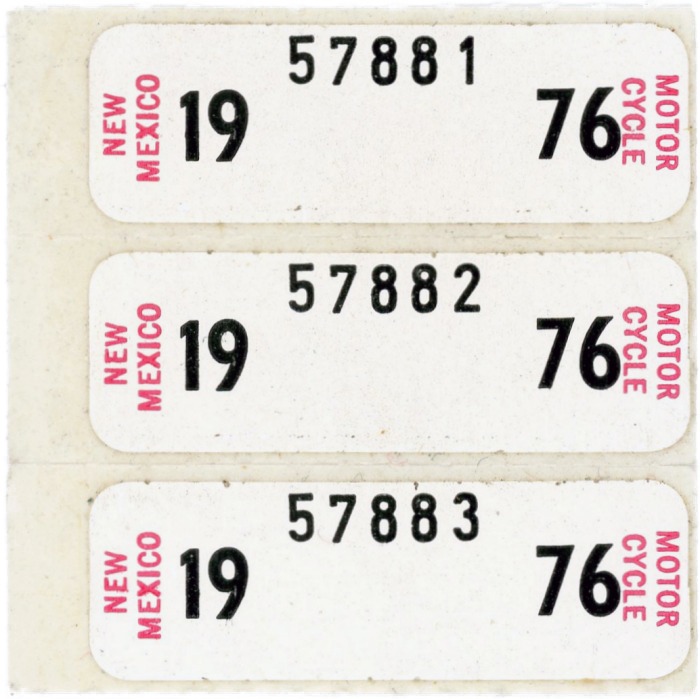 |
| |
| 1976 Motorcycle
renewal/validation stickers were issued in a manner essentially
identical to that used for the 1976 Car/Truck stickers shown immediately
above. That is, persons using the renewal-by-mail option received
mailers from Santa Fe containing both the sticker and the registration
certificate. (In the example shown here, most of the certificate side of
the mailer has unfortunately been cut off by someone with a pair of
scissors.) Those who registered at DMV field offices received stickers
that came from perforated strips. And again, the serial numbers in the
mailers were printed by a line printer, while stickers on the strips
were printed by the offset method. |
| |
| |
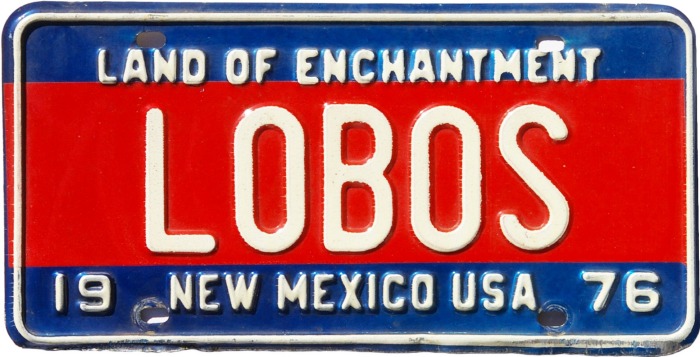
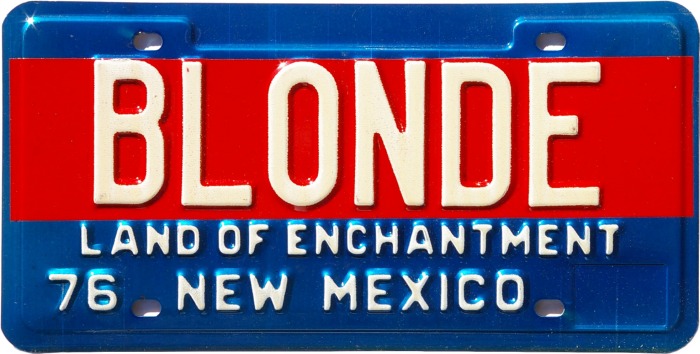
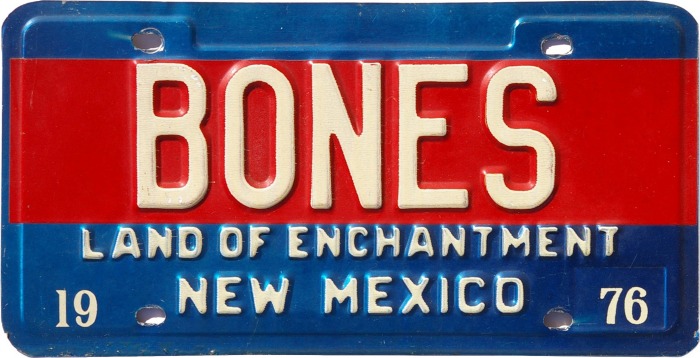 |
| |
1976 Vanity plates
were made in three distinct varieties. The two at left are both
relatively common. The third variety, at far right, which has the date
silk screened rather than embossed, is quite rare.
|
|
| |
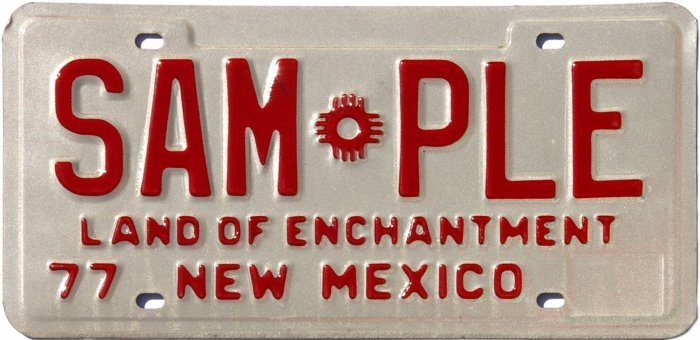
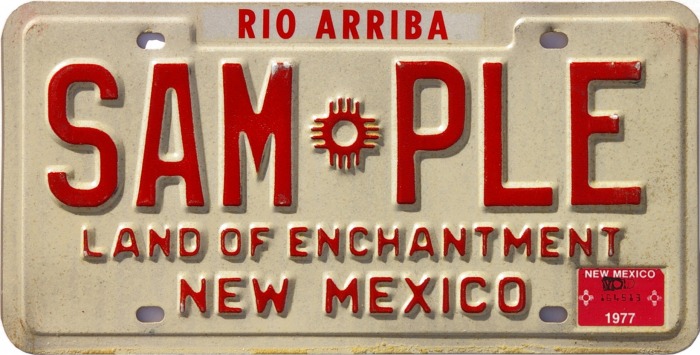 |
| |
| 1977 Sample plates
were distributed both with an embossed “77” and as an undated plate
bearing a voided 1977 sticker. |
| |
| |
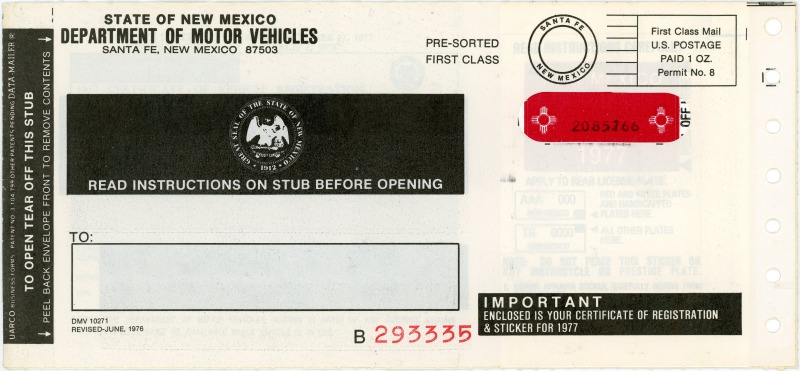
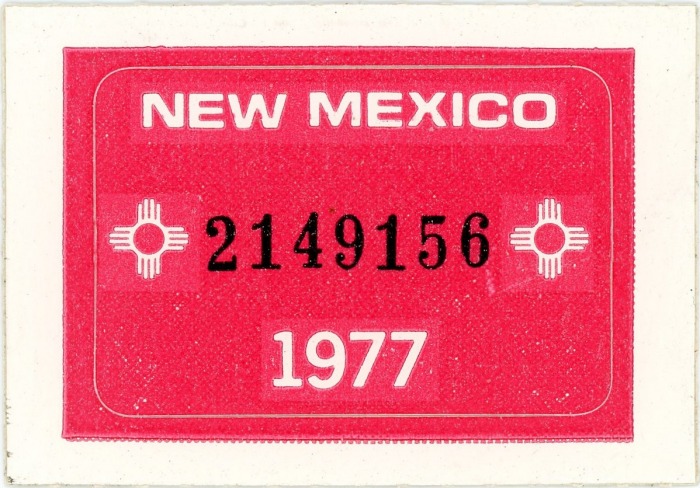 |
| |
| 1977 Car/Truck
renewal/validation stickers carried forward the procedure used
in 1976 (see above), wherein persons using the renewal-by-mail option
received mailers from Santa Fe containing both the sticker and the
registration certificate. Those who registered at DMV field offices
received stickers that came from perforated strips. And as in the prior
year, the serial numbers in the mailers were printed by a line printer,
while stickers on the strips were printed by the offset method. |
| |
| |
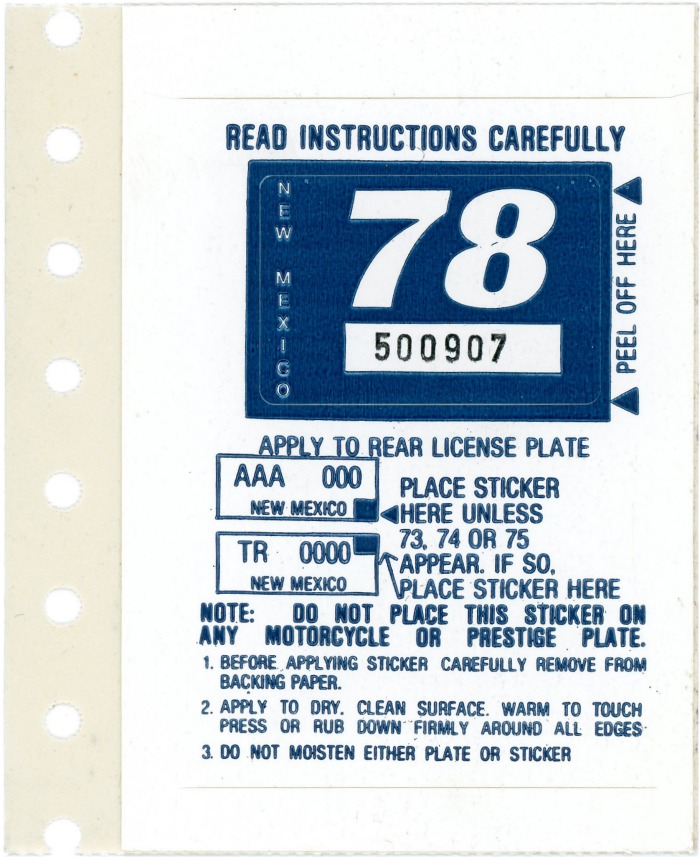
.jpg) |
| |
| 1978 Car/Truck
renewal/validation stickers were issued in two different forms,
though it is not known with certainty if these were issued in the same
way as in 1976 and 1977 (see above). However, the variety shown here
with the sprocket feed holes and detailed application instructions is
quite similar to those within the mailers sent out from Santa Fe in 1976
and 1977, and it appears likely that the one shown here was removed from
a comparable type of mailer used in 1978. The other style, without
sprocket holes or detailed instructions, is known to have been prepared
in both perforated rolls of 500 and perforated flat strips of unknown
quantity. Both varieties of the 1978 stickers appear to have had their
serial numbers printed by the offset method. |
| |
| |
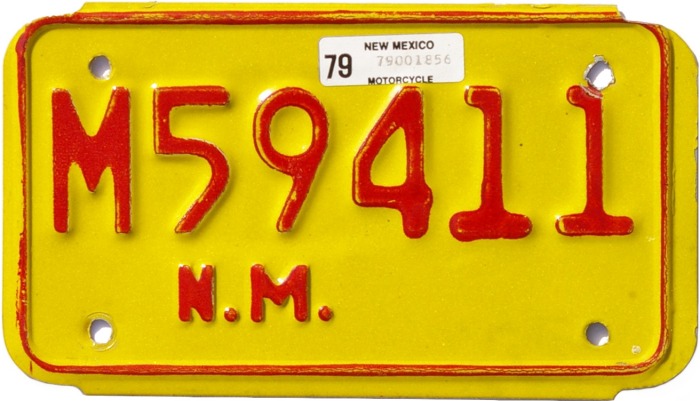
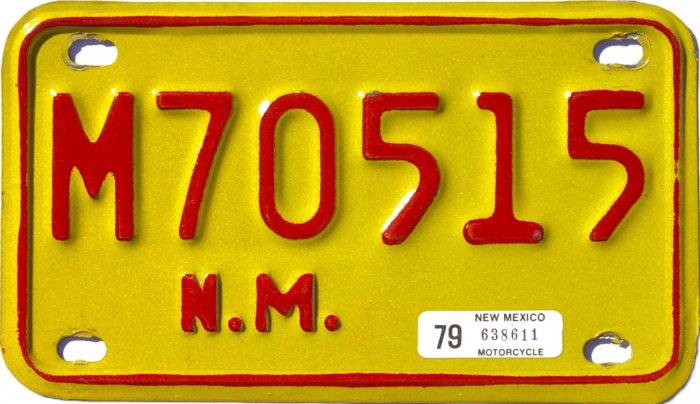
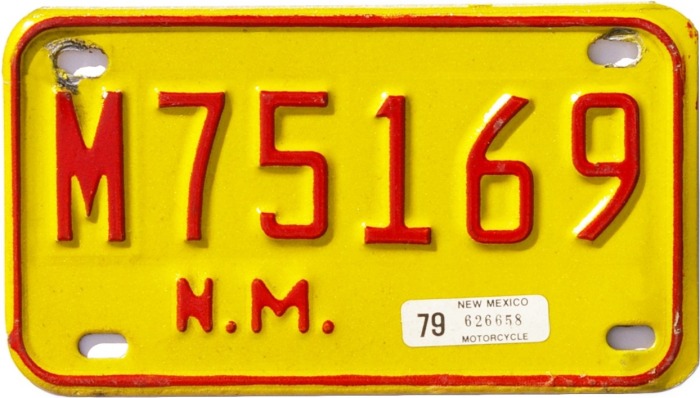
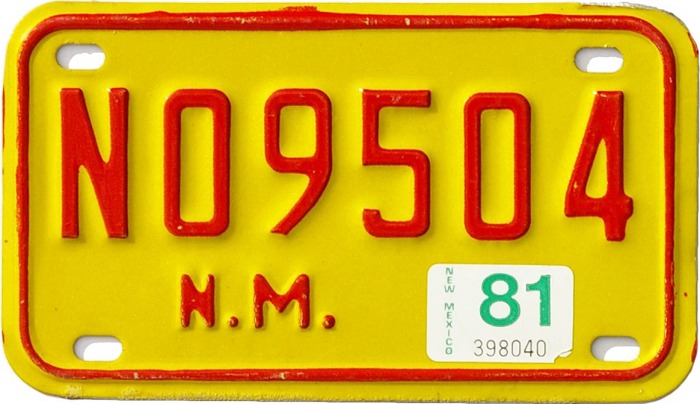 |
| |
| 1978-1982 undated Motorcycle
base plate varieties. In late 1978 an undated Motorcycle base
plate was introduced to replace the dated 1975 base that had been in use
for about four years. These were initially produced with round bolt
holes and a protrusion (called a "fin" or "flash") along both the top
and bottom edges. Not long thereafter, probably in early 1979, a change
was made to oval bolt holes, and the fins were eliminated. Later in 1979
yet another change was made where the oval holes were retained, but new,
more squarish and boldly struck dies were put into use. This brought to
three the number of varieties found during the first two years of the
four years this base plate was in use. In 1981, as the serial numbers
with the “M” prefix were nearing exhaustion, the “M” was replaced by
“N,” but still using the third base plate variety described above. If
one wishes to consider the change in prefix yet another variety, then we
have a total of four varieties. |
|
| |
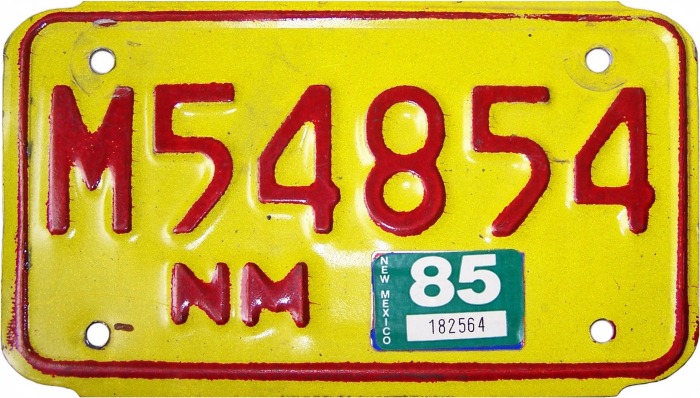
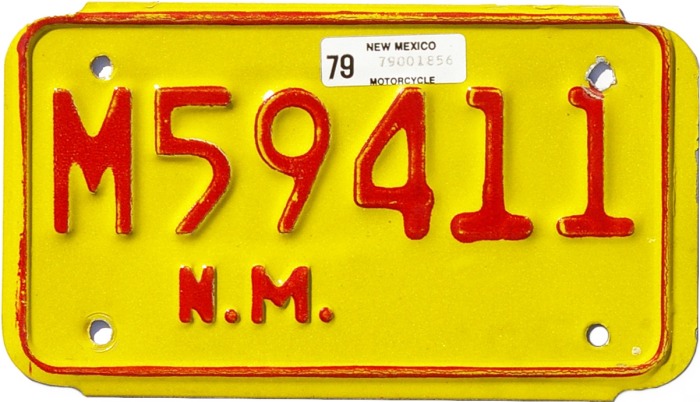 |
| |
1978 base Motorcycle plates.
The switch from the embossed 1975 date motorcycle base plates, to the
undated 1978 base motorcycle plates occurred somewhere around serial
number M50000. An apparently small number of the latter, in the 54000
series, were made without periods in the state name abbreviation, i.e.,
appearing as “NM” rather than “N.M.” Photo of M54854 courtesy Karl
Franklin.
|
| |
| |
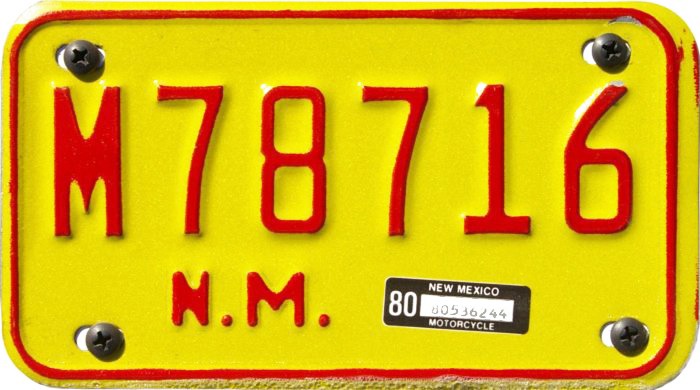
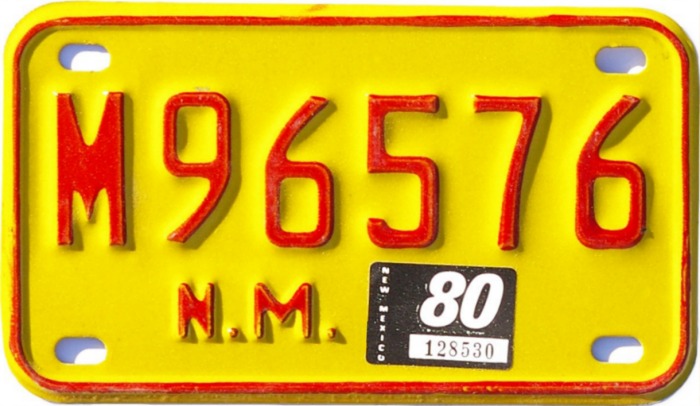 |
| |
| 1980 Motorcycle validation
stickers. All of the Motorcycle validation/renewal stickers
used prior to 1980 were purpose-made as long, narrow stickers that would
fit in the limited available space on these small plates. The same was
true in the first half of 1980. But beginning July 1, 1980, cycle plates
began to be issued the same (larger) stickers as were used on cars and
trucks. This had become possible by virtue of the fact that beginning in
1979, motorcycle plates have been made as undated base plates with
sufficient unobstructed space for full size stickers. The result is that
1980 Motorcycle tags are found in two varieties, differentiated by the
size and shape of the sticker, with the earlier (smaller) sticker being
the most commonly found. |
| |
| |
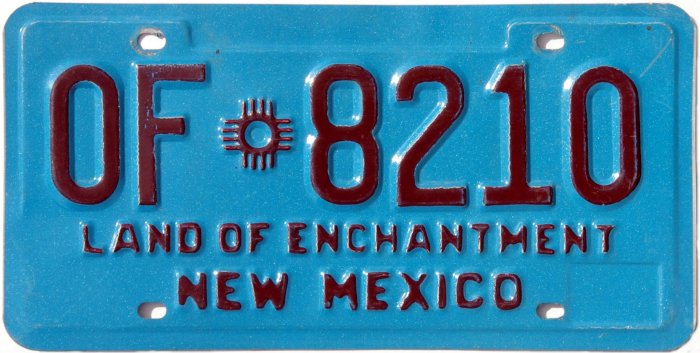
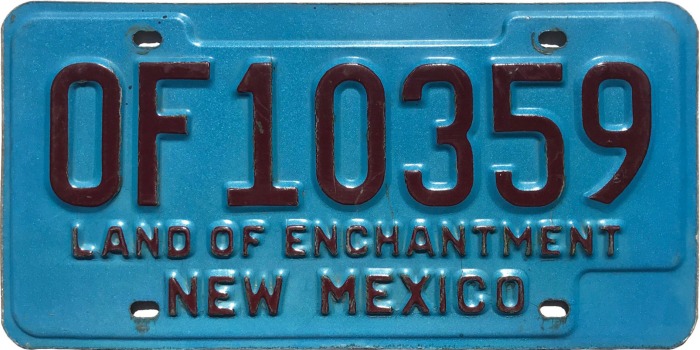 |
| |
| 1980s Official
plates were made both with and without the Zia. The latter came
about when the serial numbers reached 10000, necessitating the
elimination of the Zia to make room for the fifth digit. |
|
| |
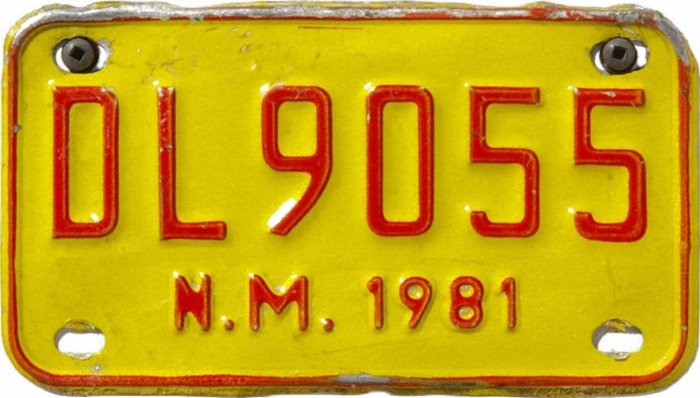
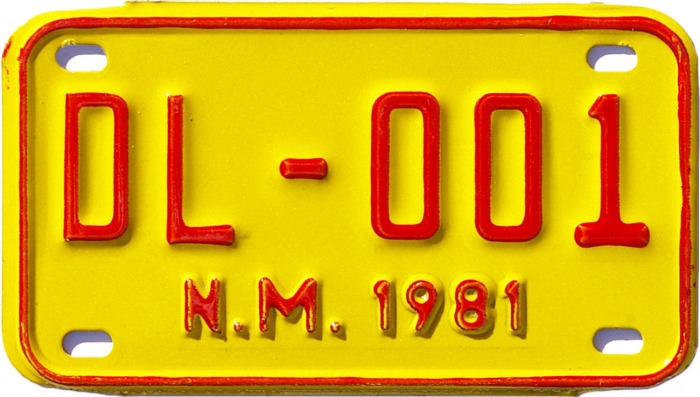 |
| |
| Motorcycle Dealer 1981.
Prior to 1975, Motorcycle Dealer plates used the same serial
number pattern as automobile Dealer plates, both beginning with serial
D-1. In other words, the serial numbers were duplicated between the two
types. With the general reissue and redesign of all non-passenger plates
in 1975, the “D” prefix on both of these types was changed to “DL.”
Moreover, to eliminate the serial number duplication, Motorcycle Dealer
plates were numbered beginning with DL5001, while automobile Dealer
plates were numbered beginning with DL-0001. In 1977 Motorcycle Dealer
serials were further separated by beginning them at DL9001, a format
that continued at least through 1982. Notwithstanding this change, at
least one Motorcycle Dealer plate from 1981 is known which does not
conform to either the earlier or the later pattern, having the serial
DL-001. |
| |
| |
.JPG)
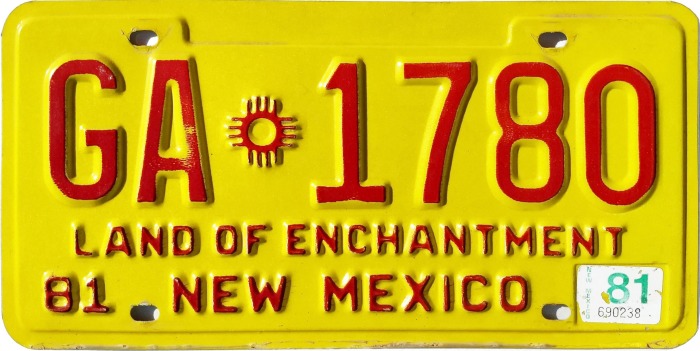
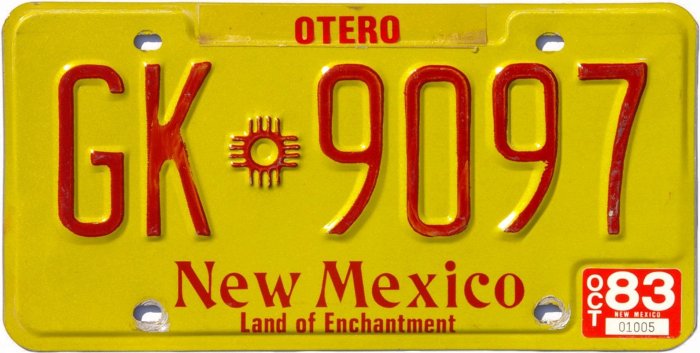 |
| |
| 1981 Truck plate with
embossed date. New Mexico had already abandoned embossed dates
on standard Truck plates after 1975 when an unknown number of Truck tags
were made with an embossed “81” date just prior to the introduction of
the graphic style plate in 1982 (for 1983 expirations), the latter
beginning with serial GE-0001. The embossed “81” is not described in the
MVD publication New Mexico License Plates 1984 Edition. |
|
| |
.JPG)
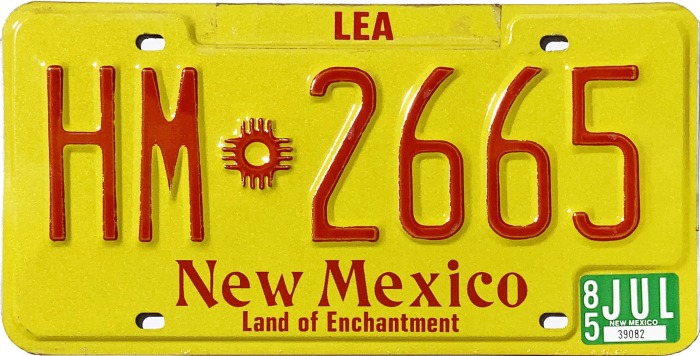 |
| |
| 1985 Truck plates
in the HM serial number sequence are found with the “M” embossed by
using an upside down “W” on some plates. |
| |
| |
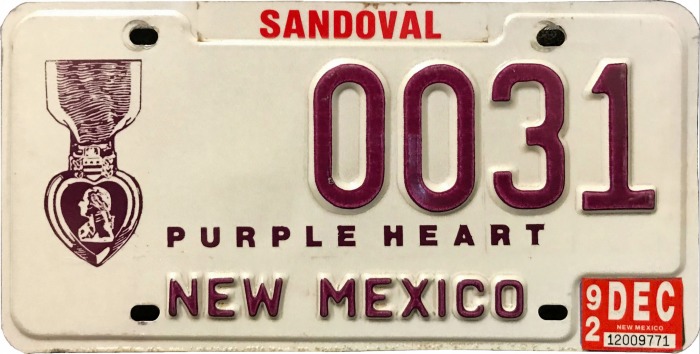
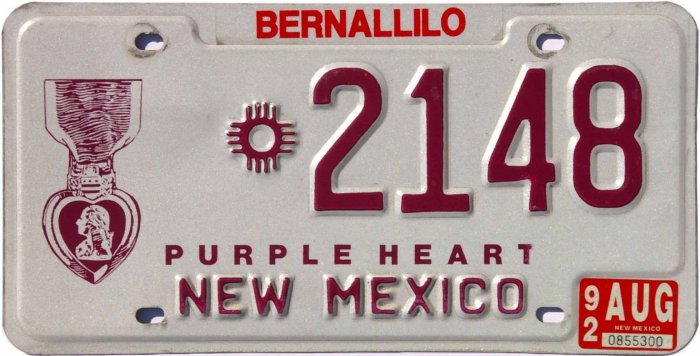 |
| |
| Type 1 Purple Heart
plates, initially released in about 1990 with mostly 1991 expirations,
are known to have been made both with and without a zia symbol. |
| |
| |
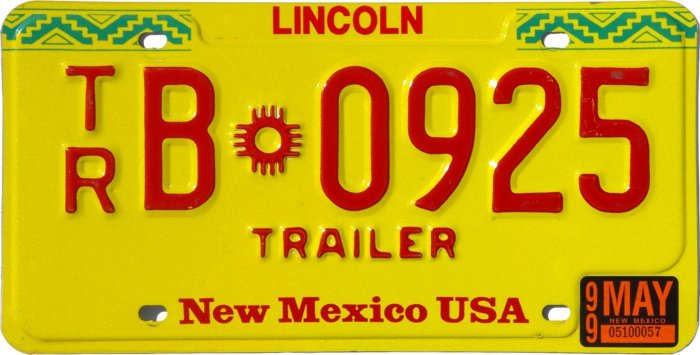
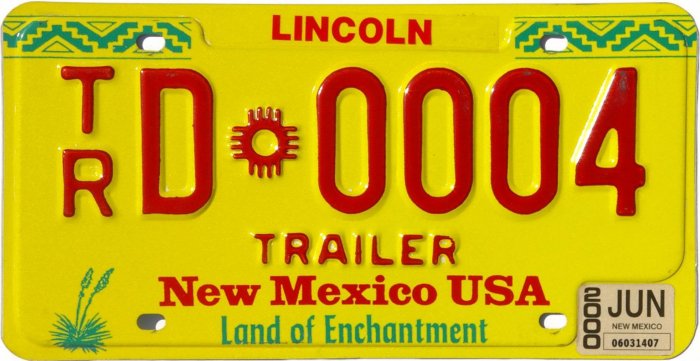 |
| |
| Yellow Trailer plate varieties.
When the “yucca” Passenger plate design was released in the beginning of
the 1990s, the same new Passenger base plates were initially also used
for Trailer plates. Within a year or so, however, a new style of Trailer
plate was introduced on which the embossed word “TRAILER” appeared. In
order to provide adequate space for this embossed word the turquoise
yucca and “Land of Enchantment” slogan were eliminated, and “New Mexico
USA” was made smaller and moved to the bottom of the plate, creating
what is sometimes called the “yellow trailer base.” Nonetheless, an
unknown number of trailer plates of this era were also made on the
Passenger base. Examples of both are shown here. |
| |
| |
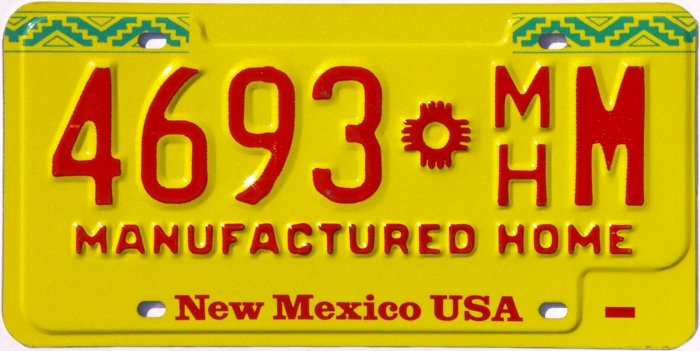
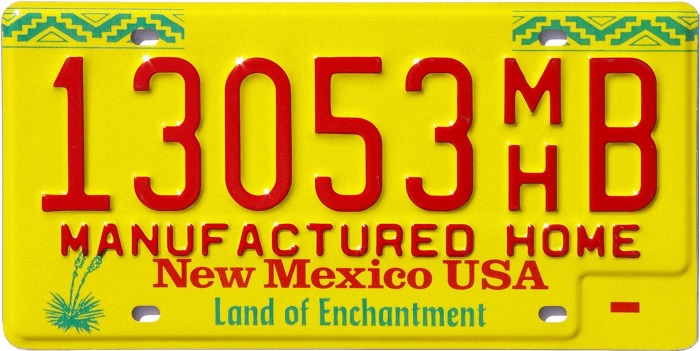 |
| |
| Yellow Manufactured Home plate
varieties. In a manner similar to Trailer plates in the
early 1990s, the embossed words “Manufactured Home” were added to plates
of this type. These were also made on the special “yellow trailer base”
in order to accommodate the added embossed designation (see details in
“Yellow Trailer plate varieties,” above). But just as happened with
Trailer plates, some Manufactured Home plates were made on Passenger
base plates. Note that the variety on
the passenger plate base is also lacking the county name sticker box at
the top of the plate. |
|
| |
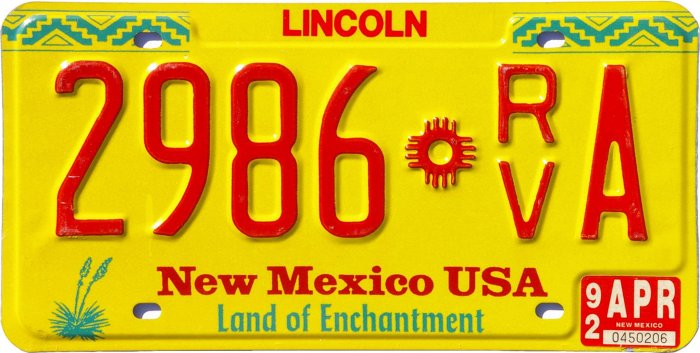
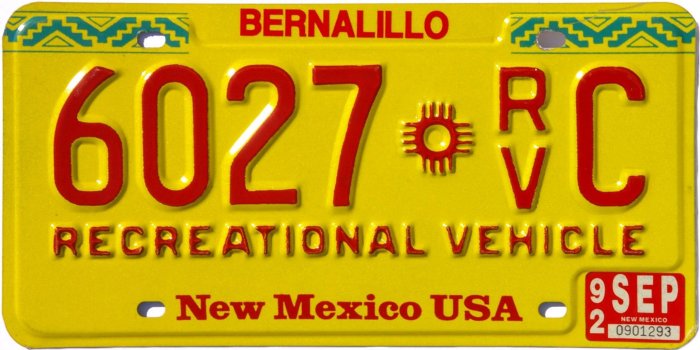 |
| |
| Over the years Recreational Vehicle
tags have been produced in more than a dozen styles. During the
changeover periods it has sometimes been the case that two styles have
been issued simultaneously, with the result that these are considered by
some to be separate varieties for that same year. The 1992 plates
illustrated here are one such example. |
| |
| |
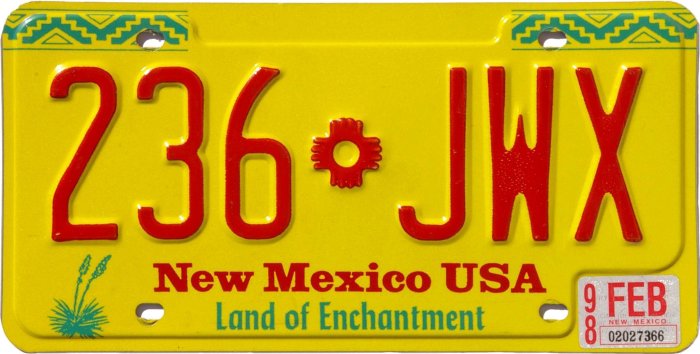
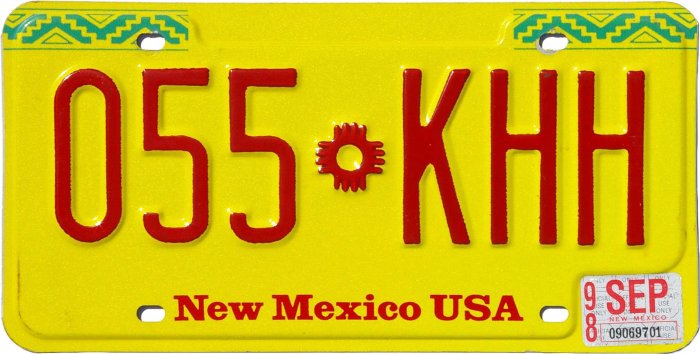 |
| |
| In 1997, thousands of passenger car plates were
made (for 1998 expirations) with the graphic sheeting that had been
designed for the trailer plates, but without the embossing of the word
“TRAILER.” These included plates in the 001-KFH to 999-KGC and the
001-KGN to 999-KHM series, but whether this was done in error or because
the supply of passenger car style reflective sheeting had been
temporarily exhausted is unknown. |
| |
| |
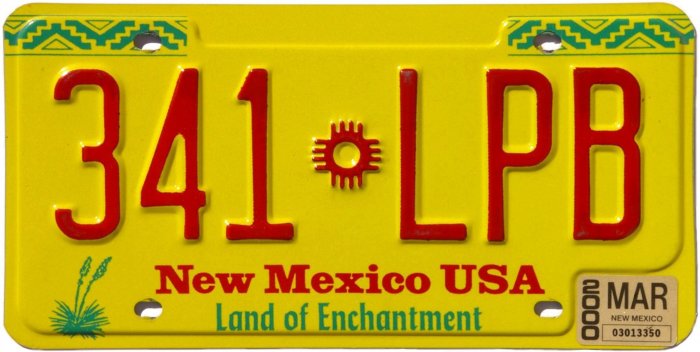
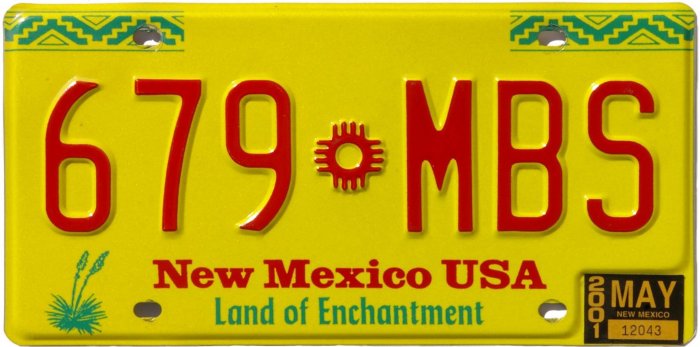 |
| |
| Yucca plates with and without county
name sticker box. The yellow yucca Passenger plates were made
both with and without the county name sticker box. This apparently was a
permanent change that was made in about 2001. |
|
| |
.JPG)
.jpg) |
| |
| Balloon style Apportioned
plates were produced both with and without an alpha character
in the serial number. |
| |
| |
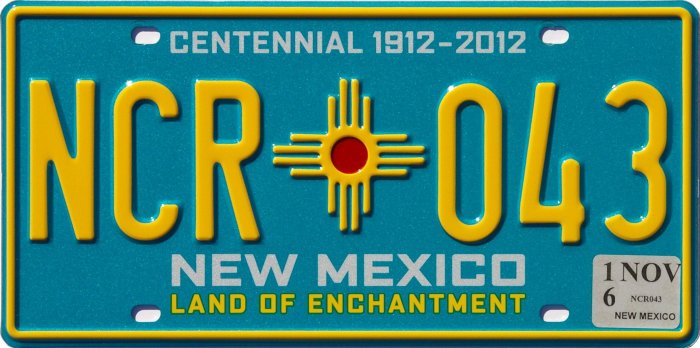
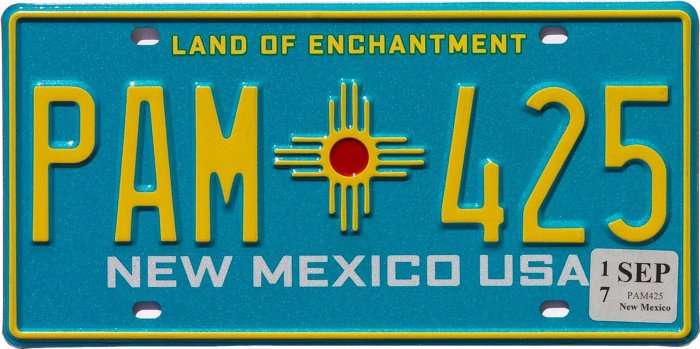 |
| |
|
New Mexico began issuing its turquoise
statehood centennial plates in 2010, with most of these having initial
expirations in 2011. By 2016 the “Centennial 1912-2012” slogan was no
longer timely so it was removed, and the “Land of Enchantment” slogan
was moved up from the bottom of the plate to replace it. The majority
of these new variety plates, of course, have initial expirations in
2017. |
| |
| |
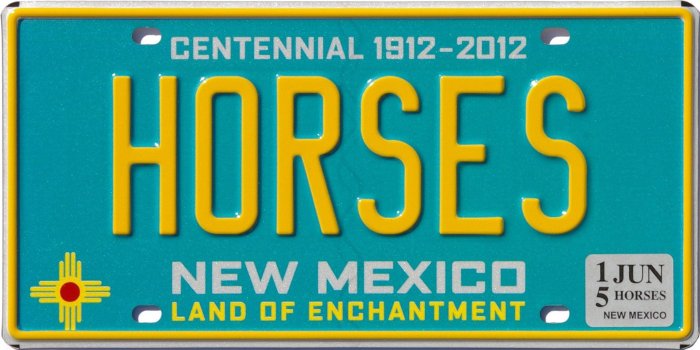
.JPG)
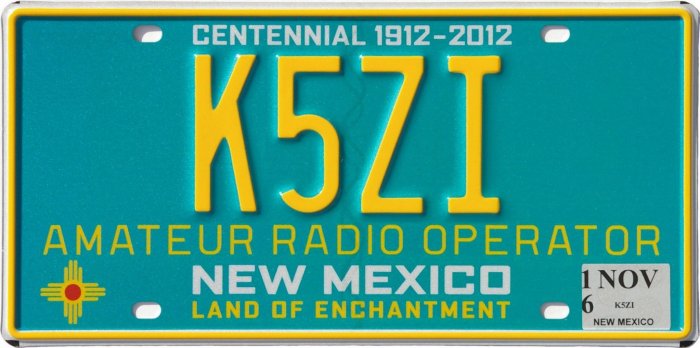
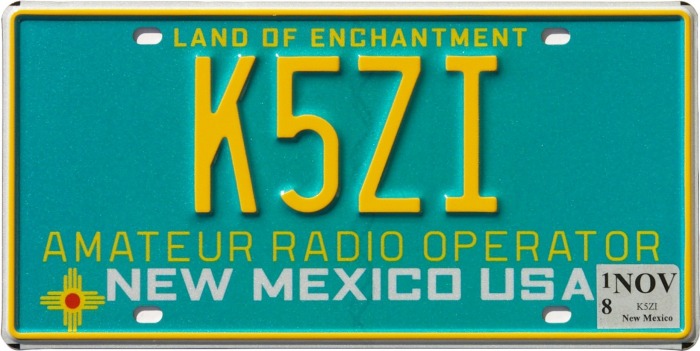 |
| |
| The "Centennial" slogan was dropped
from turquoise Vanity and Amateur Radio plates for the same reason as it was on the
regular Passenger plates described immediately above. |
| |
| |
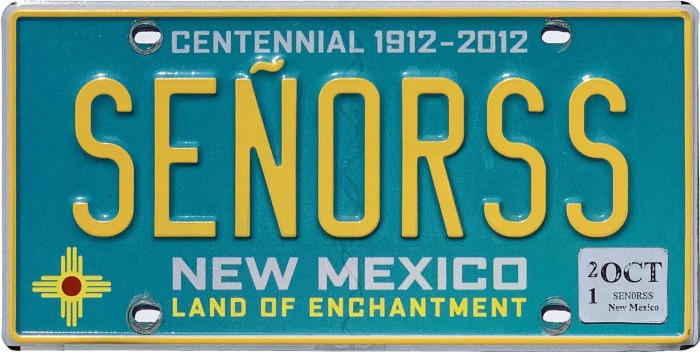 |
| |
| This is reportedly the only
turquoise plate ever issued with the Spanish Ñ. If you know of others,
please contact us with
details, and include a photo. |
| |
| |
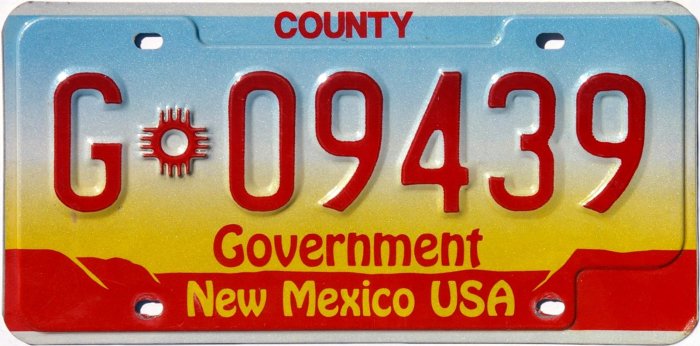
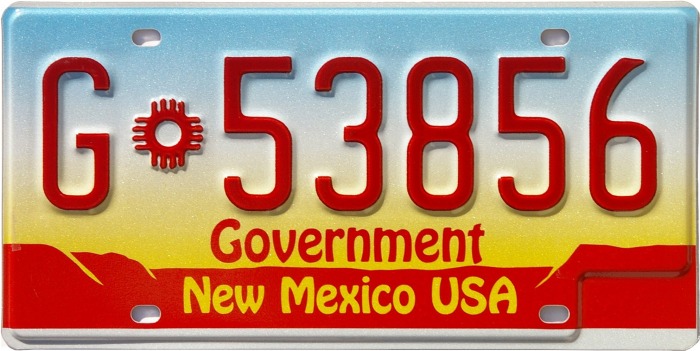 |
| |
| New Mexico Government
(Official) plates from the 1990s were made both with and
without the county name sticker box. On official plates the sticker box
was seldom used, but they are occasionally found with stickers bearing
either the county name, or the word “MUNICIPALITY” or “COUNTY.” |
| |
| |

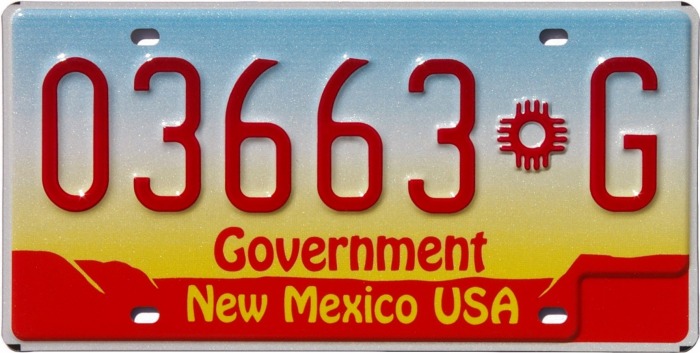 |
| |
| New Mexico Government
(Official) plates from the 1990s through the 2010s used the “G” as a
prefix, but beginning about the middle of 2017 the “G” became a suffix. |
| |
| |
| |
| Photo Credits: 1917 #972, 1963
#2-A2181, 1964 #2-K-212, and 1980s Official #OF10359 courtesy of Jim
Gummoe. 1917 #12839 and 1919 #13806 courtesy Barry Deutsch. 1926
stamped tab courtesy Phil Hill. 1932
Motorcycle #M219, 1946 Truck
#30947 and 1953 Truck #9-1015 courtesy Michael Breeding. 1942 #48-000,
1942 #101391, 1949 #7-7915, and 1952 #7-10466 courtesy Greg Gibson,
1952 #2-50010 courtesy George Sammeth, 1955 Motorcycle #M4497 by Michael
Breeding, 1974 Dealer plate #109D180, 1981 Truck #GA-1780 courtesy Robert McArthur,
1992 Purple Heart #0031 courtesy Brian Drake, 2008 Apportioned #IRG8920
courtesy Jim Moini.. All others by
Bill Johnston. |
| |




























.jpg)



























.jpg)




.jpg)